Whom We Worship
We Worship Gucheon Sangje, the Highest Celestial Deity
and Supreme God of the Ninth Heaven
Who Exercises Absolute Authority over the Universe
The Supreme God’s Descent into the Human World
The object of belief in Daesoon Jinrihoe is the Supreme God of the Ninth Heaven (Gucheon Sangje), who is the highest celestial deity and exercises supreme authority over the universe. He made a ‘Great Itineration’ around the world in response to the petition and request of all divine sages, buddhas and bodhisattvas, who have existed since the dawn of time.
Stopping on this eastern land of Korea, He spiritually resided in the statue of Golden Maitreya Buddha in the Geumsansa Temple at Moak Mountain in North Jeolla Province where He stayed for thirty years.
On September 19, 1871, He was born as a human being to the Kang family in North Jeolla Province. His honorific name was Jeungsan. The Supreme God (Sangje) Kang Jeungsan proclaimed the unprecedented truth to the human world throughout His 40 years of life which He committed to ‘Reordering Works of Heaven and Earth’ and ‘Opening a New World.’ Then He passed into heaven and ascended to the throne of ‘Gucheon Eungwon Noeseong Bohwa Cheonjon Kangseong Sangje,’ as the Supreme God.
Stopping on this eastern land of Korea, He spiritually resided in the statue of Golden Maitreya Buddha in the Geumsansa Temple at Moak Mountain in North Jeolla Province where He stayed for thirty years.
On September 19, 1871, He was born as a human being to the Kang family in North Jeolla Province. His honorific name was Jeungsan. The Supreme God (Sangje) Kang Jeungsan proclaimed the unprecedented truth to the human world throughout His 40 years of life which He committed to ‘Reordering Works of Heaven and Earth’ and ‘Opening a New World.’ Then He passed into heaven and ascended to the throne of ‘Gucheon Eungwon Noeseong Bohwa Cheonjon Kangseong Sangje,’ as the Supreme God.
Gucheon Eungwon Noeseong Bohwa Cheonjon Kangseong Sangje
(Gucheon Sangje)
Gucheon (九天, Ninth Heaven) is the highest location of all, a post from which Sangje supervises the Three Realms, coordinates Heaven and Earth, and directs the process of their unfolding.
Eungwon (應元, Resonation with the Supreme) indicates that none of the myriad forms dense or close, including heavenly bodies, would be able to come into being without having the sympathetic resonance of a heavenly mandate.
Noeseong (雷聲, ‘Lighting and Thunder’/Thunderbolt) symbolizes the command of Heaven and voice of benevolence. Lightning is created by the two vital forces of yin and yang. Lightning is the essence (che, 體) of thunder, and thunder is the function (yong, 用) of lightning. The thunderbolt divides Heaven from Earth. The thunderbolt causes the energy of Heaven and Earth to ascend and descend through the oscillation between movement and stillness, advance and retreat, enables everything grow, and it controls the becoming and changing of everything in Creation.
Bohwa (普化, Universal Creation) signifies that every being in the universe owes its existence, whether via form or formlessness, to the creative virtue of the Celestial Worthy.
Cheonjon (天尊, Celestial Worthy) indicates that Sangje is the holiest and greatest deity throughout the Three Realms, who universally creates every being through His thunderbolt throughout all directions in space and time.
Kangseong Sangje (姜聖上帝, His Holiness the Supreme God Kang) is the honored name of the omniscient and omnipotent God. He exercises authority over the Three Realms, presides and directs the myriad forms dense and close throughout the universe, and attentively watches over all the Heavens.
Eungwon (應元, Resonation with the Supreme) indicates that none of the myriad forms dense or close, including heavenly bodies, would be able to come into being without having the sympathetic resonance of a heavenly mandate.
Noeseong (雷聲, ‘Lighting and Thunder’/Thunderbolt) symbolizes the command of Heaven and voice of benevolence. Lightning is created by the two vital forces of yin and yang. Lightning is the essence (che, 體) of thunder, and thunder is the function (yong, 用) of lightning. The thunderbolt divides Heaven from Earth. The thunderbolt causes the energy of Heaven and Earth to ascend and descend through the oscillation between movement and stillness, advance and retreat, enables everything grow, and it controls the becoming and changing of everything in Creation.
Bohwa (普化, Universal Creation) signifies that every being in the universe owes its existence, whether via form or formlessness, to the creative virtue of the Celestial Worthy.
Cheonjon (天尊, Celestial Worthy) indicates that Sangje is the holiest and greatest deity throughout the Three Realms, who universally creates every being through His thunderbolt throughout all directions in space and time.
Kangseong Sangje (姜聖上帝, His Holiness the Supreme God Kang) is the honored name of the omniscient and omnipotent God. He exercises authority over the Three Realms, presides and directs the myriad forms dense and close throughout the universe, and attentively watches over all the Heavens.
Explanatory Paintings of the Sacred History of Daesoon
(大巡聖蹟圖解要覽)
Preface
Sangje, Gucheon Daewon Johwa Jushin, itinerated the Three Realms in spiritual form while presiding over the Three Realms with Great Authority. Then He descended to the human world in the form of human and reformed the existing Degree Number of mutual contention into a completely new order of mutual beneficence. This was done in order to build an Earthly Paradise in the future by opening the path to the realm of immortals in the Later World. He sought to save the divine beings whose communication and cooperation with one another and with humanity had been impeded and also save the people of the world who had fallen into disasters as a consequence. The Reordering of the Three Realms of Heaven, Earth and Humanity that Sangje carried out for 40 years has been expressed in a series of sacred paintings, and this booklet has been published to enable viewers to understand the paintings more easily.
Contents
1. Descent into the World and Childhood

- ① All the divine sages, buddhas, and bodhisattvas who had existed since the remotest ages gathered and petitioned the Supreme Being of the Ninth Heaven, saying that “Heaven and the Earth in its current state of calamities cannot be rectified by anyone but Sangje.” In response, Sangje descended to Cheon-gyetap Tower in the Land of Great Law in the West and itinerated the Three Realms of Heaven, Earth and Humanity.

- ② Then He spiritually entered the statue of 'the golden Maitreya Buddha' in Geumsansa Temple at Moaksan Mountain in Jeolla Province, Korea, and stayed there for thirty years.
One day, Sangje said to Kim Hyeong-Ryeol, “The western priest, Matteo Ricci (Yimadu), came to the East to build an earthly paradise, but he failed to achieve his goal because he could not reform the East due to the deplorable practices that Confucianism had amassed over a long time. However, he opened all the borders in and between Heaven and Earth so that the divine beings who previously maintained their own territories and were unable to cross into the territories of others could now come and go freely. After his death, he opened a new age of cultural enlightenment by leading the gods of civilizations from the East to the West. From that point onward, the gods of earth emulated all the wondrous ways of Heaven and spread them throughout the human world. From then on, all the products of Western civilization were modeled after those of Heaven. Since their civilization was weighted towards materialism, it fostered the arrogance of humankind and tried to shake the order of Heaven and conquer nature. Throughout this course, Western civilization undermined the authority of the gods by incessantly committing all kinds of transgressions. As a result, the Dao of Heaven and the constant Dao of human affairs had been violated, and the Three Realms had been thrown into disorder. As the root of the Dao was finally exterminated, all the divine sages, buddhas, and bodhisattvas, who had existed since the dawn of time, gathered and petitioned Me in the Ninth Heaven to save the realm of humans and the realm of gods from the catastrophes that they were facing. Thus, I descended to the Tower of Heavenly Revelation in the Kingdom of the Great Law (Daebeopguk 大法國) in the West, and on My Great Itineration (Daesoon 大巡) throughout the whole world, at last I reached this land in the East. After arriving at Golden Mountain Temple (Geumsan-sa) of Mount Mother (Moak-san), I spiritually entered the golden icon of Maitreya in the three-story hall for 30 years. Then I revealed to Choe Je-u (Choi Suwun) that the great Dao is to redeem the world. Yet, he could not bring the true meaning of the great Dao to light beyond the framework of Confucianism. Therefore, in the Gapja Year (1864), I withdrew the heavenly mandate and power of divine law from him and finally came as a man in the Shinmi Year (1871).″ 【Progress of the Order 1-9】
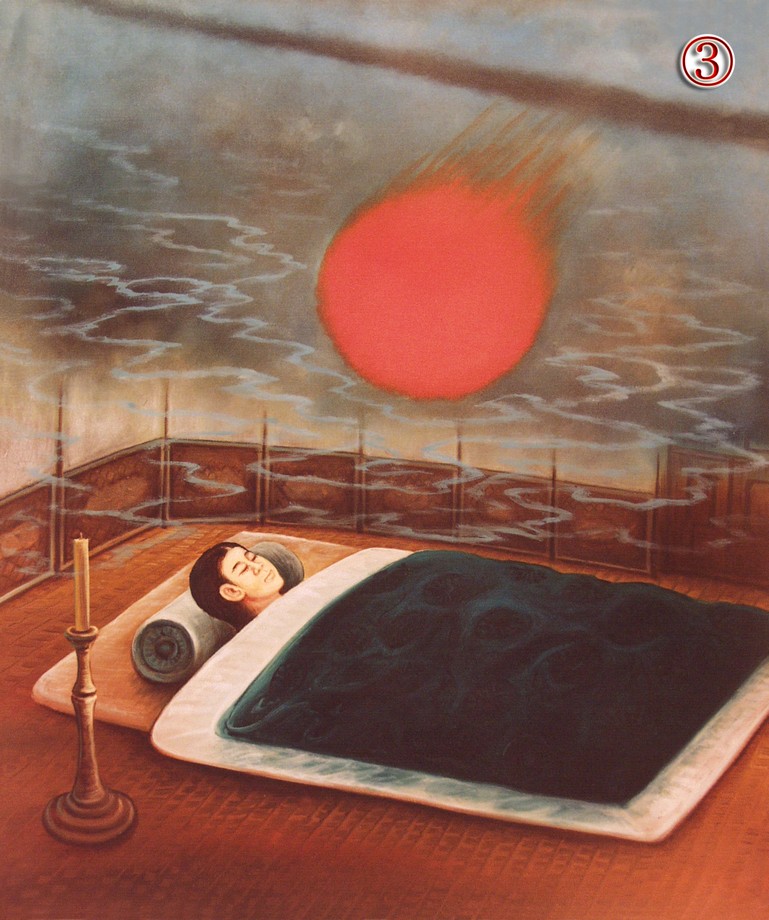
- ③ There was a woman with a family name of Kwon who was married to the family of Kang in Jeolla Province. One day, she had a dream in which the sky split into north and south and an enormous ball of fire came to envelop her body while brightening the whole world.
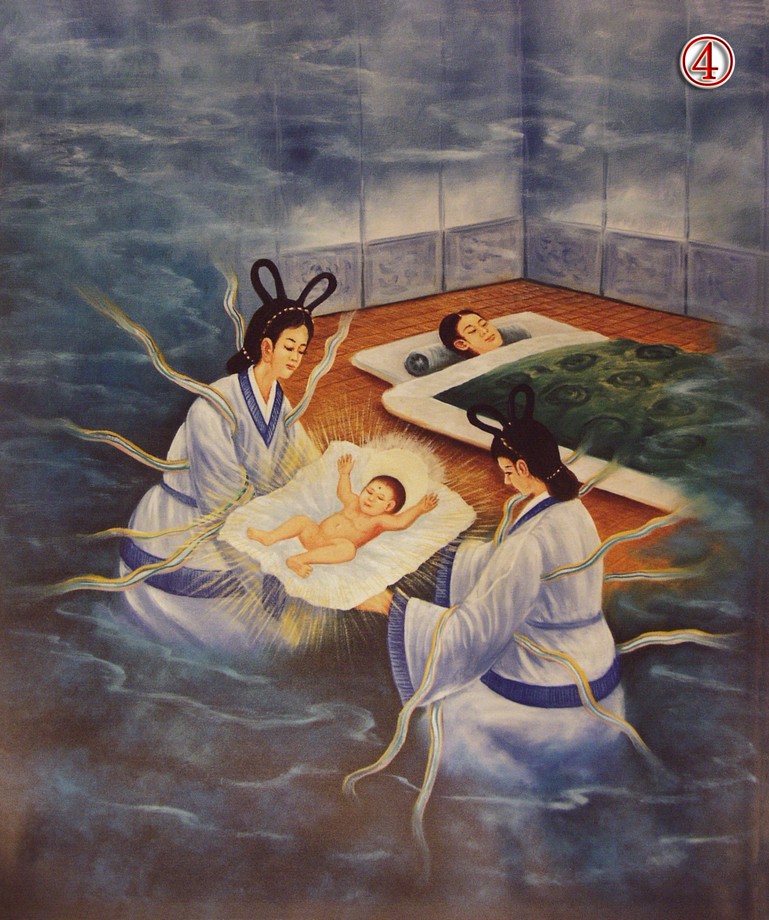
- ④ Then she showed signs of pregnancy, and after thirteen months, on September 19th 1871, Sangje descended into the world by taking human form.
On the day Sangje was born, the delivery room was filled with light; two celestial maidens descended to Earth from Heaven. They entered the delivery room, which was aglow with their presence, and the maidens attended the newborn Sangje. An effervescent, mysterious fragrance filled the entire delivery room. An auspicious vapor enveloped the entire house in which Sangje was born, and its light, extending up into the sky. 【Acts 1-10】

- ⑤ Starting in His childhood, Sangje frequently demonstrated the virtue of benevolence towards living beings. He took great joy in planting trees

- ⑥ and would even save the lives of tiny insects.
From His youth onward, Sangje exhibited a good-natured and generous personality and a remarkably brilliant mind. Even as a little boy, Sangje possessed the great virtue of respecting all life; for instance, He enjoyed planting trees but never broke off even a single branch or harmed any insects no matter how small. Sangje was loved and revered by all who knew Him. 【Acts 1-11】

- ⑦ When He was 7 years old, Sangje was studying in His home with a village tutor.
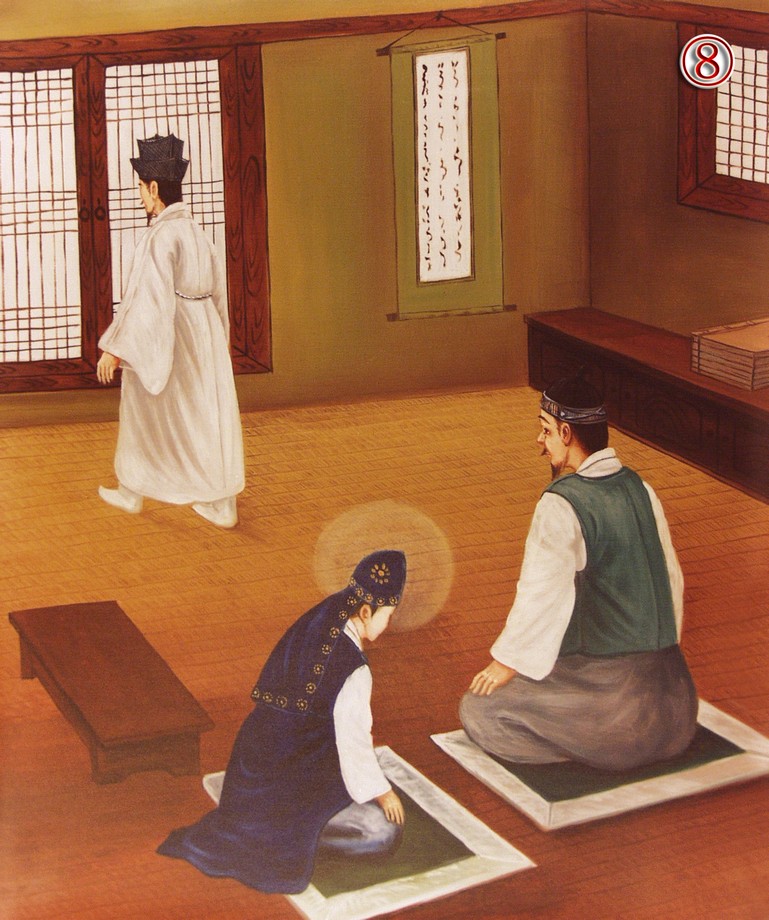
- ⑧ He read the two Chinese characters, “Heaven” and “Earth,” and thereby knew the principles of Heaven and Earth just by reading those two characters and demonstrated this to His father who then allowed Sangje to dismiss His tutor.

- ⑨ Sangje was a youth of great strength and would playfully bite onto and then lift up the pivot of a millstone with His teeth.
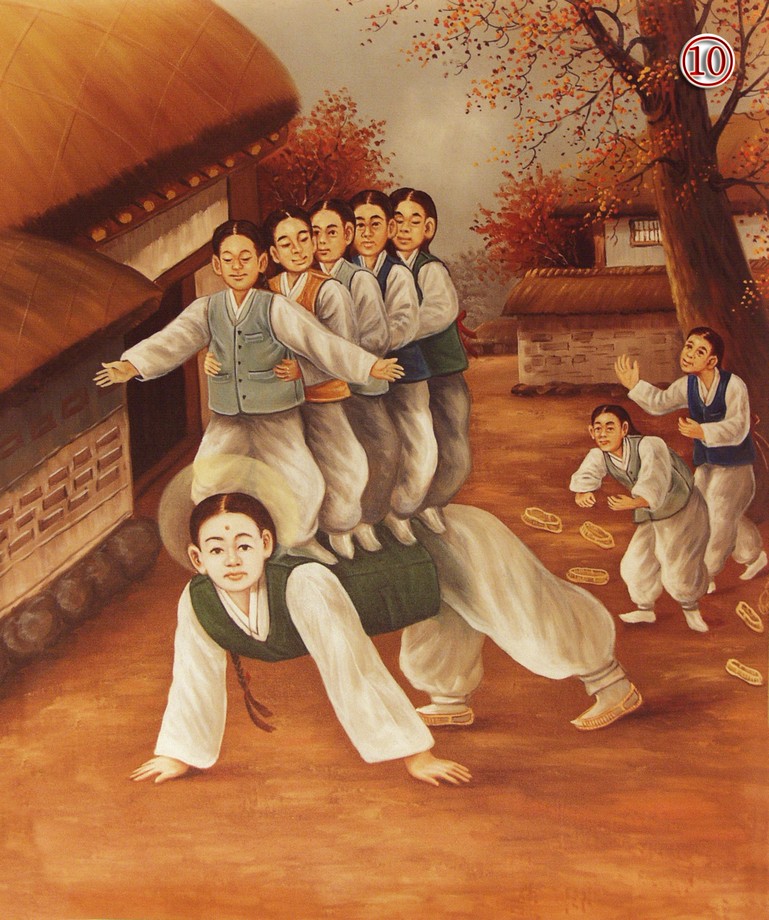
- ⑩ Furthermore, He would not even move an inch even when neighborhood boys tested His strength by standing on His back.
In His youth, Sangje was an active, playful boy. Two of Sangje's relatives, Kang Yeon-Hoe and Kang Gi-Hoe, were solidly built, powerful men. They enjoyed devising contests and measuring their strength against Sagje's. For His part, Sangje enjoyed taking opportunities to display His strength. On one occasion, Sangje bit down on the metal joint-connector at the bottom of a millstone with His teeth and lifted the heavy stone off the ground. His remarkable feat startled nearby onlookers, who were spellbound. On another occasion, Sangje jump-kicked the edge of the eaves of the high roof from a standing position in the yard without even taking a running start. And yet another time, He threw from the ground heavy thatched roofing materials onto a house's rooftop with one hand. Sometimes He would get down on all fours while a dozen or so strong men would attempt to hold Him down. The grown men completely exhausted themselves, but Sangje's body did not move down, not even an inch. Kim Gwang-Mun passed on a story telling of a time he witnessed Sangje playfully amusing a group of children by putting a stone mortar on His head and spinning it so effortlessly that it looked like a streamer twirled from a hat (sangmo) when dancing. 【Acts 1-15】
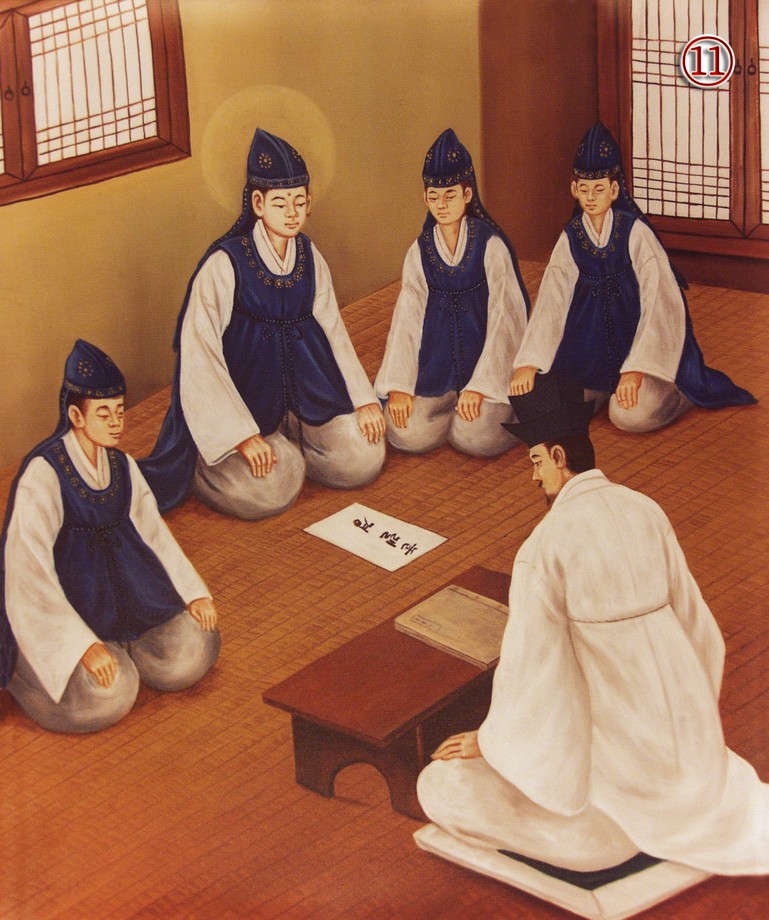
- ⑪ Sangje visited His village school one day and received “frighten (驚)” as a one-character writing prompt from the teacher.

- ⑫ He thereby composed the following verse: “Taking a great stride, I hope that I do not demolish the earth. Shouting with a big roar, I worry I may frighten heaven.”
2. Rectifying and Saving the World
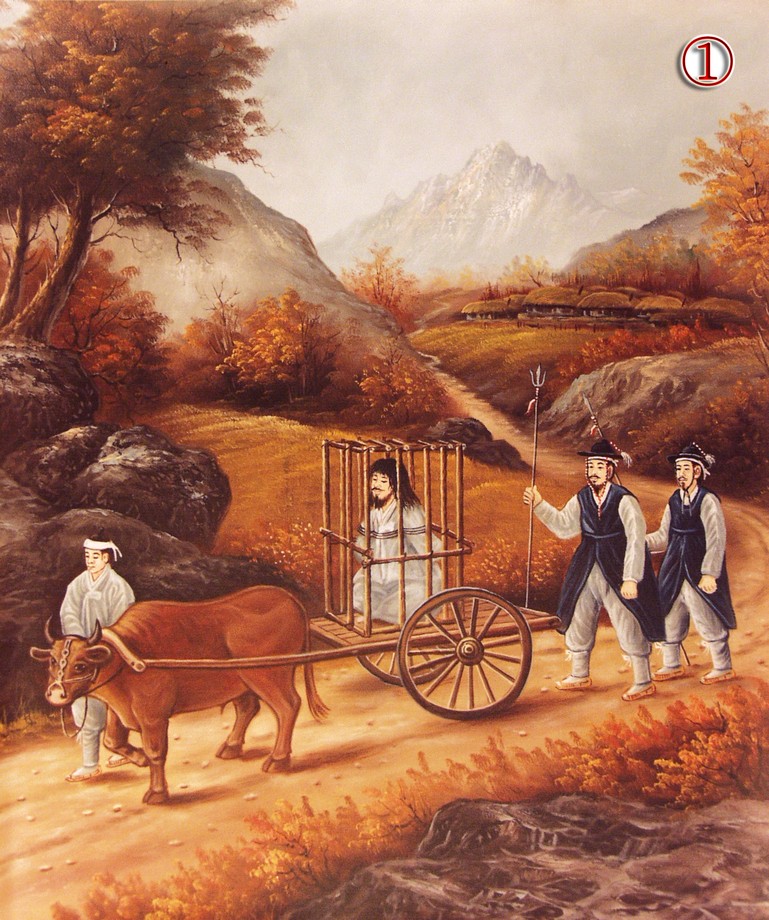
- ① When Sangje was twenty four years of age (1894), government affairs were becoming increasingly corrupt and people’s lives were growing aggravated. Accordingly, the world became so chaotic that the people were unable to lead peaceful lives. At that time, Jeon Bongjun from Gobu started a revolution as he was infuriated by governmental misrule.
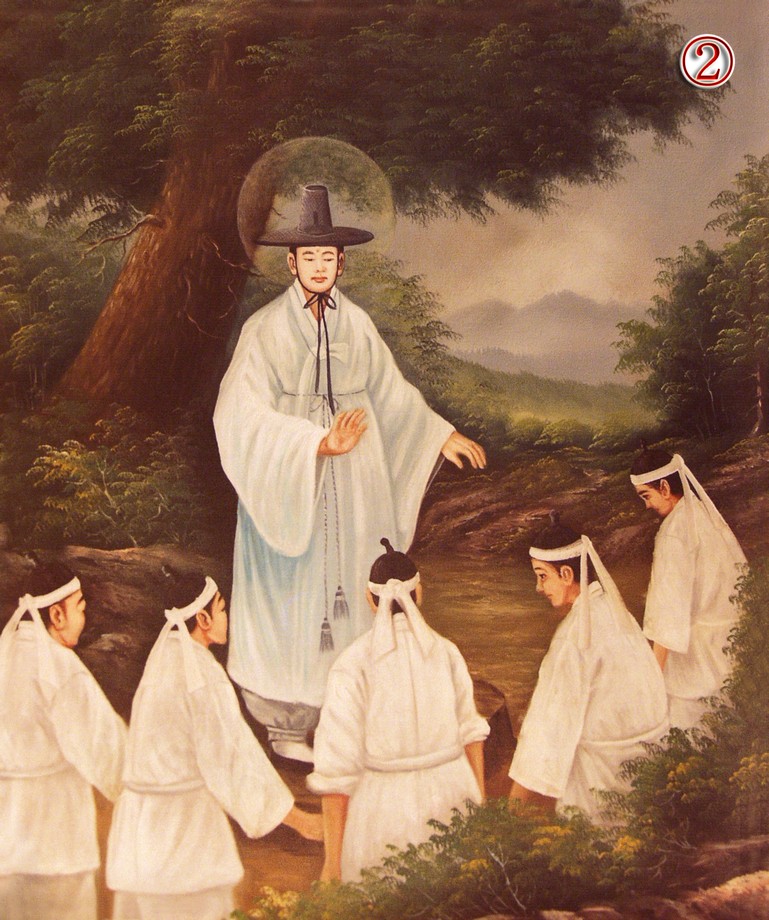
- ② When Sangje predicted that the Donghak followers would be destroyed by the time winter came, He advised everyone not to behave rashly or join the Donghak rebellion. Indeed the Donghhak rebels were annihilated by the government forces by the first snowfall.
Jeon Bong-Jun became outraged by the political tyranny taking hold in the country, so he organized a peasant militia of Eastern Learning followers to combat it. As the political situation continued to deteriorate, the fury of the peasant militia was said to have soared to the sky. Jeon Bong-Jun's militia was growing in strength every day. Then, on one summer day during those days of difficulties, Sangje foresaw a disastrous outcome for Jeon's militia. Sangje recited a poem to the people: “As the moon falls dark and wild geese fly high, Chanyu will flee during the night. As the swift cavalry is about to chase after him, Heavy Snow will cover both the bows and the swords [月黑雁飛高 單于夜遁逃 欲將輕騎逐 大雪滿弓刀].″ Sangje predicted that the Eastern Learning troops would be completely routed at the time of falling snow. Sangje advised people not to join the Eastern Learning movement. Just as He had predicted, the Eastern Learning peasant militia was annihilated by the government forces in the winter of that year; those who had taken Sangje's advice were able to avoid the calamity. 【Acts 1-23】

- ③ In spring of 1895, Sangje attended a poetry club celebrating the restoration of peace on Duseungsan Mountain, where He received a book from an old man.

- ④ By 1897 Sangje, with the great intention of saving the whole world, set off to examine the state of world and public sentiment. Everywhere He stepped, He was honored like human incarnation of a Divine Being.
The rebellion was temporarily suppressed, and the Confucian scholars advocated for peace to prevail throughout the land, but in fact, disorder increased steadily throughout the nation. Thus, He decided to rectify the faults of the world and save it from itself. 【Acts 1-25】
In the Jeongyu Year (1897), Sangje opened a village school once again at Jeong Nam-Gi's house, where He taught His younger brother Yeong-Hak and Hyeong-Ryeol's son Chan-Mun as well as the students from the neighborhood. At that time, Sangje read through the books on Confucianism, Buddhism, and Daoism; in addition, He spent time reading through the books on the yin-yang school of thought, prophecy, and other books related to philosophy. By reading these books, He hoped to use the knowledge within them to save the world by rectifying its faults. After teaching at the school for a while, He went on a journey to observe public sentiments and circumstances. 【Acts 2-1】
Sangje stayed there for a few more days and then continued His journey to various places throughout Gyeonggi (Capital Area), Hwanghae (Yellow Sea), Pyeong-an (Peace-Comfort), Hamgyeong (All Brilliance), and Gyeongsang (Celebration-Admiration) Province. Once He reached Jeonju (Perfected Territory) Government Capital, Sangje was warmly greeted by the residents who treated Him with respect as a man of divine power. 【Acts 2-3】
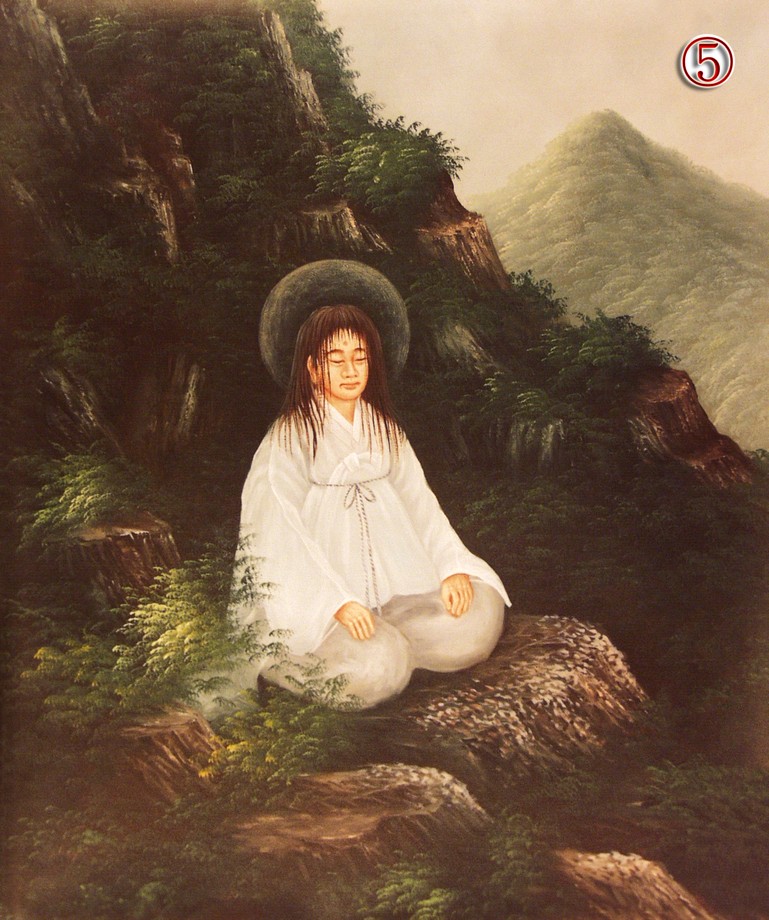
- ⑤ After traveling throughout all eight provinces over a period of 3 years, Sangje returned to His hometown, where He would untie His hair and weep on Sirusan Moutain,
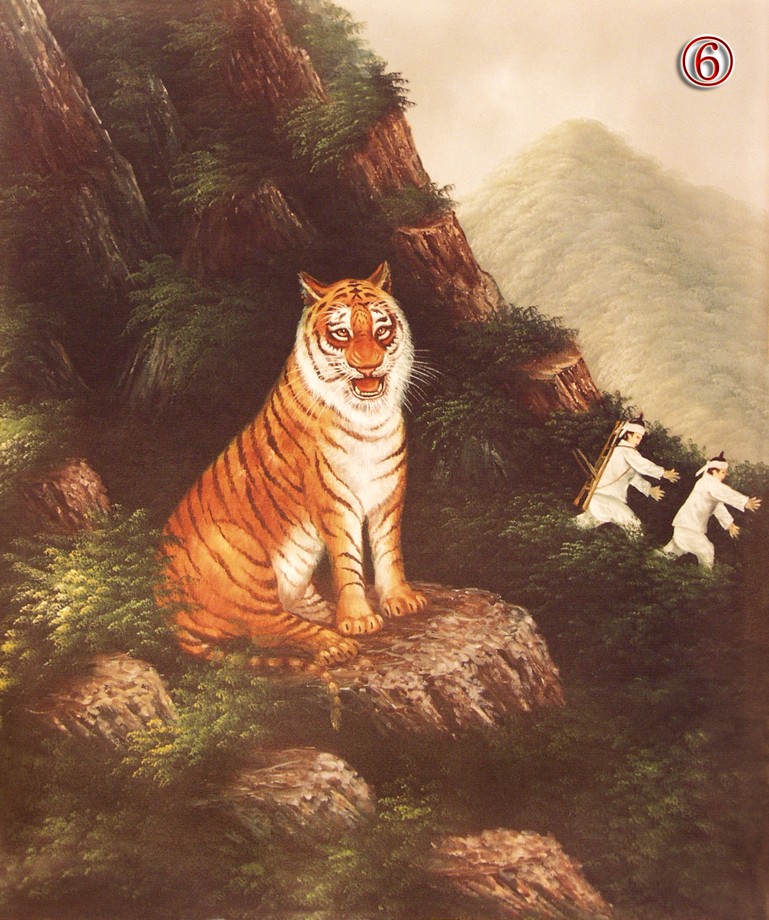
- ⑥ He would transform into a tiger and this frightened off village lumberjacks. Chanting Jinbeopju (Incantation of True Law), He performed His Holy Work related to Obangsinjang (5 warriors of the divine world representing North, South, East, West, and Center), Sashipaljang (48 warriors of the divine world) and Isipaljang (28 warriors representing the 28 constellations of the divine world).
In the Gyeongja Year (1900), when Sangje finished His three-year journey, He came back home to Guest-awaiting (Gaekmang) Village. Sangje relocated His grandmother's grave to Mount Steamer-on-Cauldron (Siru-san) after deliberating with the feng shui consultant (jisa), Ryu Seo-Gu. From that time forward, whenever Sangje practiced Holy Works (gongbu 工夫) on the summit of Mount Steamer-on-Cauldron, He always did so after untying His topknot and letting His hair down. One day, when Sangje was sitting, He transformed Himself into a tiger. Some woodcutters were passing by and saw a tiger where Sangje usually sat. They were so frightened that they told Sangje's father about what they had seen. His father, being at a loss, climbed up the summit, but he could not find the tiger. He only saw Sangje sitting there calmly and practicing Holy Works as if nothing happened. 【Acts 2-7】
During the days when He was practicing Holy Works on Mount Steamer-on-Cauldron (Siru-san) in Guest-awaiting (Gaekmang) Village, Sangje occasionally went down to Yu Deok-Ahn's house at night, asked him for a handful of small black beans (juinuni-kong), and ate them with cold water. Finding Deok-Ahn's son Chil-Ryong there one night, Sangje remarked, “You've been begging Me to save your life. ″ Whenever Sangje climbed up to Mount Steamer-on-Cauldron, He yelled so loudly that mountains and streams reverberated. All the villagers were too scared of the noise to step outdoors. 【Acts 2-8】
While Sangje was practicing Holy Works on Mount Steamer-on-Cauldron (Siru-san), He sometimes cried around the spring site under the mount. Once, Sangje's father saw this sight while climbing up the mountain carrying a meal for Sangje. 【Acts 2-9】
One day, when Sangje resumed Holy Works again, He recited the Incantation of Perfected Dharma (Jinbeop-ju) and proceeded with the Reordering Works of the Divine Generals of the Five Directions, the Forty-Eight Divine Generals and the Divine Generals of the Twenty-Eight Constellations, respectively, on Mount Steamer-on-Cauldron (Siru-san). Afterward, Sangje, wearing a red cloth around His neck, went to Kim Gi-Jin's house in Pair-of-Workers (Ssangjeong) Village and told him about the Reordering Works. In that house, many of the villagers used to gather eagerly around to listen to Him. 【Acts 2-10】
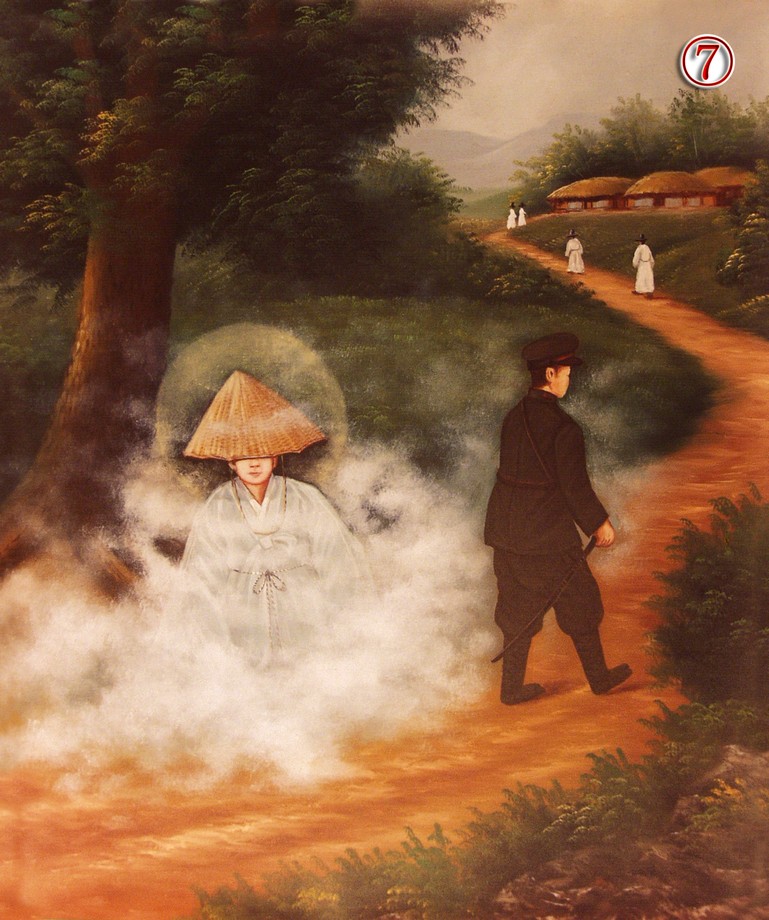
- ⑦ After hearing about Sangje's practice of magic, the constable sent an official to detain Him. However, when Sangje sat down while wearing a satgat (traditional hat made of bamboo) and conjured a fog of concealment, the official ended up passing Him by without recognizing Him.
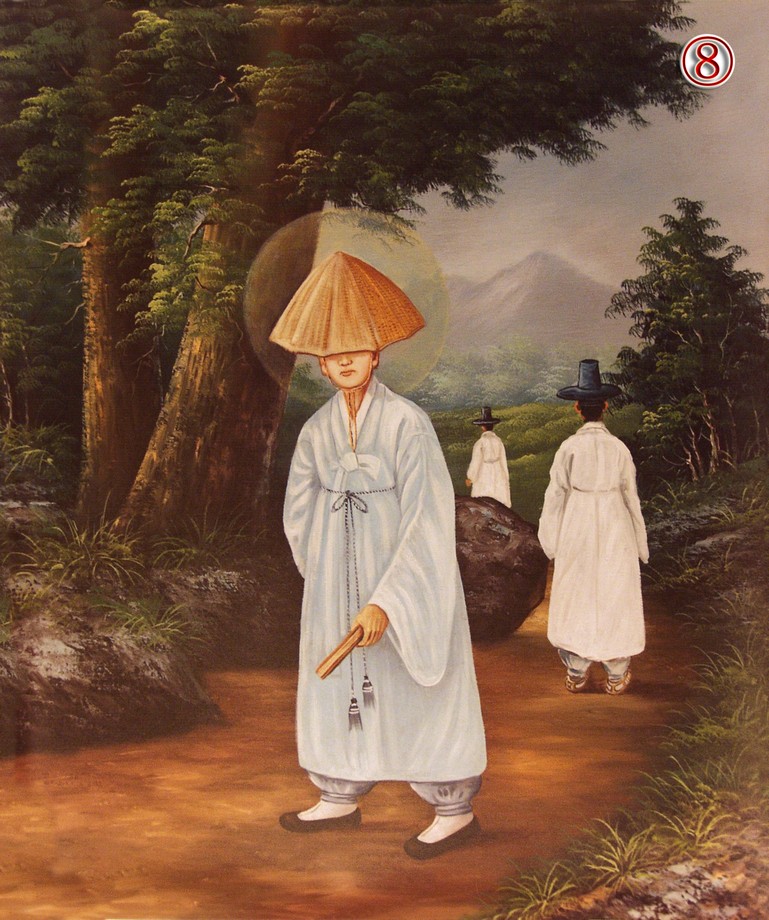
- ⑧ Sangje’s habitual wearing of the satgat (traditional hat made of bamboo) earned Him the nickname: Kang Satgat.
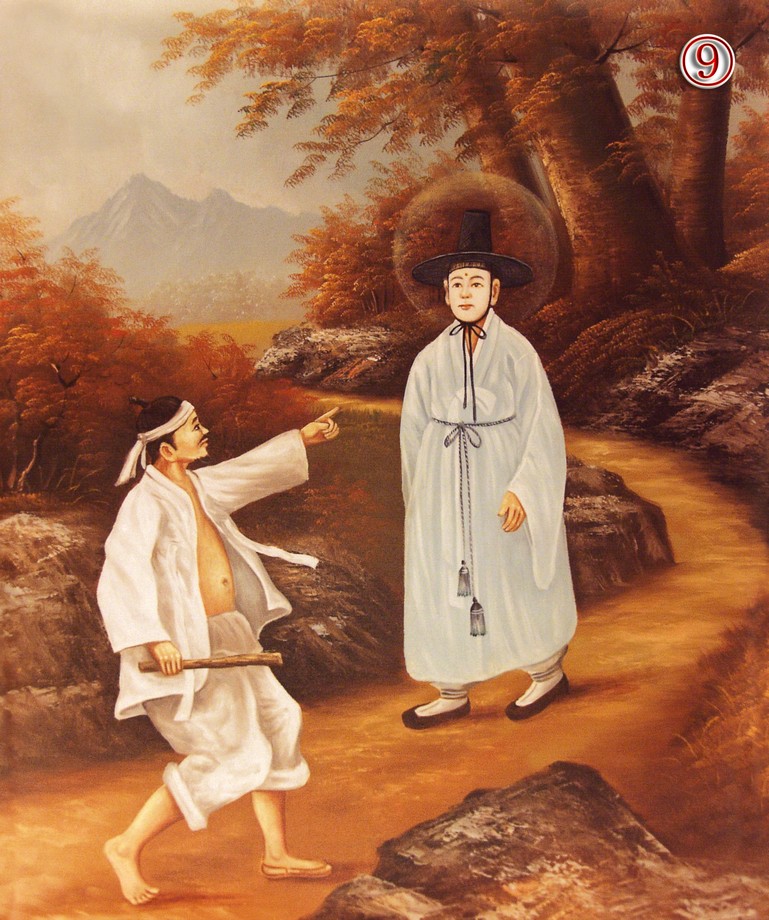
- ⑨ Once, Sangje was on His way to visit maternal relatives when He encountered a swearing drunkard who was causing a commotion.
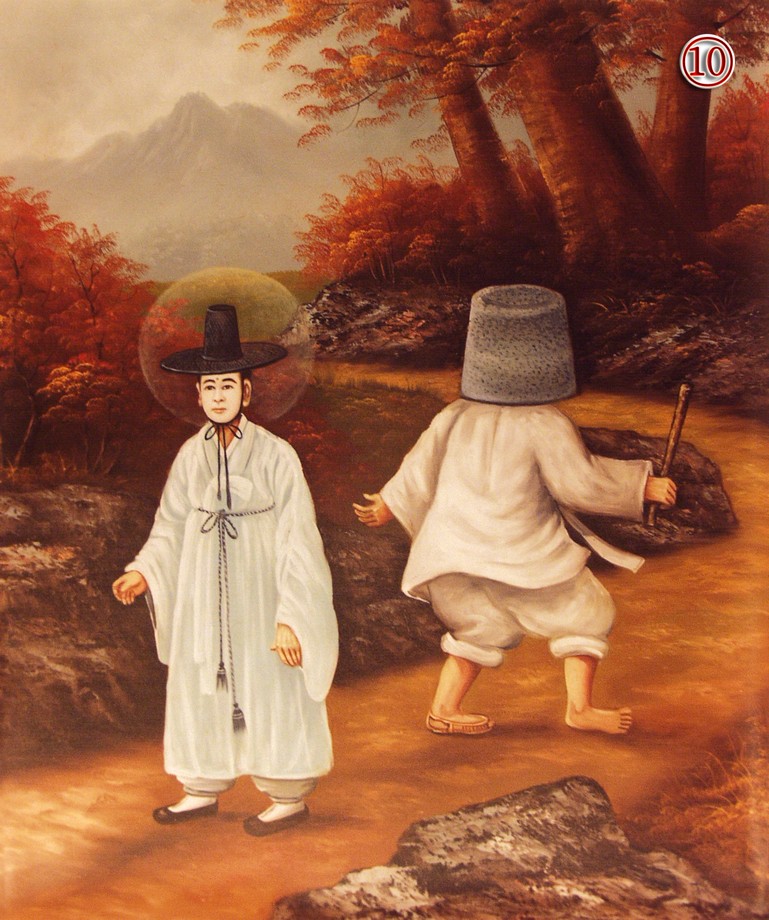
- ⑩ Abruptly, a stone mortar came out of nowhere and covered the drunkard’s head so that Sangje could continue on His way.

- ⑪ Another time, Sangje was passing Secheon Stream with Kim Ik-chan when they witnessed a Japanese hunter about to fire bullets towards a flock of wild geese. Once beside the hunter, Sangje stopped walking. The hunter's gun jammed up and was unable to be fired.
Sangje, while passing Three Stream (Secheon) of Jeonju (Perfected Territory) County, accompanied by Kim Ik-Chan, saw a Japanese hunter pointing his gun at a flock of wild geese which were sitting on the stream and said, “I cannot bear to see this sight.″ And after stomping His left foot on the ground one time, He stood upright at that spot. At that moment, the geese flew away. It was only after Sangje took a step that a gunshot was then heard. 【Authority and Foreknowledge 2-5】
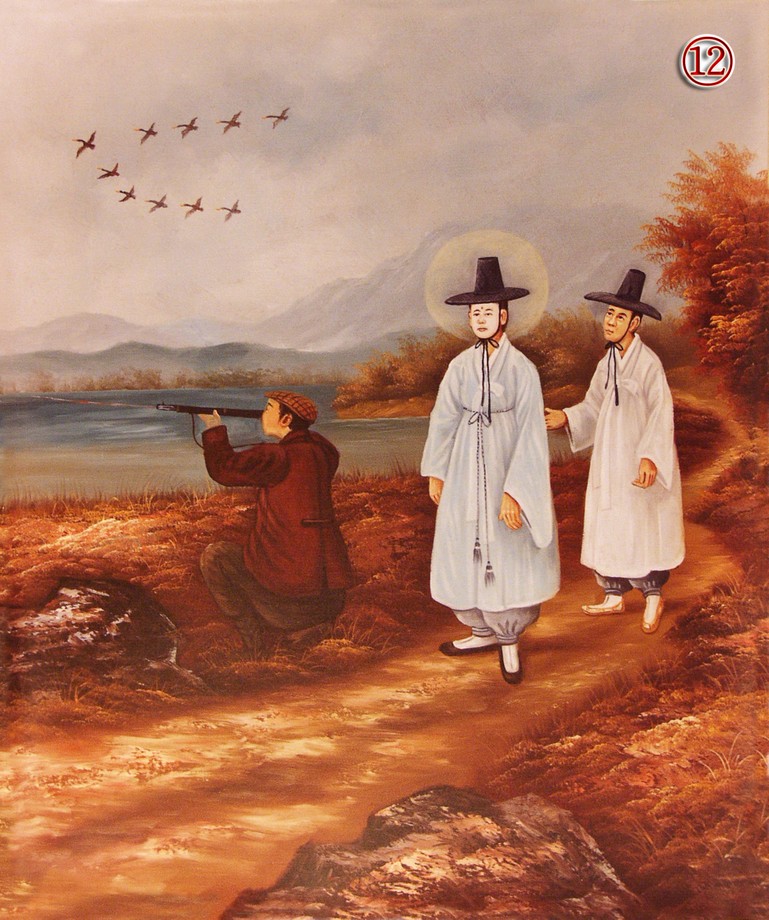
- ⑫ When Sangje started walking again, the flock of wild geese flew away. Only then, was the hunter able to fire his weapon.
3. Great Authority over the Three Realms

- ① Around mid-May in 1901, Sangje entered Daewonsa temple in Moaksan Mountain, Jeonju, and went through forty nine days of ascetic practice without food or rest in order to open the Great Dao of Heaven and Earth.
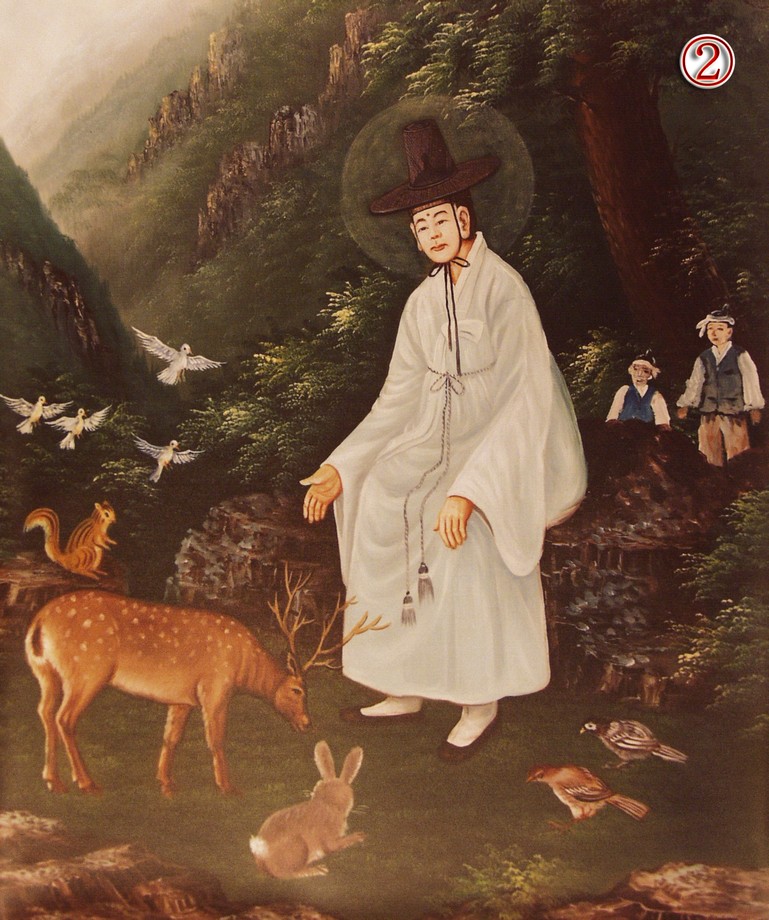
- ② When exiting Daewonsa Temple Valley with a few Dao cohorts, many wild animals gathered to bow at His feet in a way that seemed like pleading.
In the fifth month of the Shinchuck Year (1901), Sangje traveled to Great Court Temple (Daewon-sa) at Mount Mother (Moak-san) in Jeonju (Perfected Territory) County and, there, occupied a quiet room that had personally been prepared by Abbott Park Geum-Gok. Sangje asked to be left alone in order to practice a Holy Work uninterrupted, even so far as going without food or rest. Geum-Gok grew increasingly worried as Sangje stayed entirely devoted to His work for 49 days. On the fifth day of the seventh month, Sangje finally opened the great Dao of Heaven and Earth, and as He did so, a great wind was blown by the Five Directional Dragons. From within His room, He called out to Geum-Gok asking for a bowl of rice gruel, and the monk was glad at last to be able to serve Him. A few minutes later, Sangje came out of the room. His clothes were so disheveled that no one dared look at them. Geum-Gok soon sent someone to Sangje's house, requesting that a new outfit be brought Sangje's wife (Jeong Chi-Sun), said impious words as she handed over the clothes. She had grown frustrated with His indifference to the household duties. As Geum-Gok offered Sangje that outfit, He said, “This outfit is permeated with the flippancy of a frivolous woman, so throw it away quickly. ″So Sangje did not wear the clothes. When Geum-Gok sent someone once again to inform Sangje's wife about this, she repented of her faults, apologized for what she had said, and brought down a new outfit. 【Acts 2-12】
Sangje, who had been finishing the Holy Work of the Great Court Temple (Daewon-sa), changed His clothes and went out of the room. When He stepped outdoors, many varieties of birds and species of animals gathered together quite suddenly in the valley around the temple. They greeted Him as if they were begging Him for something. Sangje looked around the group of birds and animals with interest and said to the them: “Do you also wish for the resolution of grievances for the Later World? ″ In reply, the animals bowed to Him as if they understood. When Sangje told them, “I see. Now step aside. ″ The multitude of animals followed His order. 【Acts 2-15】
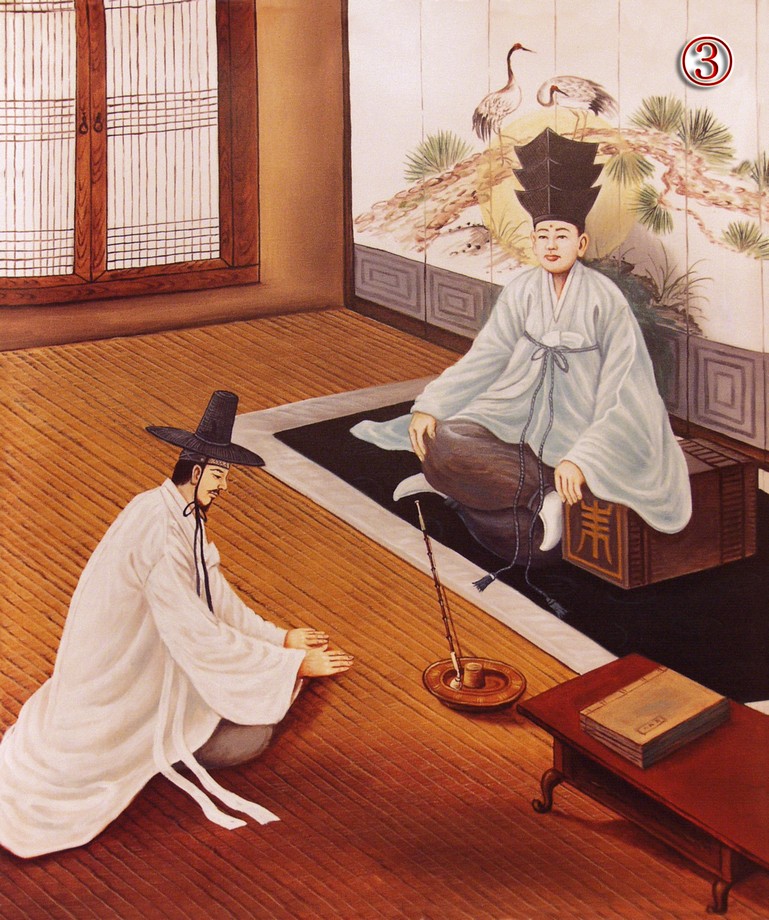
- ③ In November of 1904, the civilians of Jeonju formed an uprising which created a chaotic atmosphere across the nation. Faced with the heavy responsibility of national affairs, Kim Byung-wook, told Sangje about how difficult it would be to squelch the uprising and pleaded for a solution.
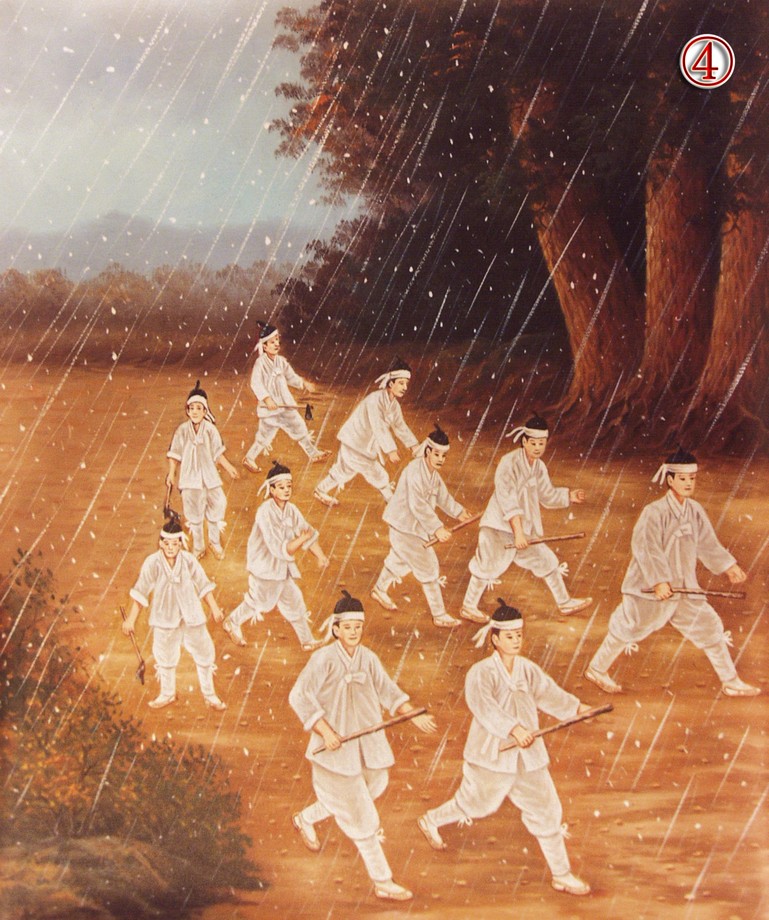
- ④ Sangje declared: “I will put down the rebellion”. Then He made rain and snow pour down, chilling the weather, and thus suppressing the revolt.
In the 11th month of the Gapjin Year (1904), as civil unrest was growing in Jeonju (Perfected Territory) County, the public sentiment began worsening. During this turmoil, Sangje reached Jeonju Government Capital. When Kim Bo-Gyeong came to have an audience with Sangje, Sangje asked him out of curiosity, “Since Kim Byeong-Wuk holds a crucial role in the government, he should put all his efforts into quelling the unrest. What is his plan? ″ Then Bo-Gyeong passed His words to Byeong-Wuk. Byeong-Wuk asked Bo-Gyeong to pass his words to Sangje, saying, “It is impossible for me to repress this uprising which is spreading like wildfire, so please resolve the matter.″ Sangje realized Byeong-Wuk's situation after hearing from Bo-Gyeong, and He just smiled. That night, as snow and rain was falling down and the weather became bitterly cold, the crowds who had gathered at the encampment were unable to endure the snow, rain, and freezing cold, and they thereby began to disperse. Because the cold, snow, and rain continued for three days, the crowds did not manage to gather again, so the uproar subsided on its own. 【Acts 3-25】
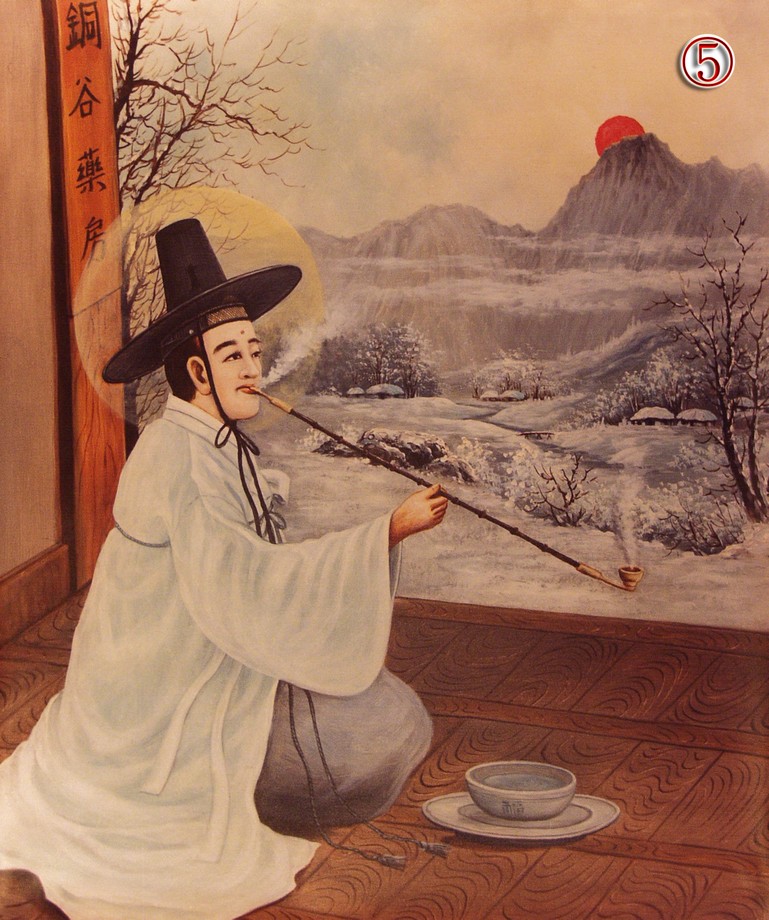
- ⑤ One day while residing in Donggok Valley Clinic (apothecary), Sangje saw the sun rise at an early hour from behind Jebibong Peak and when it rose halfway, Sangje said to His followers, “The world is stuck in an impasse. How can I have an aim to stabilize the state of things without the power to stop the sun? I will test on it.” In declaring this, Sangje smoked His pipe repeatedly until the sun stopped rising.
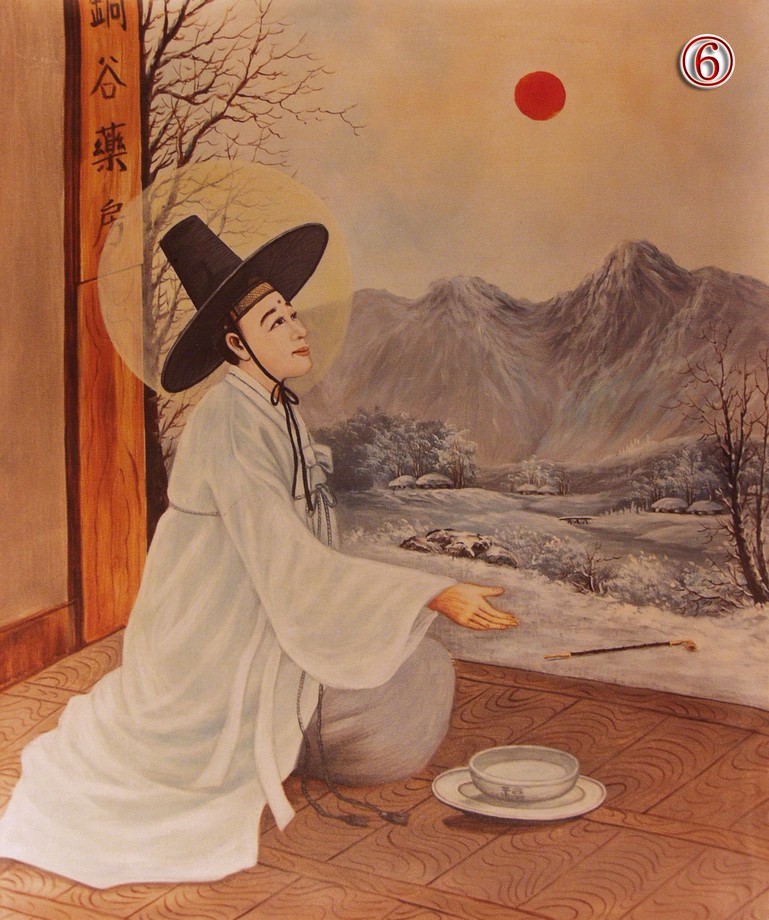
- ⑥ Only after throwing down His pipe, did the sun come to rise fully.

- ⑦ When taking midnight walks, if the clouds covered the moon, Sangje would wave His right hand toward the moon, dispersing the clouds, and enabling the moonlight to shine over Him.
One day in the 12th month, Sangje was going to Copper Valley (Donggok) Village with His disciples. When He gave the divine beings the order to clean up the road because it was too muddy to walk on, the muddy road turned hard soon after. They were able to go to Copper Valley Village, with their straw shoes dry. The order which Sangje burned at that time consisted of six Chinese characters which read 'Your Highness is at the foot of the All Spread (Hamra) Mountain [御在咸羅山下].' 【Authority and Foreknowledge 1-12】
One day, while staying at Hwang Eung-Jong's house in Crouching-Dragon (Waryong) Village, Sangje controlled clouds at will. He drew circles with a tobacco pipe toward the sun. Then, some clouds blotted out the sun and others cleared away. 【Authority and Foreknowledge 2-11】
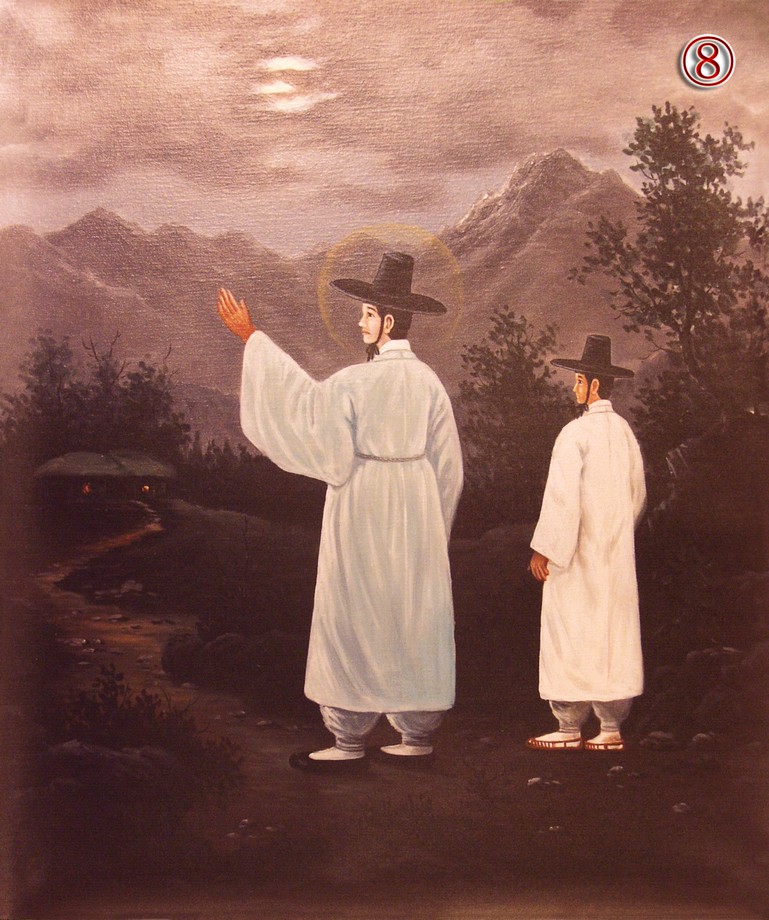
- ⑧ Arriving at His destination, He would then wave His left hand to gather the clouds back to their original position.

- ⑨ At Kim Hyeong-ryeol’s house, Sangje slapped both hands on His knees whilst saying “Good! good!”. Then, lightning from Jebibong Peak struck Surigaebong Peak and lightning from Surigaebong Peak struck Jebibong Peak.

- ⑩ After repeating this motion a few times, He declared “That's enough” and brought His hands back to rest. Then, the lightning ceased.
Sangje, staying at Kim Hyeong-Ryeol's house, said to him one summer night, “Kang Gam-Chan is having a rough time fixing the lightning sword. I will test it.″ Slapping His left and right knees with His left and right hands in turns, He said, “All right, all right.″ Then lightning formed at Mount Empress (Jebi) and soon struck Mount Beneficial Water-Flowing (Surigae). Again, lightning formed at Mount Beneficial Water-Flowing and soon struck Mount Empress. After this happened several times, Sangje stopped moving His hands, saying, “That is good enough.″ Then the lightning stopped as well. The next day, when some disciples climbed up the two mounts and looked around, they found that all the plants and the trees within a radius of a few hundred feet in the areas where the lightning struck had been burned to death and the bark of the trees had fallen off. 【Authority and Foreknowledge 1- 23】
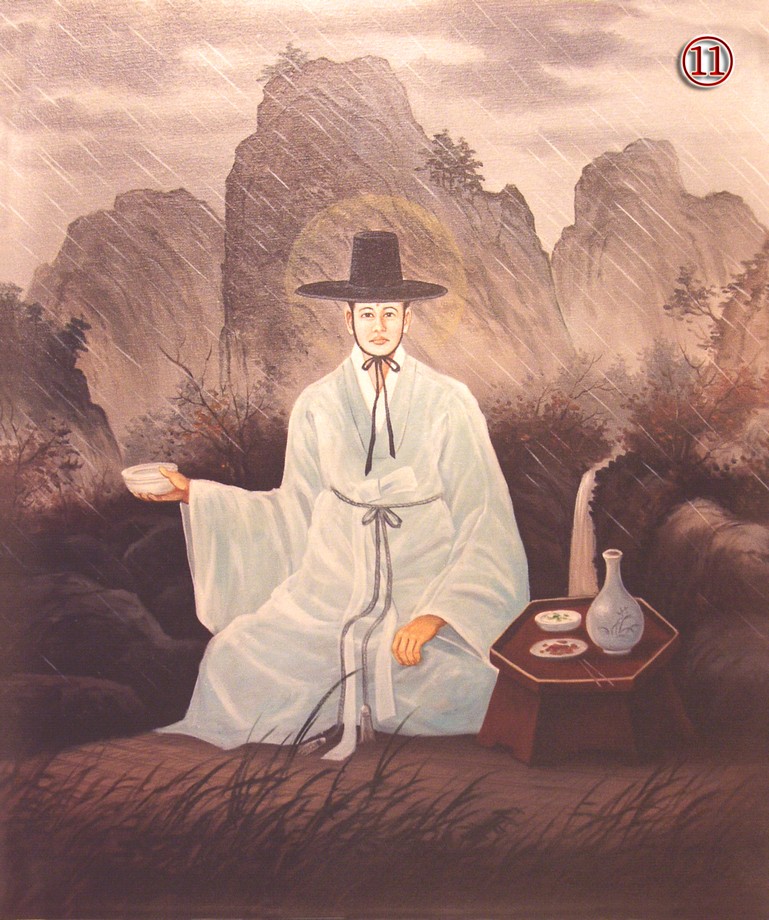
- ⑪ Sangje created the wind, rain, sleet, snow, and lightning at His wish and ceased them upon His command. He could also conjure rain and wind at any time or anywhere only by His will through a variety of means such as certain words, simply lifting His glass, or other such actions.
One day, while staying at Copper Valley (Donggok) Village, which He had returned to from Lucid Dao Court (Cheongdowon), He said, “It is easy to create wind, clouds, rain, dew, frost, snow, thunder, or lightning. But it is hard to make rain fall after snow and to make frost form after rain, even through the creative powers of Heaven and Earth.″ And He added, “I will make these things happen tonight.″ Sangje wrote down some verses on paper and burned the paper. Indeed, it rained after having snowed, and when the rain stopped it frosted over. 【Authority and Foreknowledge 1-22】
On a cold day in winter, Sangje came to Chang-Jo's house and buried a talisman for thunderbolts. Just then, thunderbolts flashed and shook Heaven and Earth. The next day, Sangje left for the clinic at Copper Valley (Donggok) Village. 【Authority and Foreknowledge 2-25】
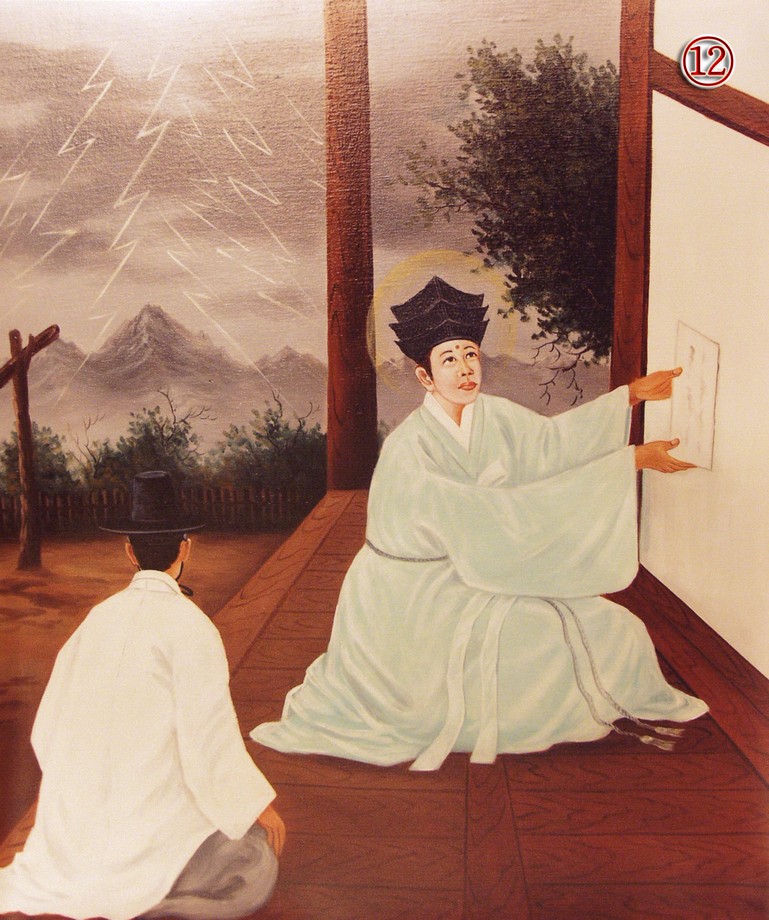
- ⑫ He would take symbols of lightning and paste them on walls or bury them to cause lightning.
4. Omnipotence
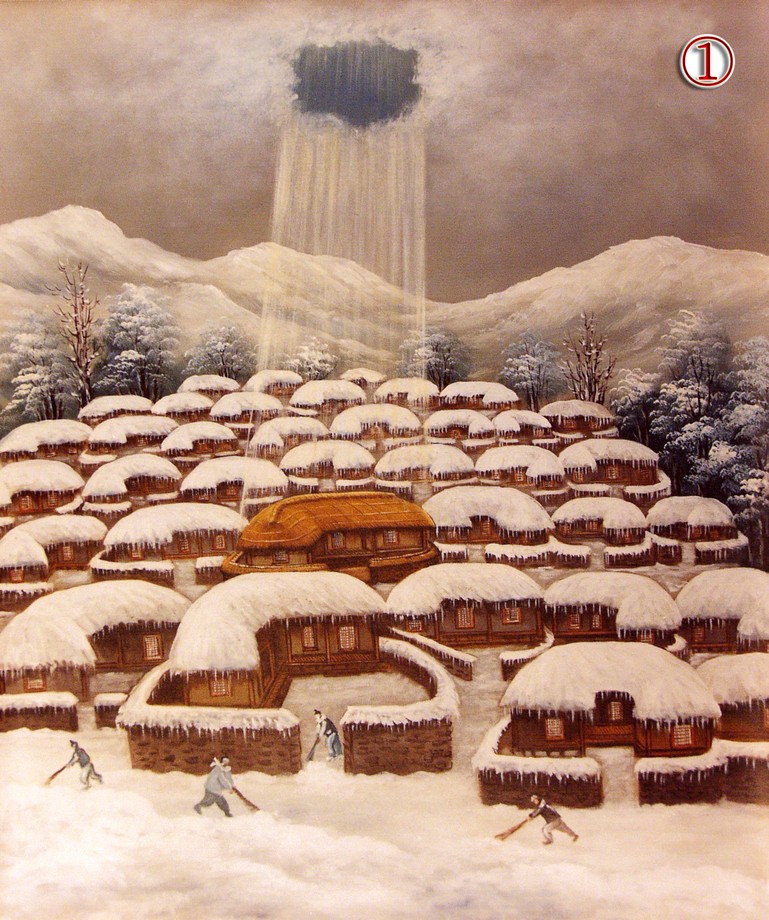
- ① The roof of any house where Sangje resided would remain spotless even in times of heavy snowing and lucid energy would shine down upon Him from the azure sky.
Kim Hyeong-Ryeol wholeheartedly served Sangje, even during the coldest days of the winter. One day, after listening to Sangje, Hyeol-Ryeol said, “It is said that Song Si-Yeol was a man born imbued with some numinous energy from Heaven and Earth, and snow would not gather on the roof of the house in which he lived.″ Sangje said to him, “Is that so? Now, look at the roof over Me.″ Hyeol-Ryeol immediately got up to do so. Outside, he found that there was not a single flake of snow on the roof over Sangje even though the weather was so cold, and snow was piled up in the surrounding area. Instead, on the roof, Hyeol-Ryeol observed a clear stream of energy extending to the blue sky, not hidden by the clouds. Afterward, at any time when Hyeong-Ryeol looked up at the sky, he found that no clouds were seen over the place where Sangje was staying. 【Acts 1-36】
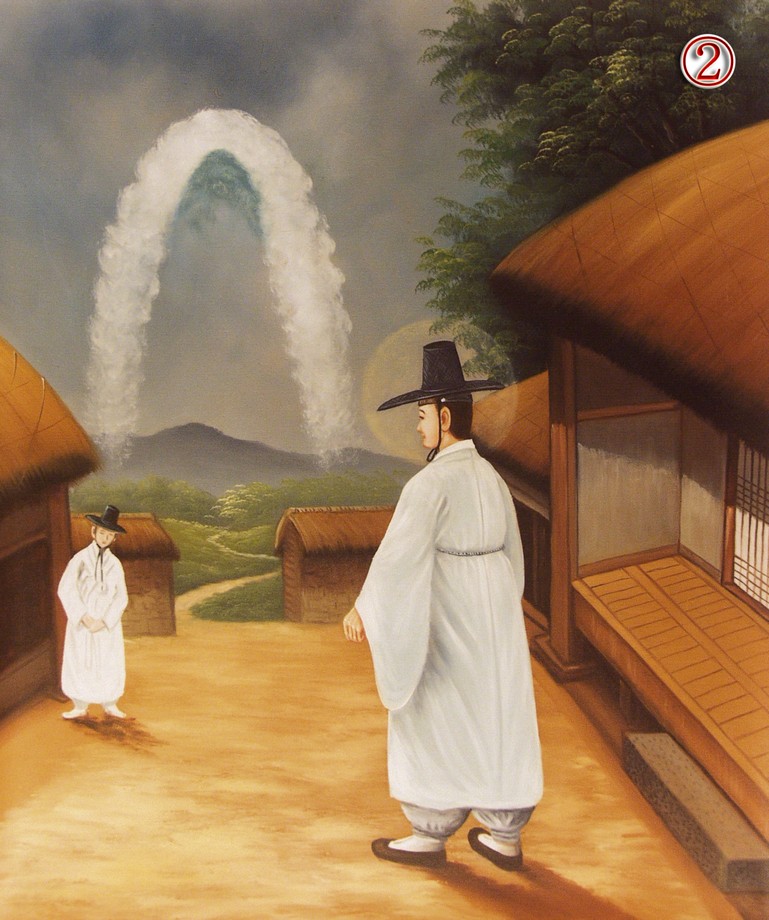
- ② When Sangje prepared for outings, clouds would form in the shape of the Chinese character for eight (八) at the town entrance.
No matter when Sangje moved from one place to another, disciples found that at the left and right side of the entrance to the village, cloud pillars were always formed up in the sky like flag poles in the shape of the character 八 (pal, eight). When they told Sangje about it, He replied, “This is a gate of divine commanders.″ 【Authority and Foreknowledge 2-33】
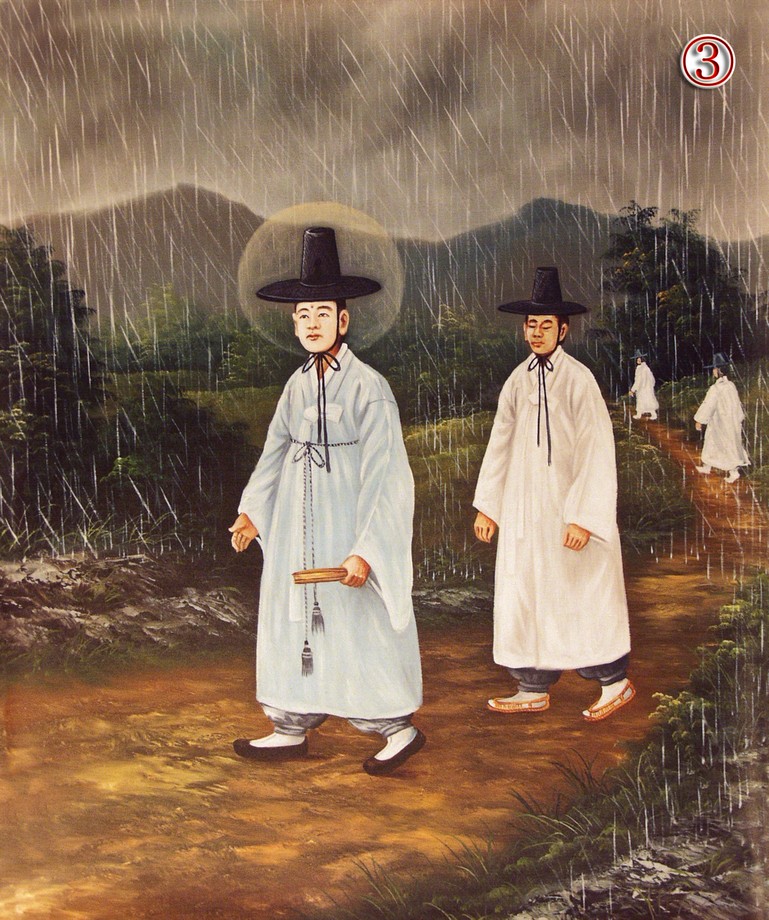
- ③ When He would go out during a downpour, the paths He took would remain dry.
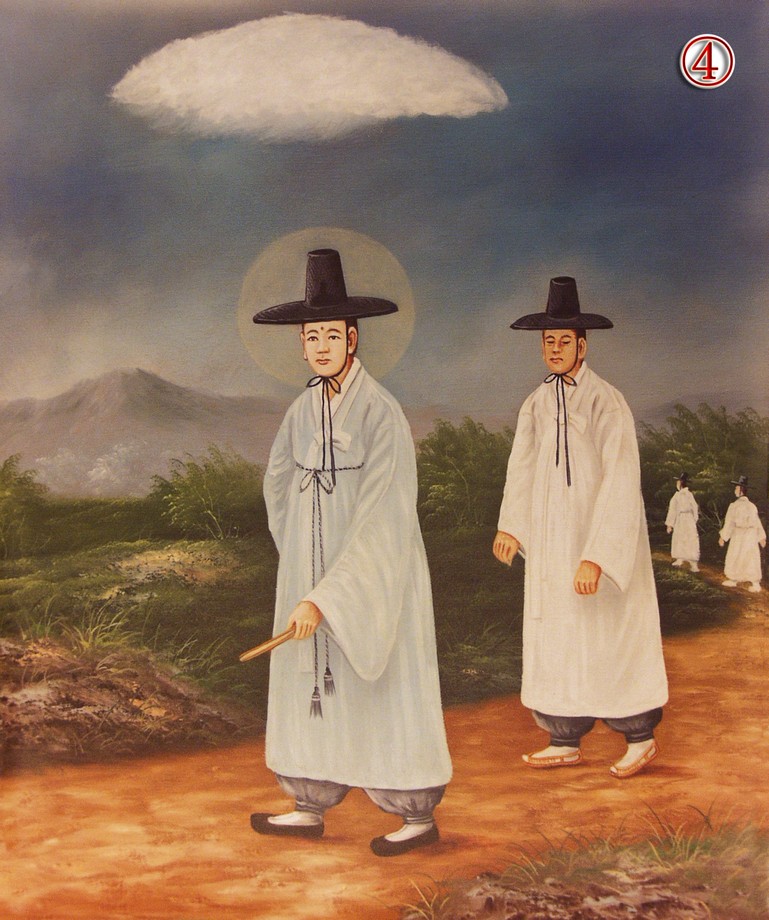
- ④ And on hot summer days, the clouds would form over His path like a parasol.
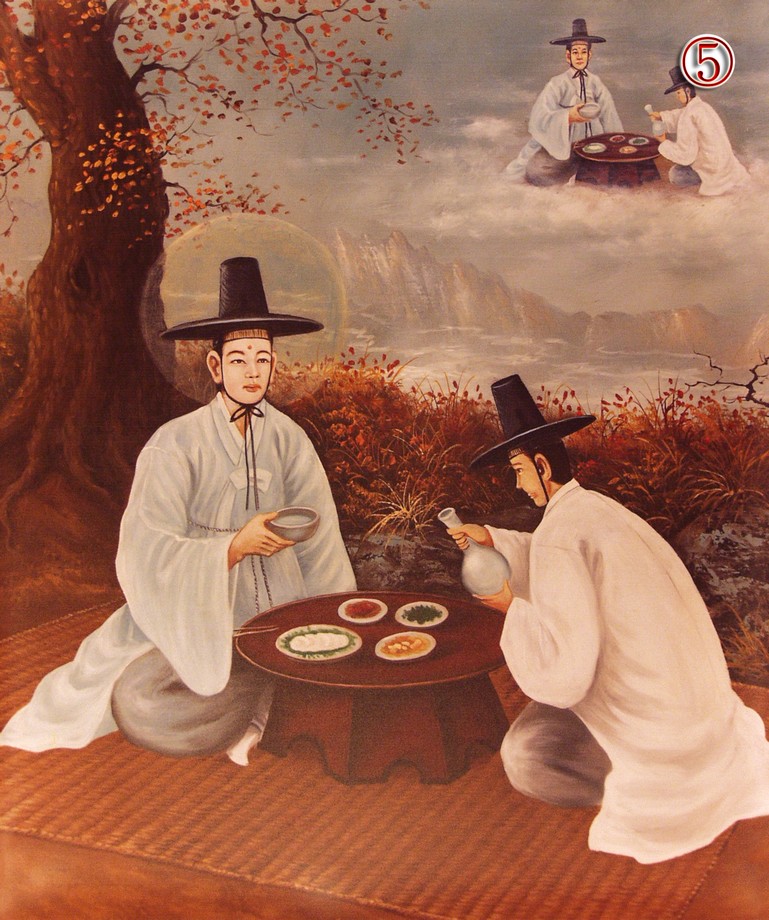
- ⑤ Whether Sangje would engage in public or private affairs, the form of those affairs would appear in the sky. Once, Sangje was enjoying a plate of snakehead-fish sushi when its form appeared in the sky.
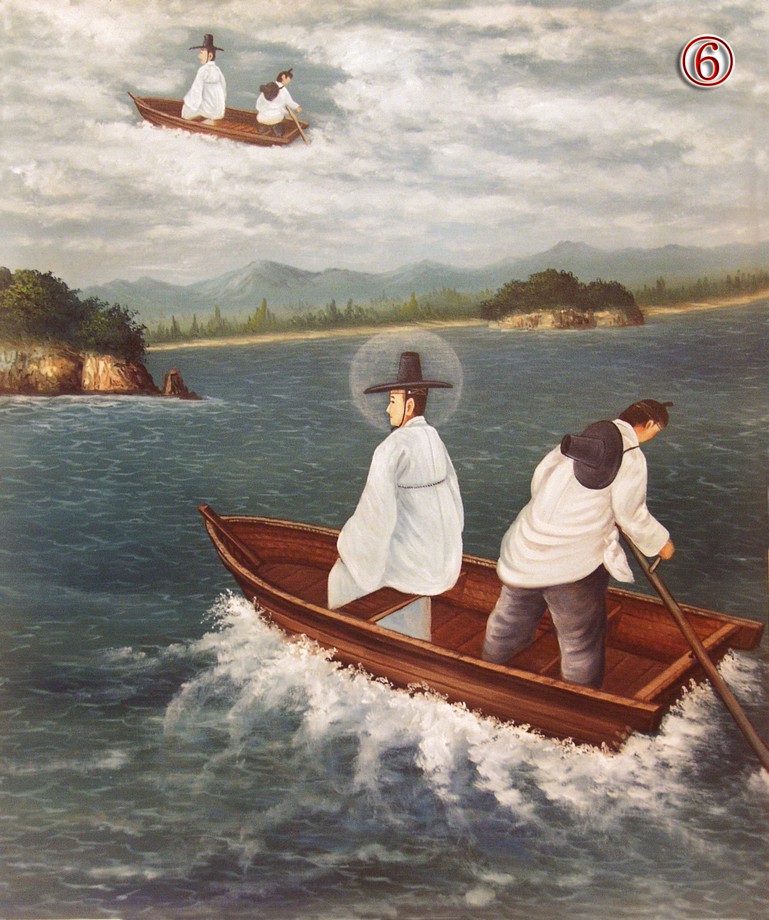
- ⑥ One day, Sangje and His followers were passing through Iri, Iksan and found a ferry but no oarsman. Sangje relied on His own power, and the form of this affair appeared in the sky.
Gyeong-Seok caught a snakehead fish on his own, sliced it raw, and served it to Sangje. A little later, after finishing the dish, Sangje walked out of the door and said towards the sky with a smile, “Fish energy is spreading outward.″ Some snakehead-shaped clouds moved to the east. 【Acts 4-51】
Once Sangje took His disciples traveling via Inner Village (Iri) in Added Mountain (Iksan) County and arrived at a dock, where there was no ferryman but only an empty boat. Sangje rowed the boat Himself. After crossing the river, He looked up in the sky and smiled. As the disciples also looked up, an auspicious cloud had formed like a rowboat crossing the sky. 【Acts 4-35】
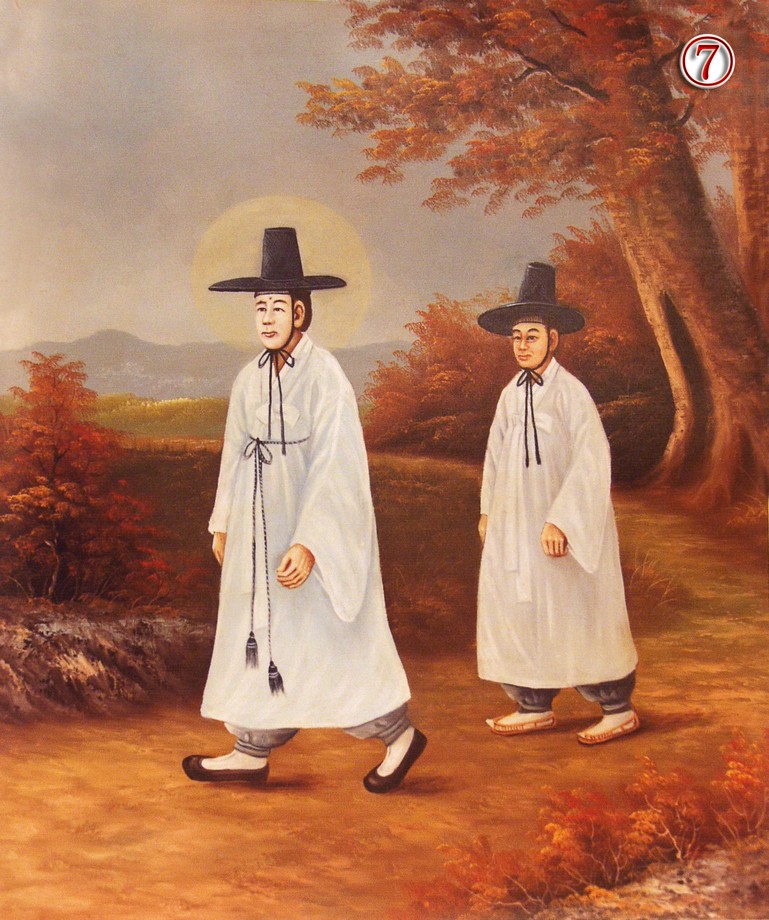
- ⑦ Once Sangje and Gong-u were walking together,
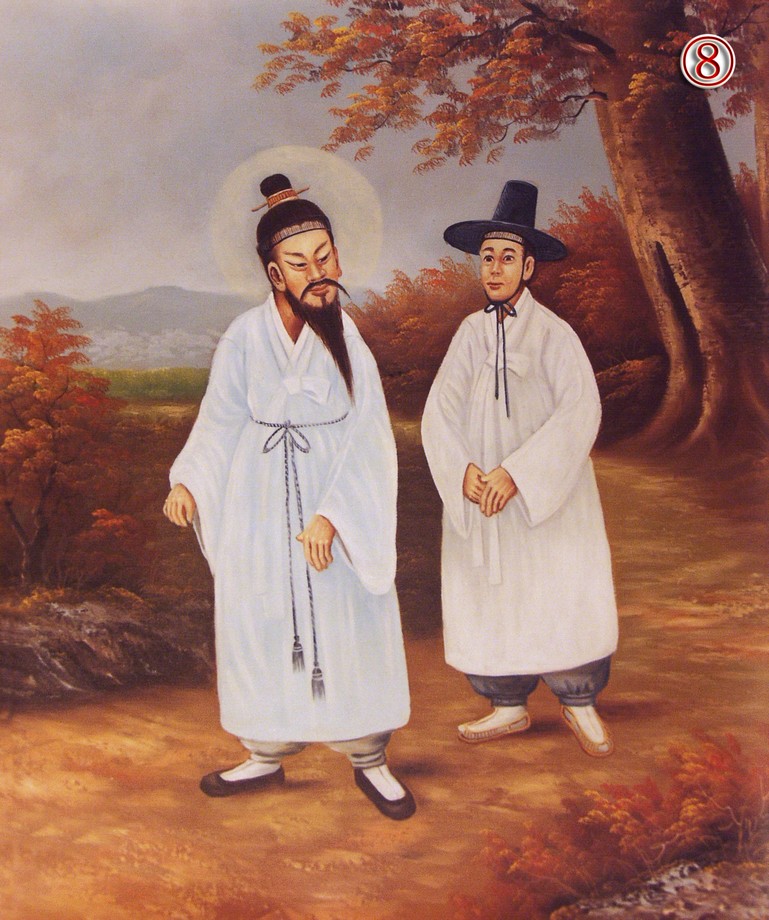
- ⑧ Sangje turned around and said “Do I not look like Guan Yu*?” Upon hearing this, Gong-u was frightened out of His wits.
(* Guan Yu : a fearsome general warrior of the state of Shŭ during the Three Kingdoms Period in China)
One day, on the way to White-Rock (Baekam) Village from New Fence (Saewul) Village of Great Benevolence (Taein) County, accompanied by Gong-Wu, Sangje suddenly transformed His face into Guan Yu's. Turning around, He asked, “Does My face look like Guan Yu's?″ As Gong-Wu was too startled to answer Him, he just hesitated to reply. After Sangje repeatedly asked him three times, he was restored to reason and answered, “You look very similar to Guan Yu.″ Shortly after, Sangje restored His original face and reached Kim Gyeong-Hak's house, where He conducted a Reordering Work. 【Authority and Foreknowledge 1-20】
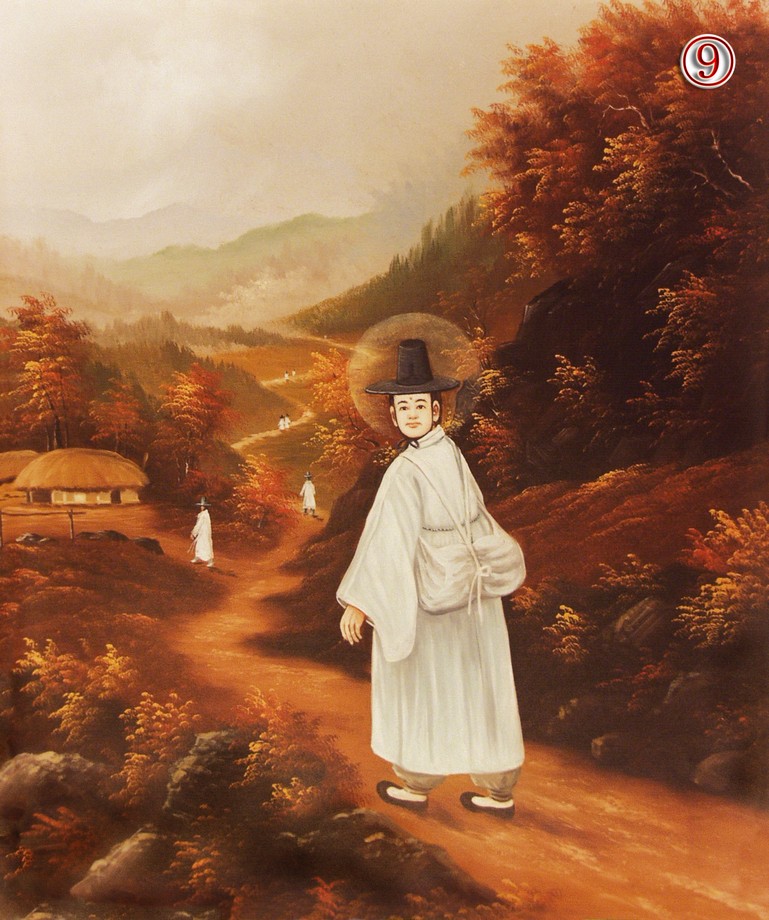
- ⑨ Whenever Sangje would leave a location in the summer, He would raise the winds to drop dew onto the paths He traveled. In winter, He would freeze the wet roads to enable easier crossing.
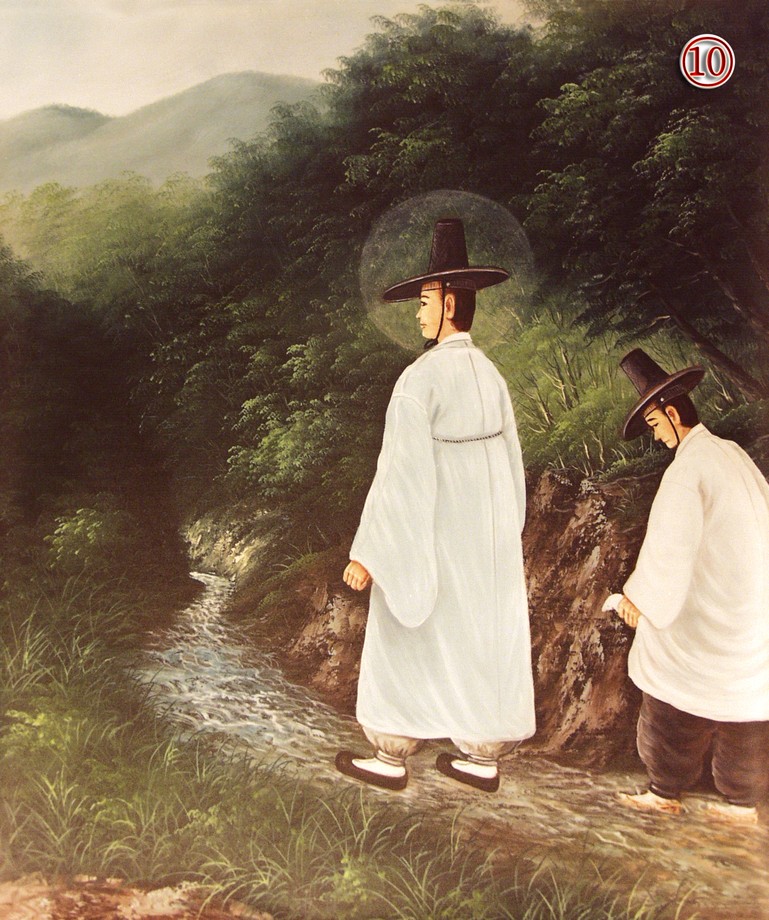
- ⑩ Even while on densely overgrown pathways where mountain streams would flow, Sangje’s shoes would somehow always remain clean, much to the surprise of others.
Sangje always wrote an issued Command to Clean the Roads to divine beings before taking a trip. Since Summer-Cloud (Hawun) Hamlet, at which Sangje had stayed, was located in the middle of mountains, it had narrow, rugged roads which were thick with interlacing branches of trees and grass. When Sangje issued the order, dew sitting on trees was blown off by the wind and fell to the ground in summer, while muddy roads came to be frozen and piled-up snow came to melt in winter. 【Authority and Foreknowledge 1-9】
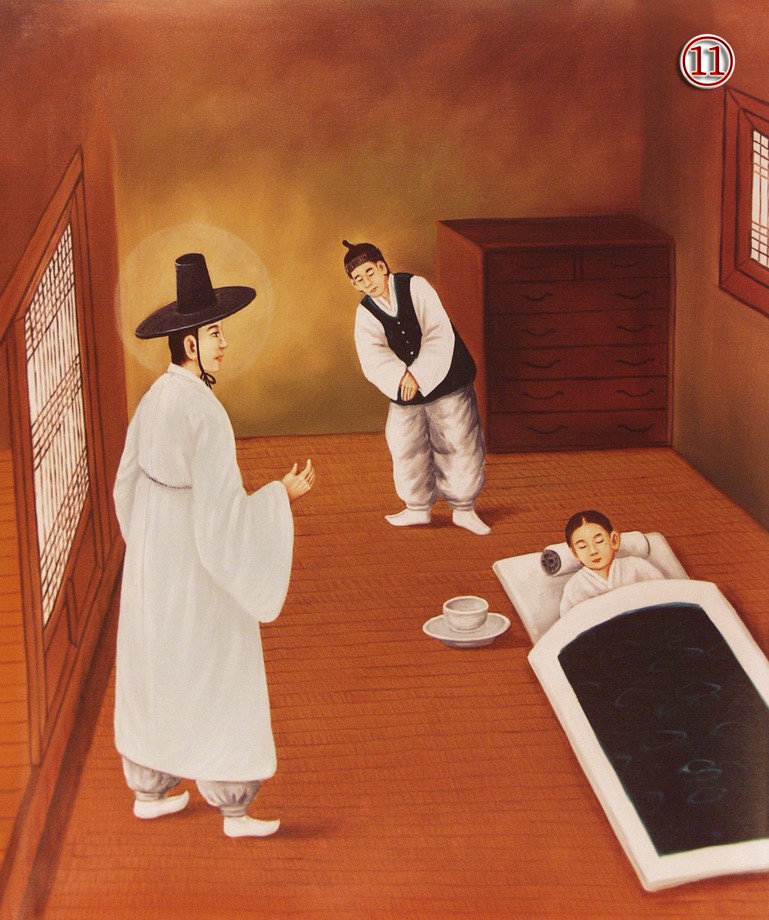
- ⑪ Once He entered the room of Kim Gyeong-hak’s eight year old son who was sick and scolded him, “How dare you not rise to greet your Father?”
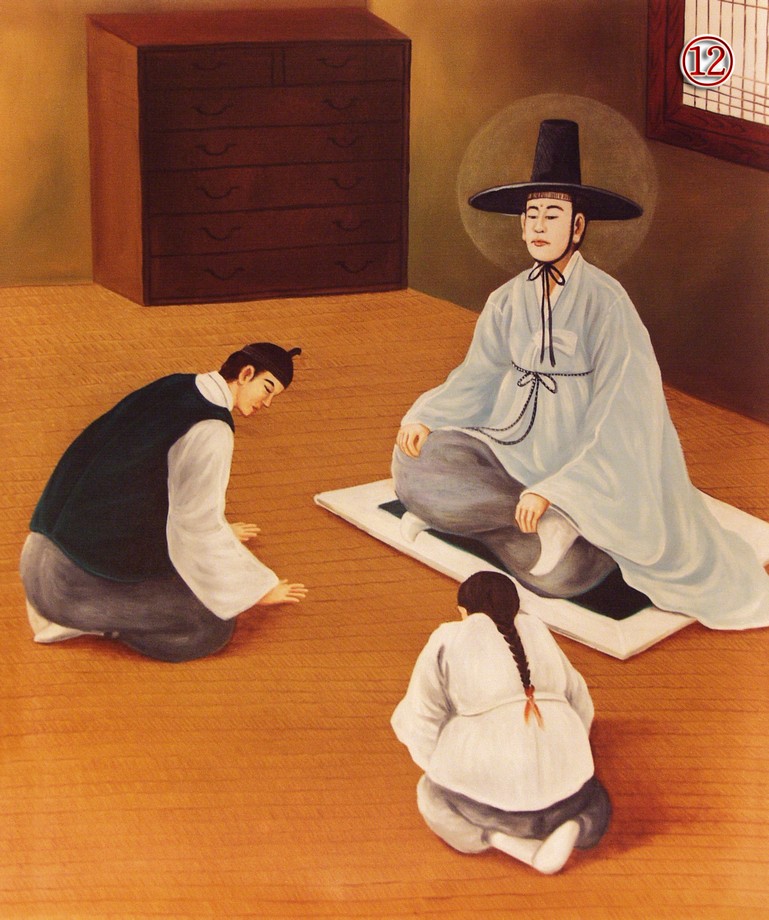
- ⑫ This prompted the son to rise up in fear, and he was miraculously cured shortly thereafter. Kim Gyeongh-hak, wondering why Sangje called Himself the Father of his son, remembered a past incident. According to customs of that time, he offered his son to the Maitreya Buddha at Geumsansa Temple. It was only then, that Gyeong-hak realized that Sangje Himself was Maitreya.
5. Curing the Sick
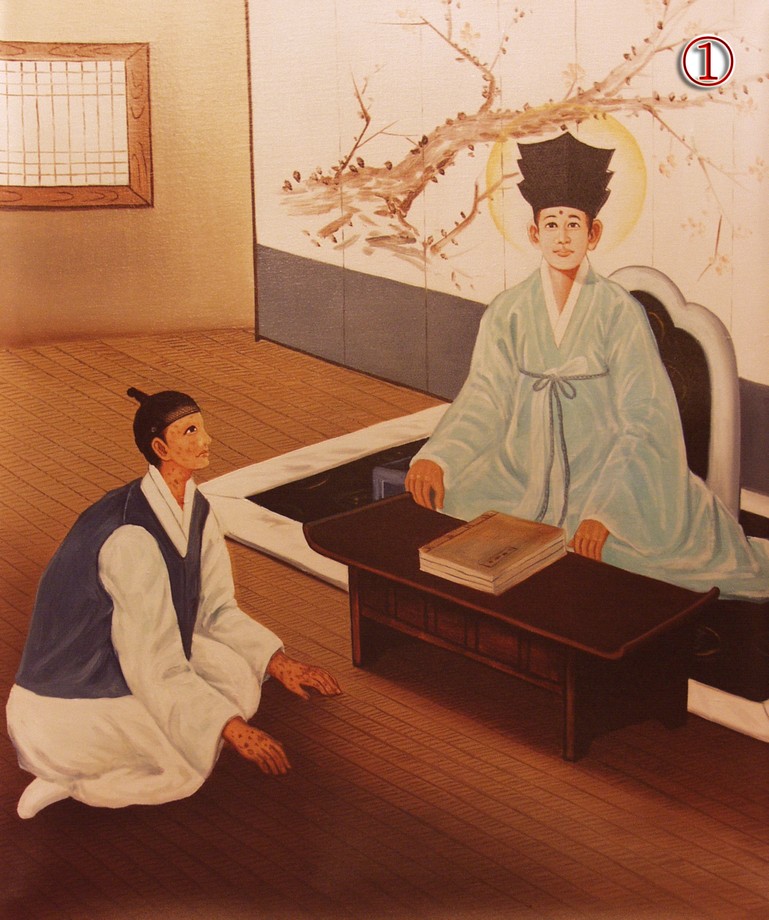
- ① Kim Gap-jin who lived in Dong-gok Valley had been suffering from leprosy for a long time, causing facial swelling and hair loss affecting his eyebrows. He pleaded to Sangje for a cure.

- ② Sangje had Kim Gap-jin stand outside the door facing the room and sent him back home. Gap-jin made a complete recovery thereafter.
Kim Gap-Jin of Copper Valley (Donggok) Village was a leper whose face had swollen and whose eyebrows had fallen out. One day, he came to Sangje to beg for treatment. Sangje had Gap-Jin stand toward the room from the outside of the door and told Hyeong-Ryeol and several others to recite the commentary preceding the first chapter in The Great Learning. Sangje sent Gap-Jin back after about ten minutes. After that, Gap-Jin felt refreshed and the swelling went down. His leprosy was completely cured. 【Saving Lives 14】
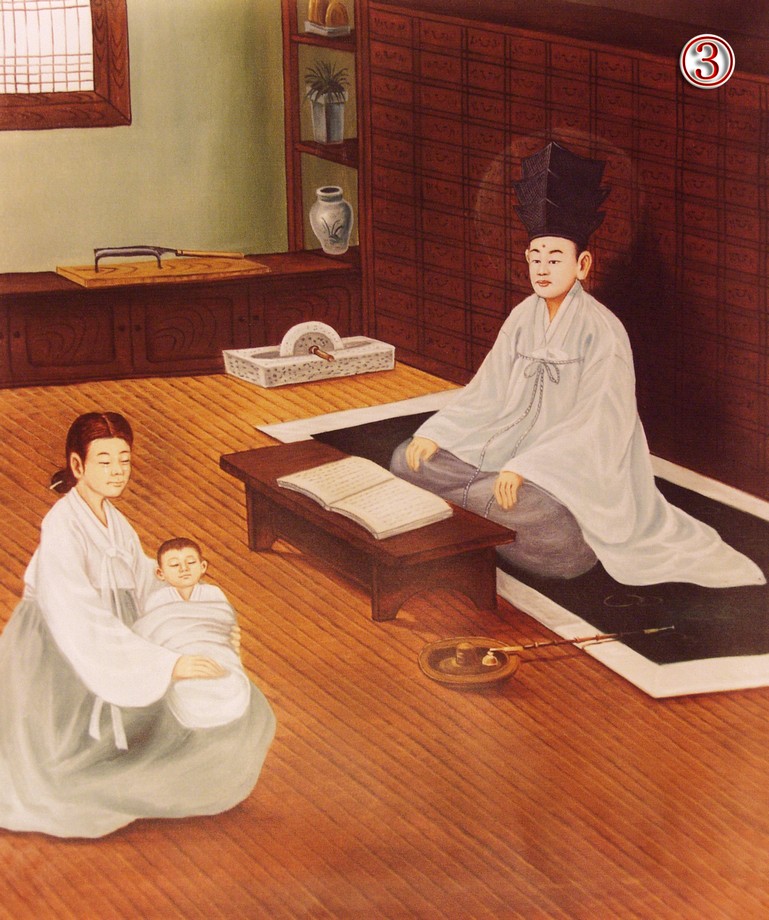
- ③ Kim Sa-myeong, living in Dong-gok Valley, had a six year old son, Seong-ok, who had died from a sudden illness. His mother brought her son to Sangje and begged Him to spare his life.
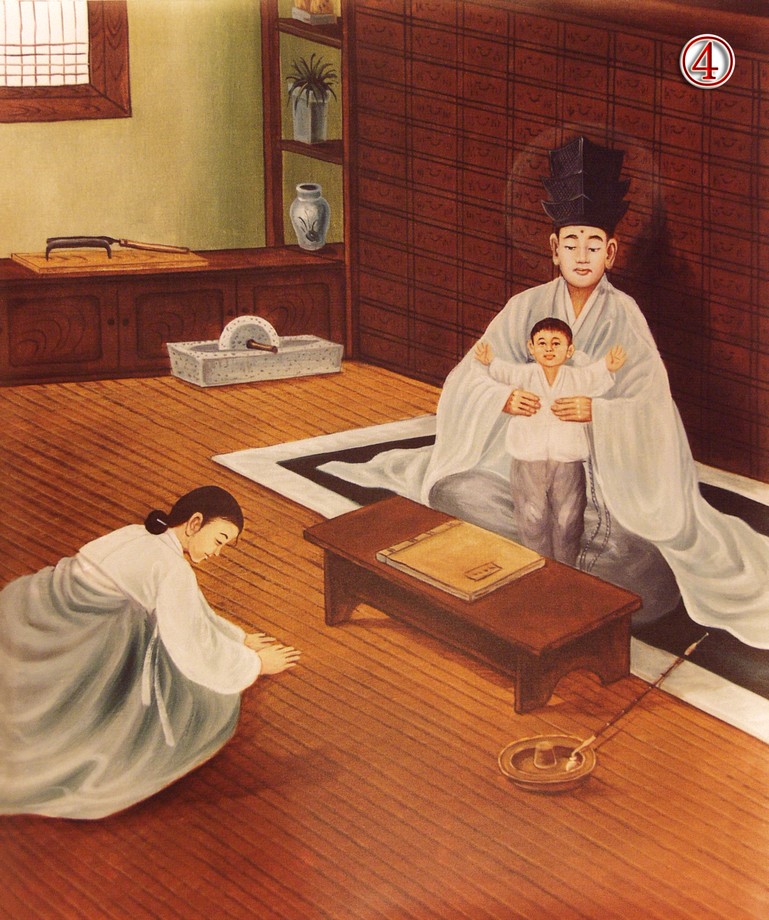
- ④ Sangje chuckled and took the son into His embrace, the son came back to life shortly thereafter.
While Sangje stayed at the Copper Valley (Donggok) Clinic, Kim Sa-Myeong, who was a tavern-keeper in Copper Valley Village, tried to revive his son, Seong-Ok, who had died suddenly, over half a day prior. However, there was no sign of the son coming back to life. Then, his wife went to visit the clinic, carrying their child on her back. Sangje, who already knew of her visit, said, “The good fortune of our clinic has been affected by a blockage. A dead one is being carried here on someone's back.″ Seong-Ok's mother laid her dead child in front of Sangje and begged for his life, shedding tears. Sangje put the dead boy on His laps with a smile and, rubbing down his abdomen, He shouted toward the sky, “Have Misu bring Wuam.″ He then dribbled His own saliva into the dead child's mouth, and suddenly, some decomposed fluid gushed out of the boy's anus and he began crying out as he awakened from death. After drinking the rice gruel he had been given, he went back home on foot. 【Saving Lives 9】
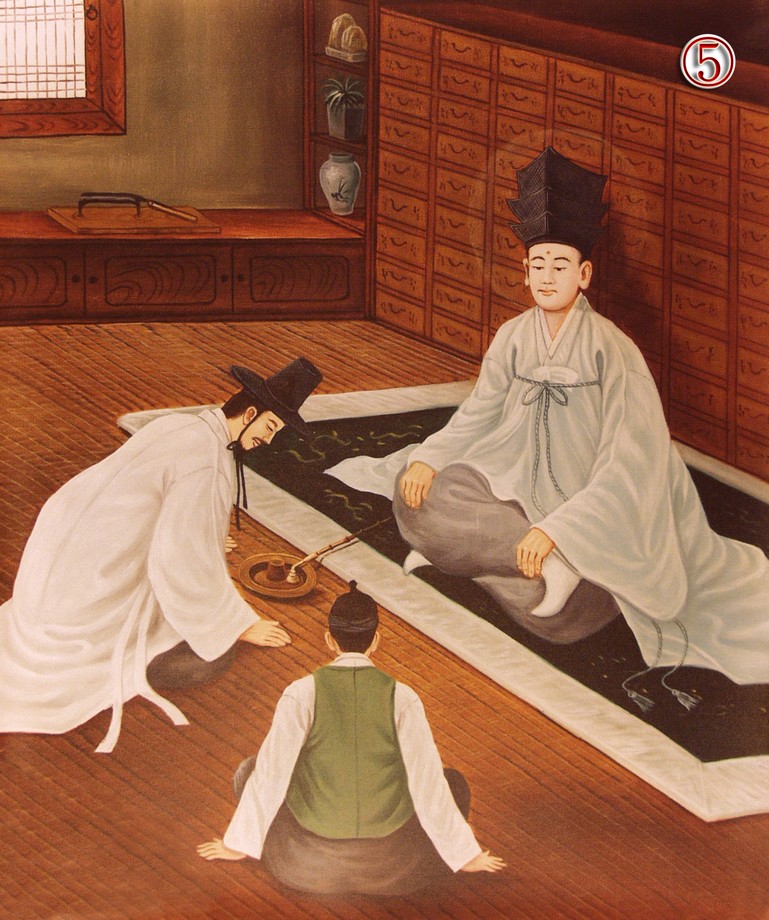
- ⑤ One day, a crippled person with the surname 'Kim' from Yongduchi came to see Sangje and imploringly asked Sangje to make him walk again.
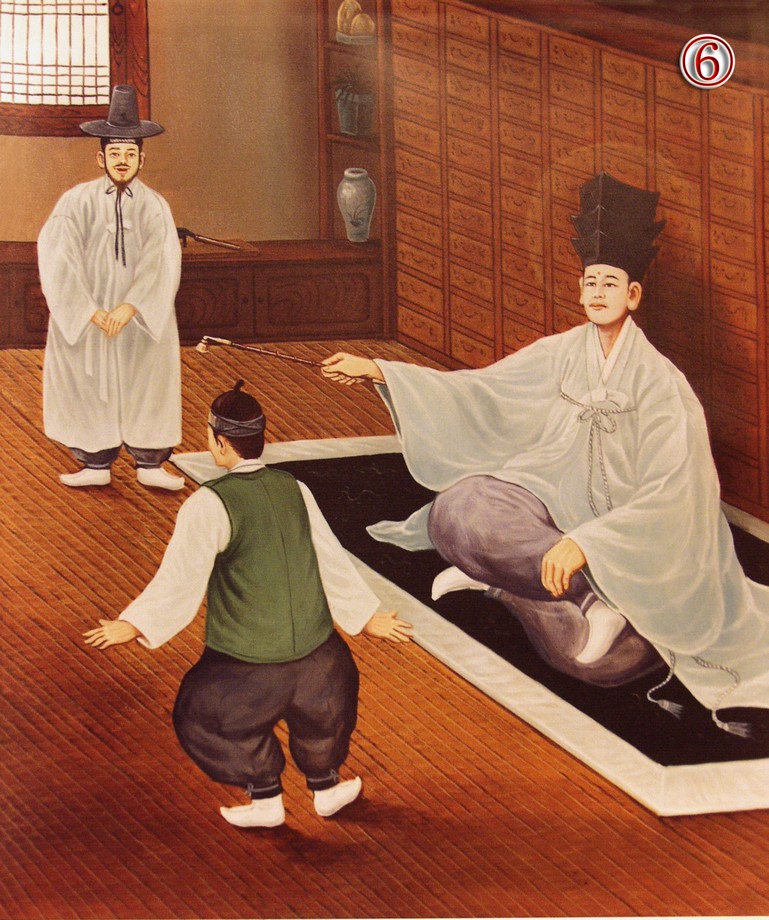
- ⑥ Sangje seated the man in front of Him and told him to stand up whilst Sangje lifted up a pipe. Following the motion of the pipe, his crippled knees and legs steadily straightened as he rose to his feet. Sangje told Gwang-chan sitting nearby to strike the man’s calves. After having done so, the man was no longer crippled and walked away freely.
There lived a crippled man named Kim in Dragon Head Hill-Path (Yongdu-chi), who could only move around via a sedan chair. One day, he paid a visit to beg Sangje to make him walk again. Sangje had the man sit in front of Him and ordered him to stand up as He moved His tobacco pipe. While Sangje lifted the pipe higher and higher for the man to try to rise from the ground, He had Hyeong-Ryeol recite: Ye-go-shin ye-paeng-shin seok-nan-shin dong-seo-nam-buk-jung-ang-shin-jang jo-hwa-jo-hwa un-oh-myeong-ryeong-hum [曳鼓神曳彭神石蘭神東西南北中央神將造化造化云吾命令吽 Drum-Carrying God, Drum-Playing God, Orchid-on-Rock God, and the Divine Generals of North, East, West, South and Center, through creation and transformation, perform my command. Hum]. Sangje told him to stand and walk out into the yard and had Gwang-Chan slap the man on the calves to make him walk faster. Finally, the crippled man walked back home, on his own, not needing the sedan chair. Afterward, he gave Sangje 30 nyang as a token of his gratitude. Sangje bought food and wine for passers-by with the money, while the man expressed his thanks to Sangje in front of the passers-by for having treated his legs. 【Saving Lives 11】
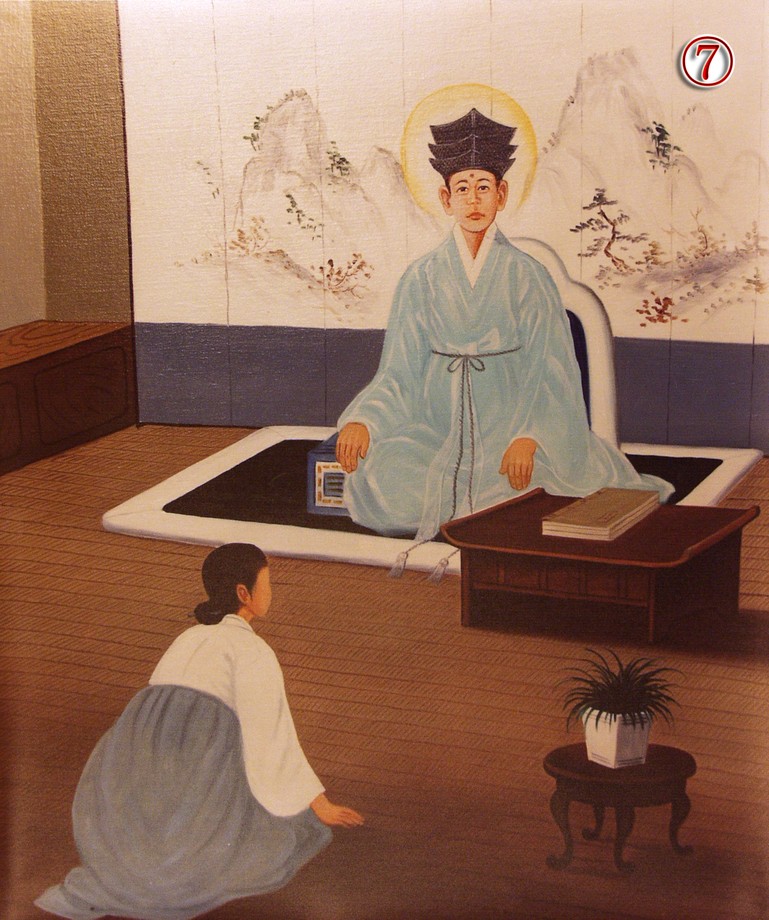
- ⑦ An official with the surname 'Oh' from Hwang-gyo, Gyeongseong had a wife who had been blind ever since she was young. The wife pleaded to Sangje to cure her blindness.

- ⑧ When Sangje arrived at the doors of the blind wife’s chambers, He drew a circle on the ground with His umbrella and had her eat some white salt. This brought sight back to her eyes.
Gap-Chil tried to endure his diarrhea from the time he left Jeonju (Perfected Territory) County, but in the end he told Sangje about it. Sangje said, “From now on, the diarrhea shall dissipate, and you shall recover your appetite,″ laughing out loud. Gap-Chil's confidence in Sangje's divinity stopped his diarrhea. One day when Sangje was practicing many Reordering Works in Seoul, the wife of Oh Ui-Gwan, who recovered from asthma, was blind as a bat due to amaurosis, a chronic eye disease. She begged Sangje to treat her disease as well. While in the yard, He went to the window of the room in which the woman stayed, stood face-to-face with her, and then drew a circle on the ground with the point of a parasol. Then He came back. After that, her eyesight was restored. Oh Ui-Gwan and his wife were moved to tears and they went on to serve Sangje with all their hearts. 【Reordering Works 1-21】
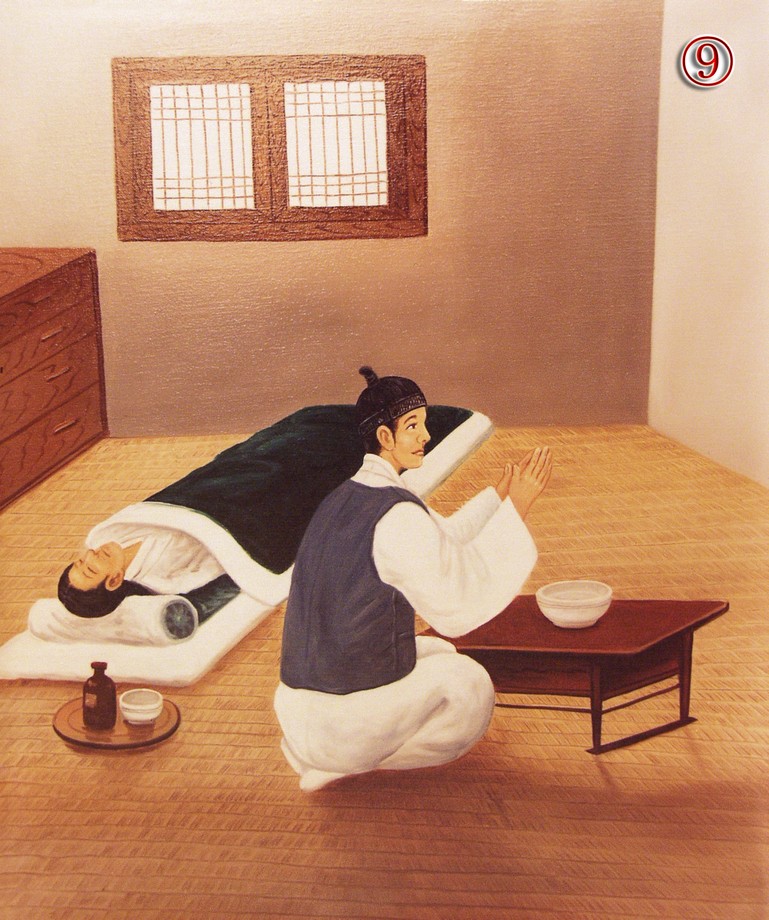
- ⑨ Hwang Eung-jong’s son fell into a critical condition. Eung-jong drew a bowl of fresh water, set it on a table, and prayed in the direction where Sangje resided. This cured his son.

- ⑩ The next day, Eung-jong went to see Sangje who then asked, “I saw your hands joined in prayer when I looked down from the clouds. What happened?”.

- ⑪ Sangje made a herb name plate out of a chestnut tree at the Donggok Valley Clinic (apothecary). On it He wrote Man-guk (all the nations) Clinic and gave it to Park Gong-u to hang on the wall at Wonpyeong Market.
Then He asked Gong-u, “What would you say if the officer asks about it?”
Gong-u replied, “I would say You established Man-guk Clinic, a clinic wherein the blind, crippled, humpbacked, and all other patients with various illnesses are cured.”
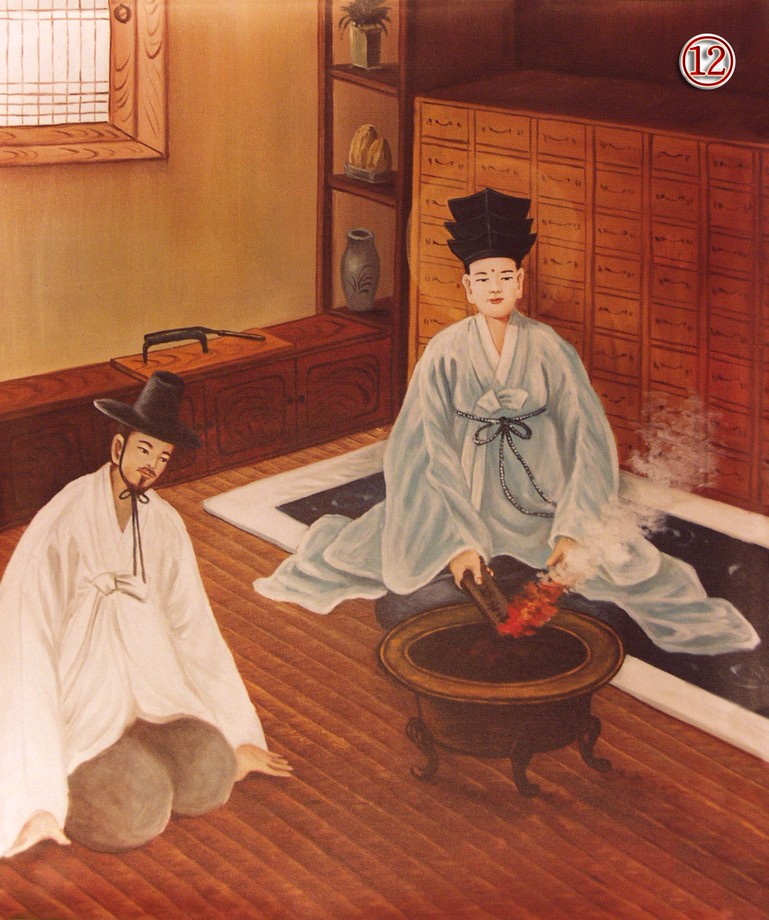
- ⑫ Upon hearing this, Sangje said, “You are right” and burnt the name plate.
6. Resolution of Grievances
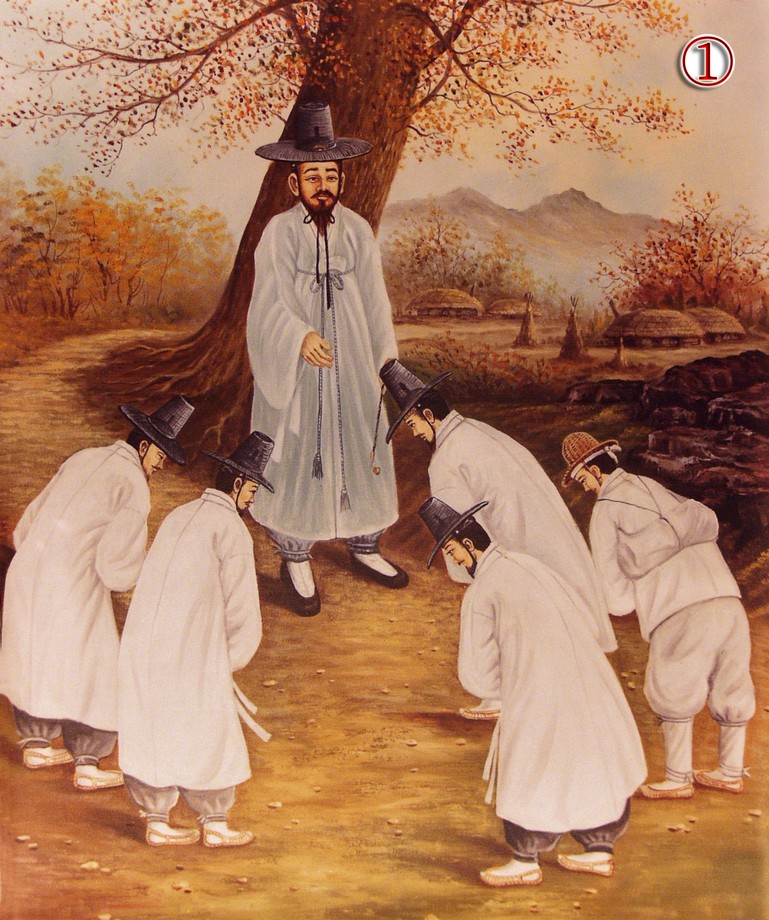
- ① Bansang refers to the classes of noblemen and commoners. Commoners were not allowed to study or speak out in front of nobles.
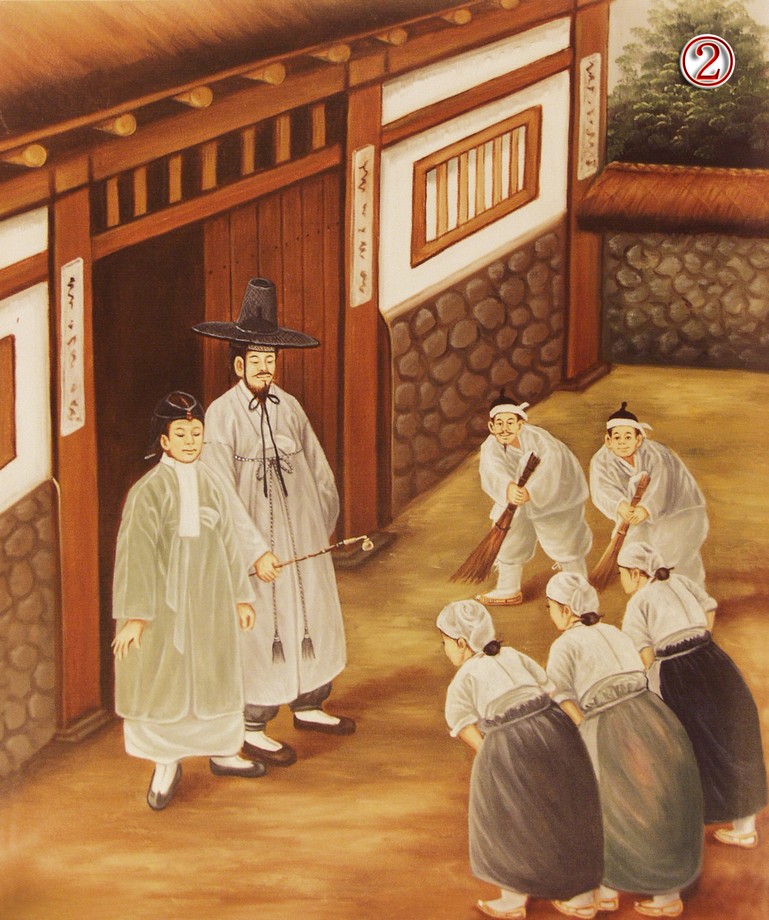
- ② Whether they were right or wrong, the commoners were told that their duty was to obey the noblemen. This convention was enforced by the law system of the time.
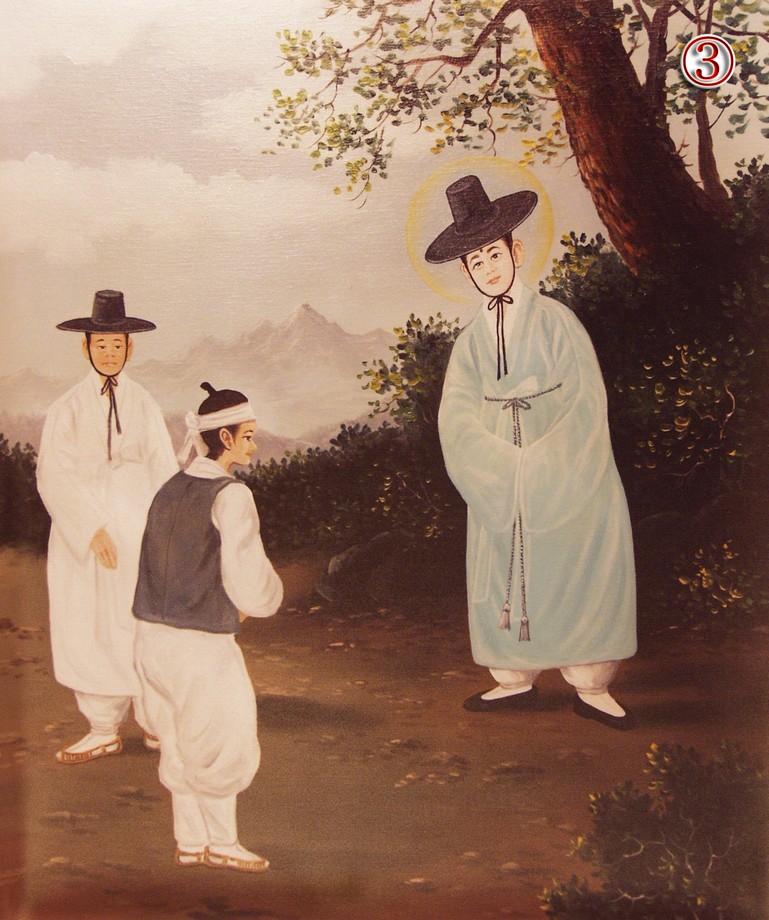
- ③ Sangje used honorific language when He spoke to Kim Hyeong-ryeol servant, Ji Nam-sik.
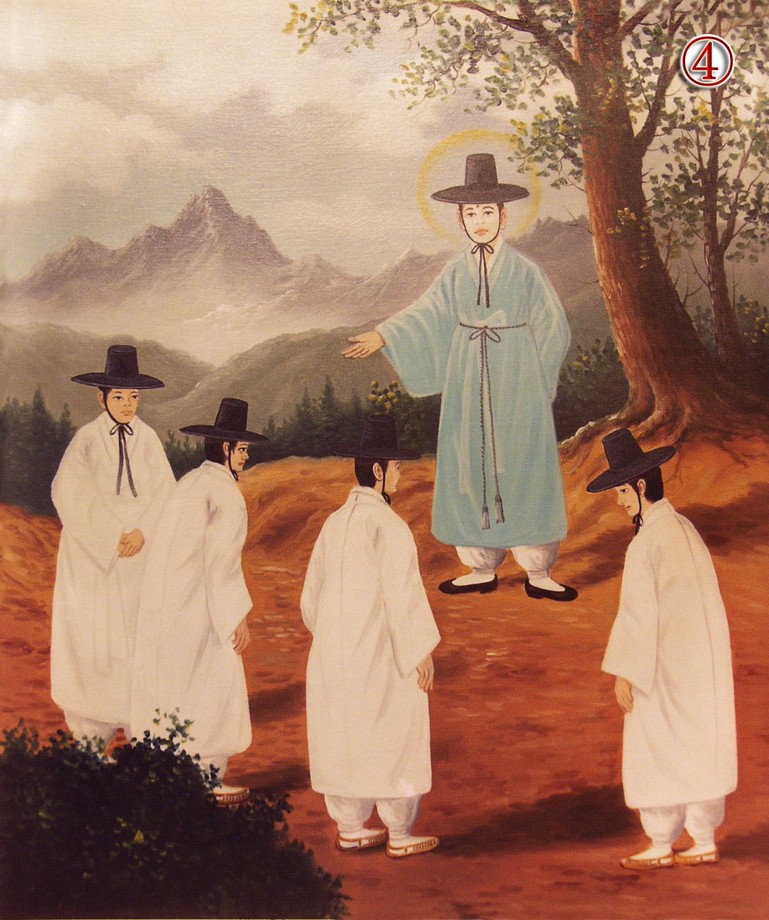
- ④ Sangje told Kim Hyeong-ryeol that he should use honorific language with everyone everywhere.
Sangje always used honorifics even to low-born people. Kim Hyeong-Ryeol, feeling quite uncomfortable that Sangje always used honorific language with his servant Ji Nam-Sik, asked, “This man is my servant, so please talk to him in the informal way.″ At this, Sangje said, “The man is just your servant. Not mine. In this countryside, it may be difficult for you to break the habit because you have used those expressions since early years. But when you go to another village, respect all you meet. From now on, there will be no distinction between legitimate and illegitimate children and no discrimination between the gentry and the low-born.″ 【Dharma 1-10】

- ⑤ Jeokja is a word to describe the offspring of a man’s legal wife, whereas seoja refers to the offspring of a concubine. Offsprings born from concubines were not recognized no matter how outstanding their talents were. Also, they were not given any formal education.

- ⑥ During memorial rites for ancestors, the offsprings of concubines could only attend the service from outside the chambers, in the yard.

- ⑦ Sangje stated that the idea of the predominance of men over women should be banned and demonstrated this Himself by giving way to women.
Sangje said to Park Gong-Wu, “Now is an era of grievance resolution. I removed the distinction between men and women so they can do as they like. However, I will re-establish propriety by correcting the positions of Geon (乾, sky) and Gon (坤, earth) in due time.″ When Gong-Wu was accompanying Sangje through the downtown area of Great Benevolence (Taein), two elderly women were about to cross His path. Then Sangje stepped aside to let them through 【Reordering Works 1-32】
In the Later World, a woman's accomplishments shall also be acknowledged depending on her cultivation. Because of this, the custom of the predominance of men over women, which has existed from the ancient times, shall be abolished. 【Dharma 1-68】

- ⑧ He also wrote Yeojanggun (women warriors) on a piece of paper and burnt it, thereby empowering women with vigor.
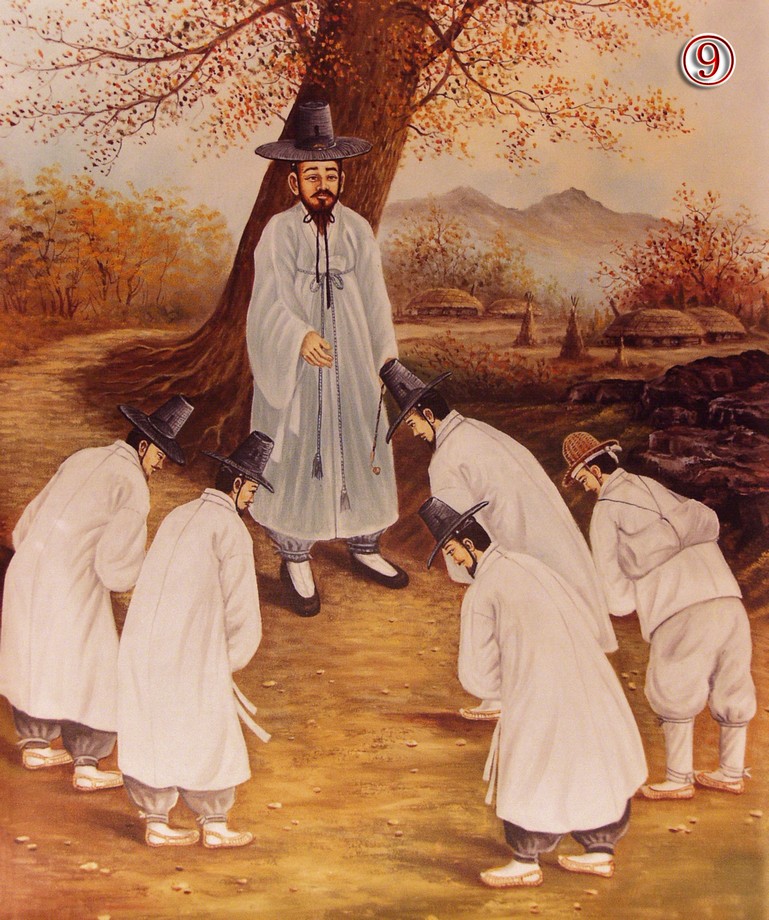
- ⑨ Sangje revealed that He would eliminate the discrimination between commoners and noblemen, the unfair advantages given to offsprings of legal wives but not to those of concubines, and also the preferential treatment of men over women.
When Baek Yong-Ahn, one of Baek Nam-Shin's relatives, acquired an exclusive license for the wholesale of wine from the local government, hundreds of small taverns in Jeonju (Perfected Territory) County were forced to shut down. Sangje, who was staying at Kim Ju-Bo's tavern in Dragon Head Hill-Path (Yongdu-chi) at that time, heard his wife let out a wail, pound her chest, and yell, “We have subsisted by selling wine without another source of income. Now that this is prohibited, how can my family make a living?″ He took pity on her and said to His disciples, “How can there be only male generals? There are female generals as well.″ And then Sangje wrote 'Female General' on paper and burned it. All of the sudden, Ju-Bo's wife gained vigor, rushed outside, and shouted out loud. As the female tavern-keepers quickly gathered together and attacked Baek Yong-Ahn's house, the situation turned threatening. After Yong-Ahn, who was so frustrated, apologized to the tavern-keepers and promised to give up his wholesale tavern, they finally returned. Yong-Ahn closed down his tavern soon after. 【Authority and Foreknowledge 1-17】
7. Mutual Beneficence
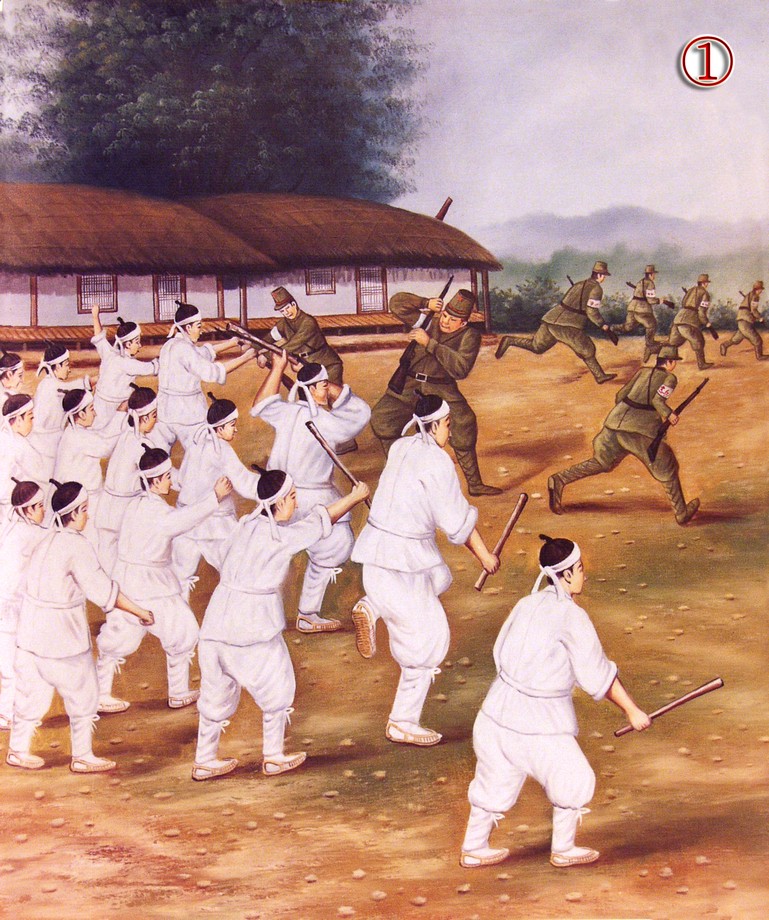
- ① Powerful government officials were embroiled in factional strife and were only interested in multiplying their wealth through trafficking seats in government offices.
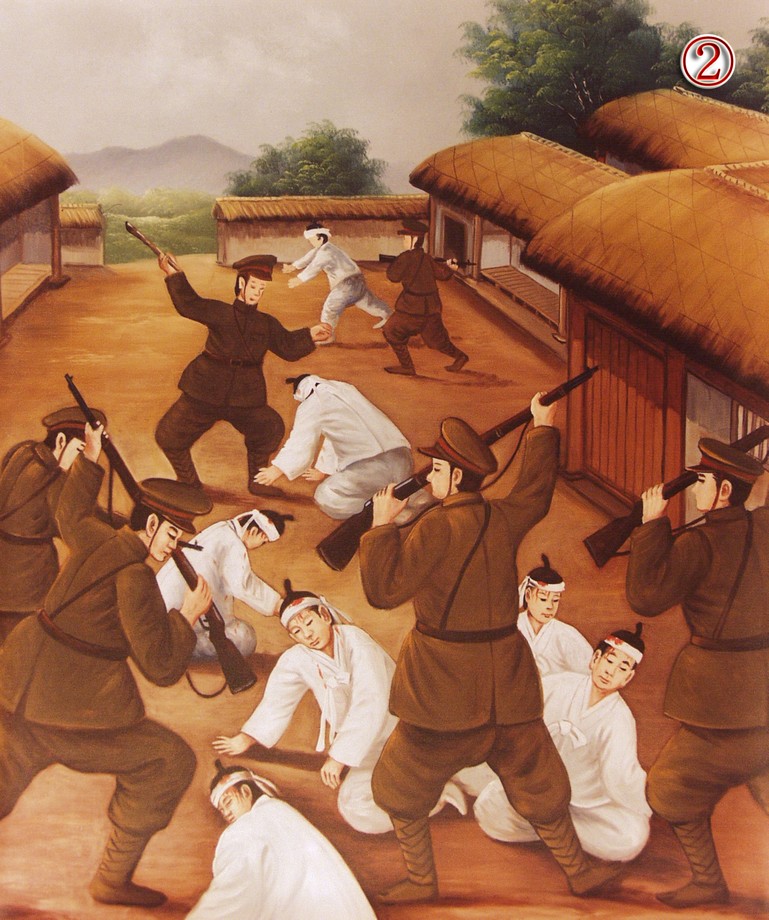
- ② The Japanese employed armed forces and violent tactics to attain their covetous ambitions.
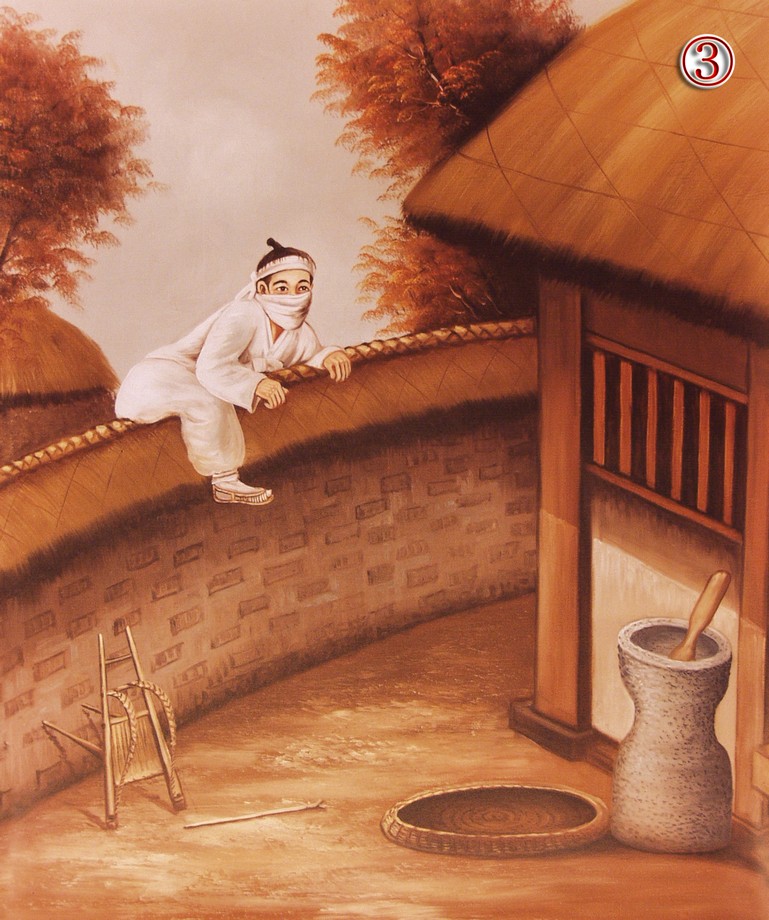
- ③ The civilians were caught up in their greed, and thereby habitually fell into conflicts among themselves and committed robberies against one another.
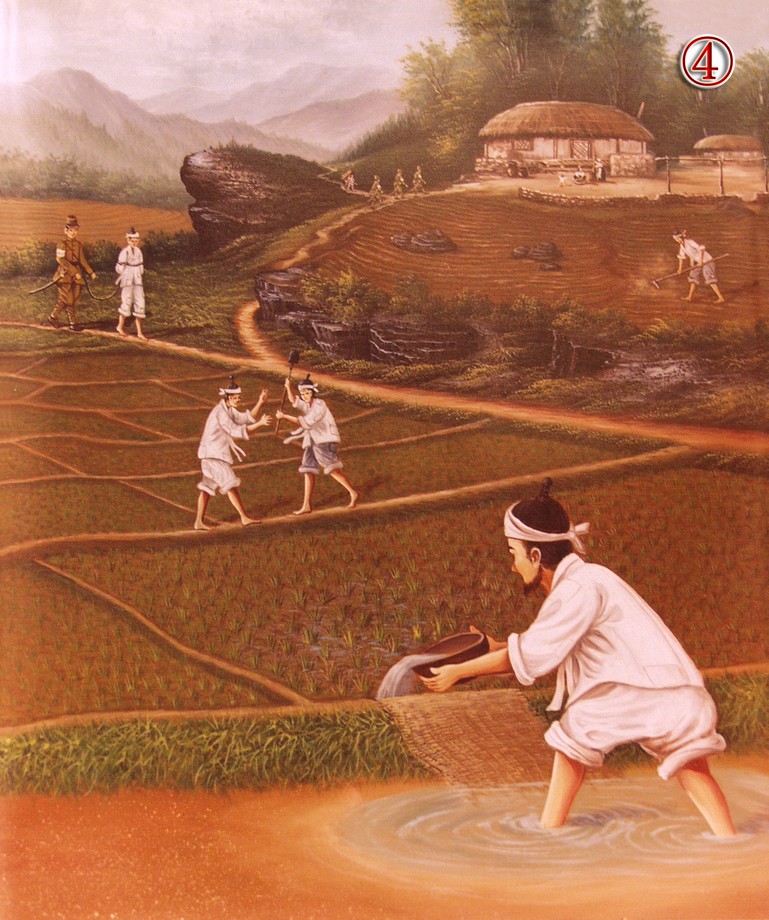
- ④ Even the weather was rough and unforgiving. Society had fallen into chaos.
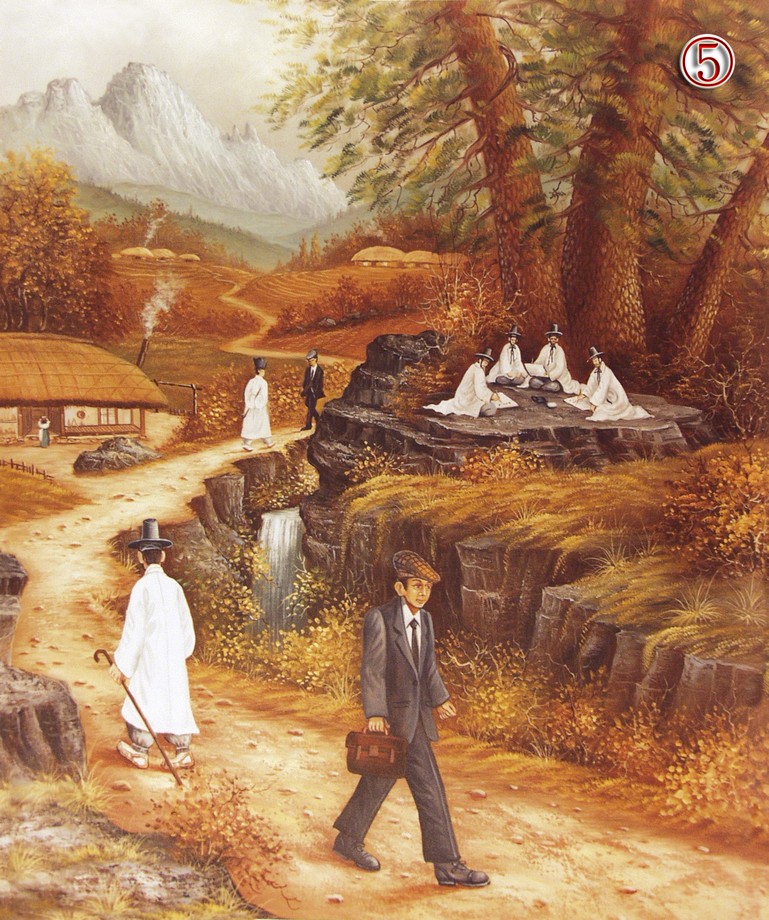
- ⑤ One day Sangje asked, “How would you usually address Me?”
Gwang-chan replied “I would address you as Chon-yangban (a nobleman from a rural area)”.
Sangje again questioned, “How do rural noblemen address you?”
Gwang-chan again replied, “They call me an Uepnae-ajeon (a petty official in an urban area).”
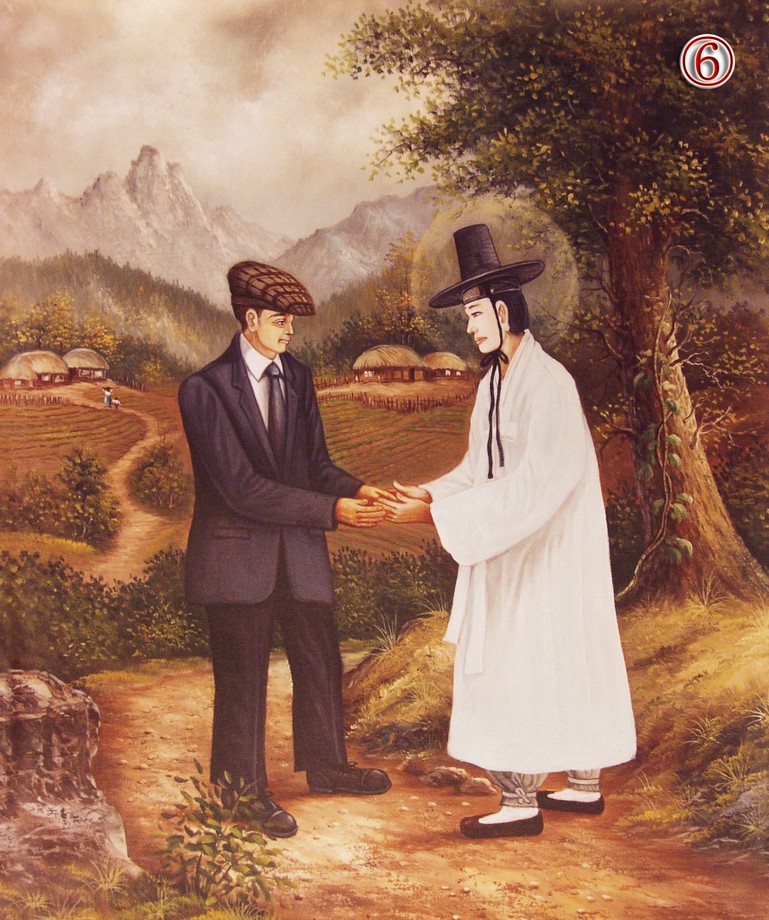
- ⑥ Sangje asserted, “A rural nobleman calls a town official a bastard town official, while a town official calls a rural nobleman a bastard nobleman. They do this to express dissatisfaction with discriminatory customs. If you and I reconcile with each other, all grievances of the world shall be brought unto resolution.”

- ⑦ Sangje ordered Kim Hyeong-ryeol and Kim Gap-chil to make one paper lamp and one pair of straw shoes everyday for forty nine days. On the 49th day, 49 paper lamps and 49 pairs of straw shoes had been made.
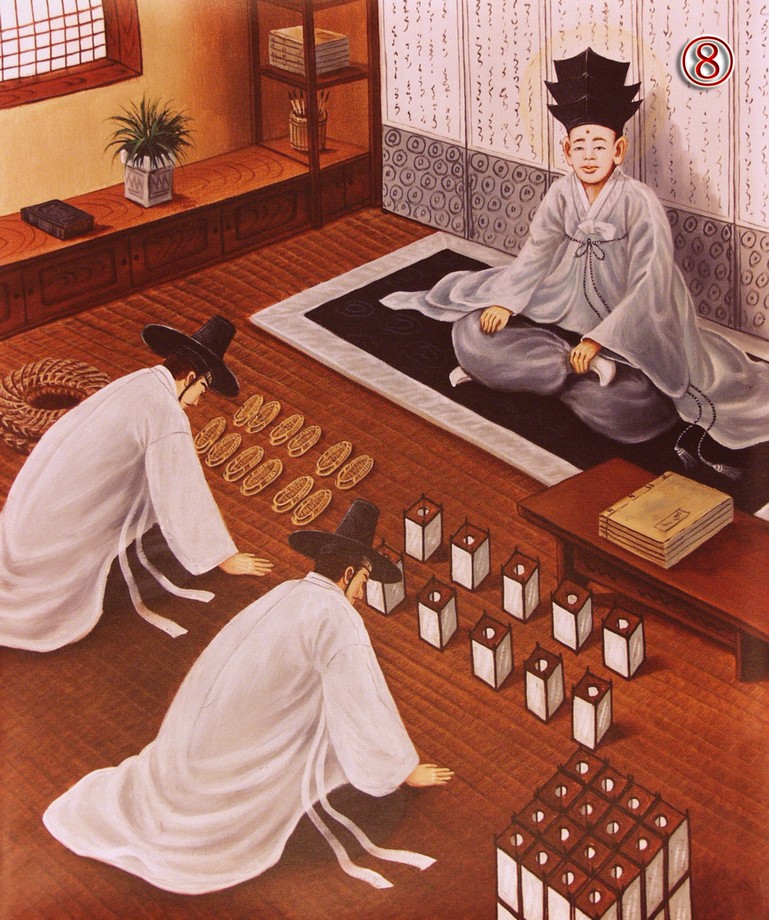
- ⑧ They placed these in front of Sangje and He stated, “The shoes shall be worn by all the people in the world and the lanterns shall light up the darkness of all the people.” Then He sold the straw shoes and burnt the paper lamps.
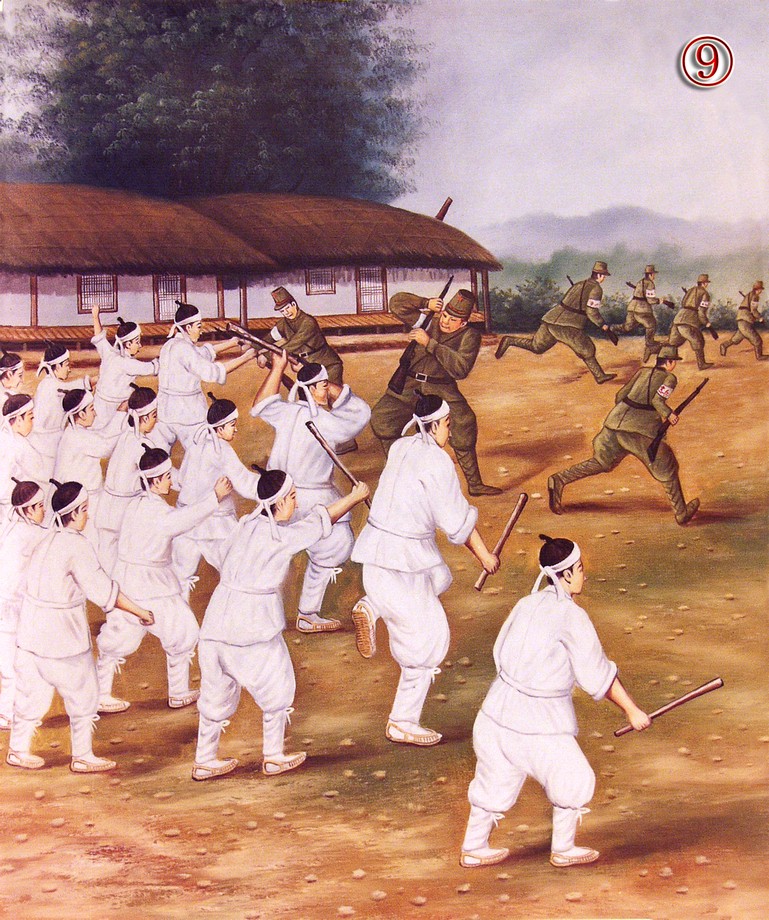
- ⑨ Sangje lectured to His followers saying “Mutual contention have been ruling the human world as human beings have been captivated by the envy, jealousy, and scheming that is caused by their greed. They have been living under grudges and inequality caused by discrimination. Therefore, I came to this world in order to rectify the Heaven and Earth that had lost its way and form an Earthly Paradise devoid of mutual contention.”
In the beginning of the third month during the Jeongmi Year (1907), Sangje was accompanied by Gwang-Chan and intended to enter Last Island (Maljeom-do), where Gwang-Chan's second cousin earned a living through fishing. He called Gap-Chil and Hyeong-Ryeol to South Port (Nampo) in Myriad Furrows (Man-gyeong) County. Sangje said, “I am entering this island in self-imposed exile due to the Reordering Works of Heaven and Earth. You must go to Seong-Baek's house and make a pair of straw shoes and a paper lantern with him each day for 49 days. The shoes shall be worn by all the people in the world and the lanterns shall illuminate the darkness hindering all people. ″ The two men followed His orders. Then Sangje came out of Last Island and had them sell the straw shoes at the market in Court-Plain (Wonpyeong) Village, while He wrote '陰陽 (yin-yang) ' on each of the lanterns and burned them. 【Reordering Works 2-1】
8. Transferring of Orthodox Religious Authority

- ① In Kim Gyeong-hak’s house Sangje declared: “Now is the Era of the Resolution of Grievances. Therefore, I will first give teachings to those who are least privileged.” He called six shamans and took off their hats and headbands.

- ② Then, He drew a fresh bowl of water, placed it on a table and had the shamans bow four times while facing the enshrined water. He then had them read the Sicheonju incantation three times.
Sangje decided to choose Kim Gyeong-Hak's house as the school of the greatest learning and said, “This school is great. Since we are in the era of grievance resolution, I shall pass My teaching to the people of low birth first.″ He instructed Gyeong-Hak to bring six mudangs (Korean shamans). Then He had each mudang take off their ritual hat (gwan-geon), place a bowl of fresh water on themselves, bow down four times towards the water, and follow Him in reciting the Incantation of Serving the Lord of Heaven (Sicheon-ju 侍天呪) three times each. After finishing this, Sangje asked for their names and told them to drink the fresh water. And Sangje said, “This was a bestowal of blessings and fortune.″ It was the event when He propagated His teaching to the humble first during the era of grievance resolution. 【Progress of the Order 1-32】
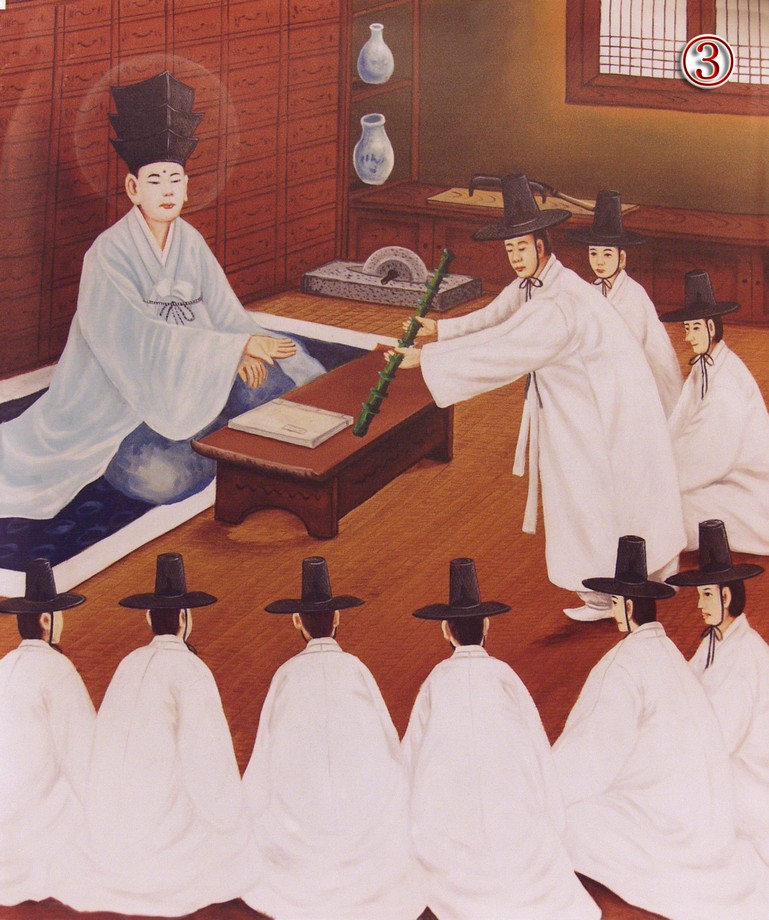
- ③ Sangje ordered nine of His followers to sit in a row inside Donggok Clinic (apothecary). Then He asked Gap-chil to cut off a branch of green bamboo whatever length he pleased. When Gap-chil brought the bamboo back they found out it now had ten segments.
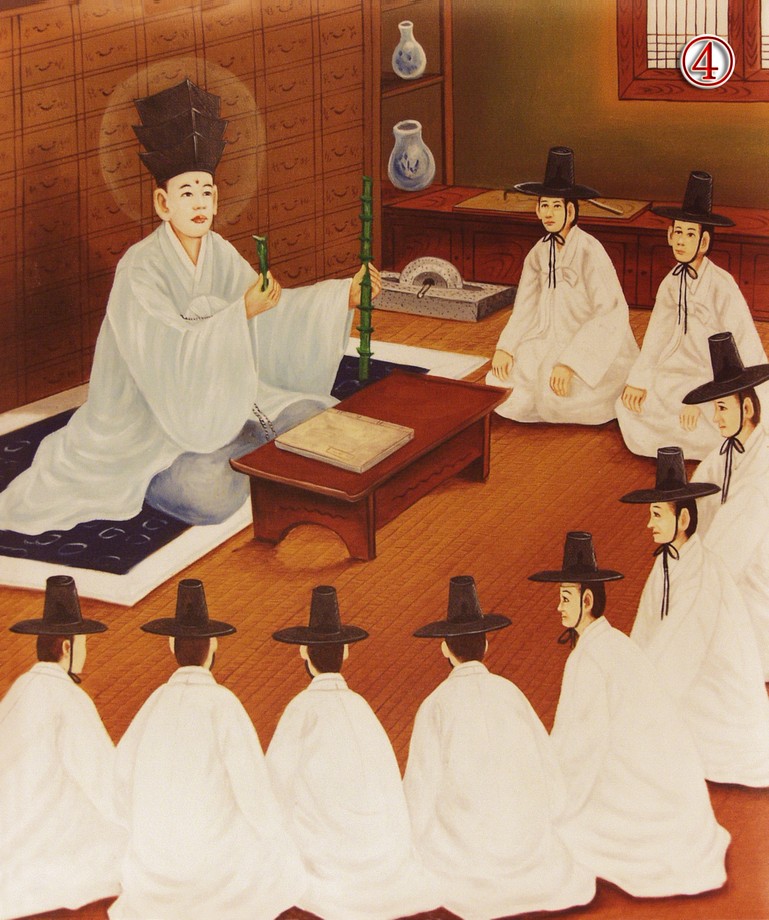
- ④ Cutting off the largest segment, Sangje held it up and said, “This segment is the Great Leader. The Great Leader will have no limitations when exerting supernatural power and knowledge. The rest of the bamboo segments are its Dao cohorts.”
While staying in Copper Valley (Donggok) Village, Sangje practiced the Reordering Works of the progress of the order. After seating nine disciples side by side in a row, He ordered Gap-Chil to cut down whichever green bamboo stalk he wanted and bring it back to the group. There were ten joints in the bamboo that had been cut by Gap-Chil. Sangje cut off one of the joints and said, “This one is a head that will come and go between life and death and circulate around at will. The nine joints left corresponds to the number of people who receive teachings. Go out and look at how many stars have appeared in the sky.″ Going outside and coming in, Gap-Chil reported, “The sky is filled with clouds, but nine stars are seen twinkling as they cut through the middle of the clouds.″ Sangje said, “This corresponds to the number of people who receive teachings.″ 【Progress of the Order 1-38】
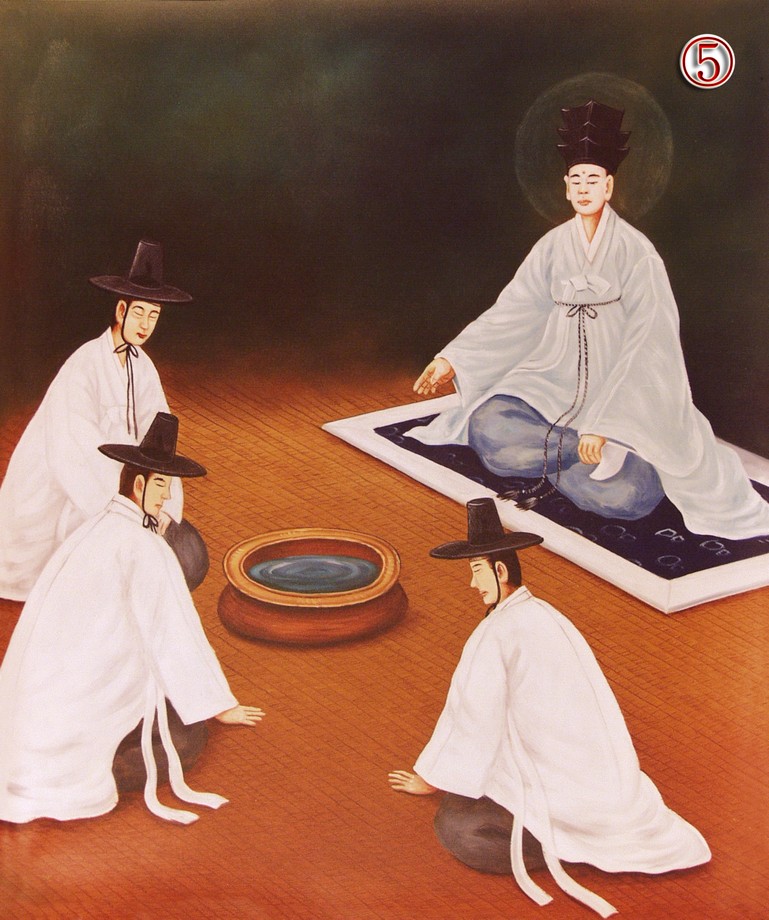
- ⑤ One day, Sangje said “I will show you how my teachings are to be transmitted in the future.” And then He told His Dao cohorts to bring a basin of water and look into the water while closing their eyes.

- ⑥ When the Dao cohorts looked into the water with their eyes closed, it turned into an ocean where the head of a snake and the tail of a dragon meander in the waters. As they described what they had seen to Sangje, He said “My Works are just like that of a humble snake’s head on a dragon’s colossal body.”
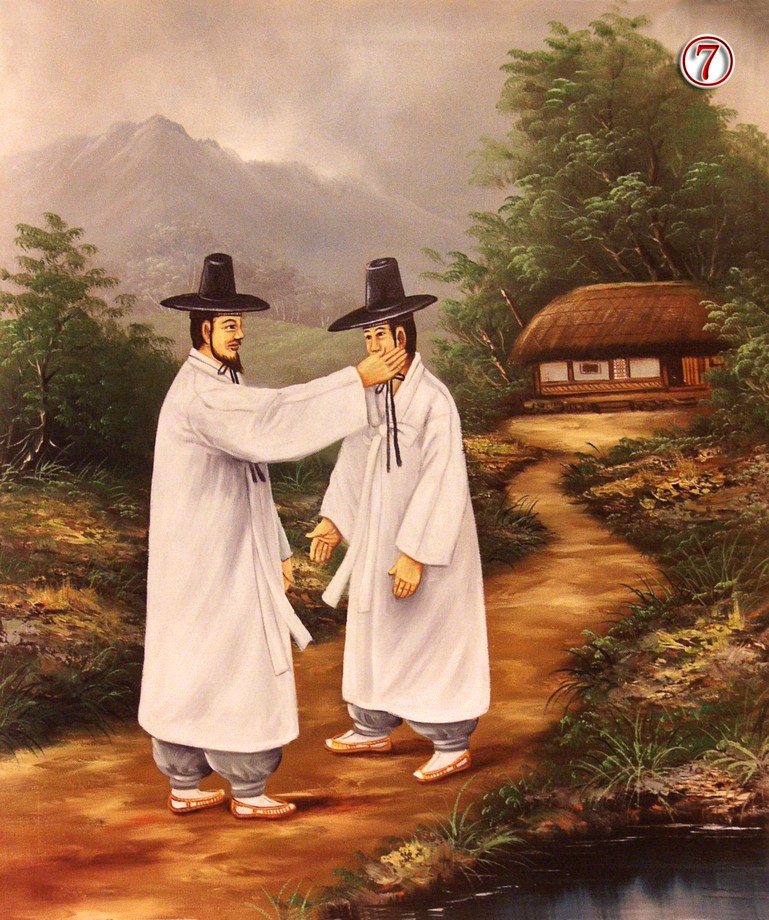
- ⑦ Sangje always preached to His Dao cohorts, “Even if you have been struck by a person,

- ⑧ comfort him by stroking his hand.”
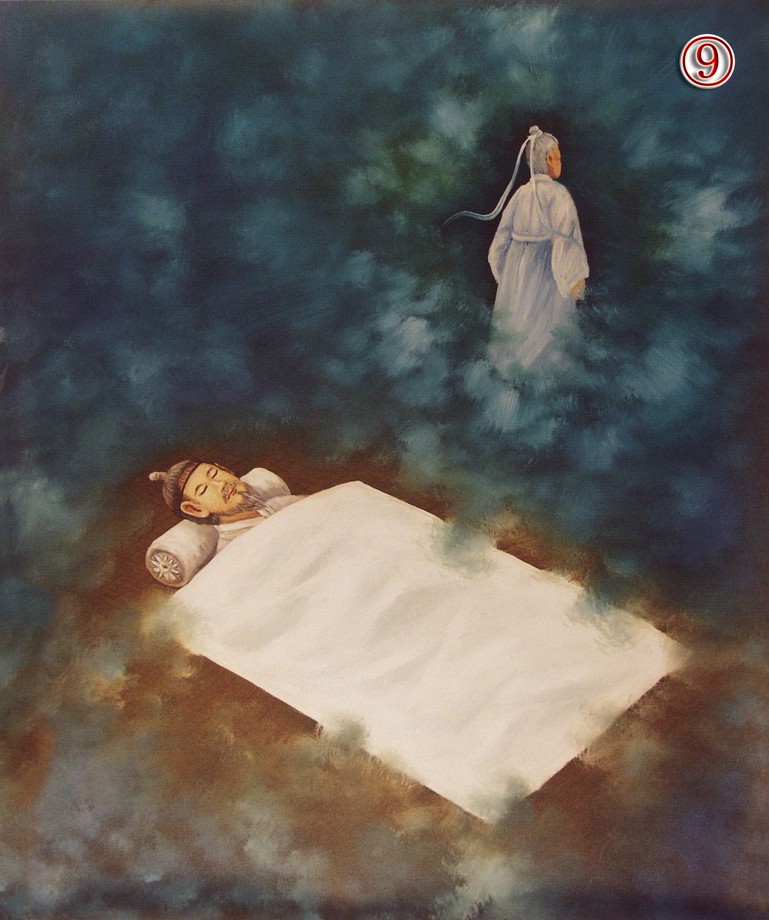
- ⑨ Sangje lectured to His followers, “The souls of those who have excelled in the cultivation of Dao will remain soundly concentrated even after death as they ascend to Heaven.
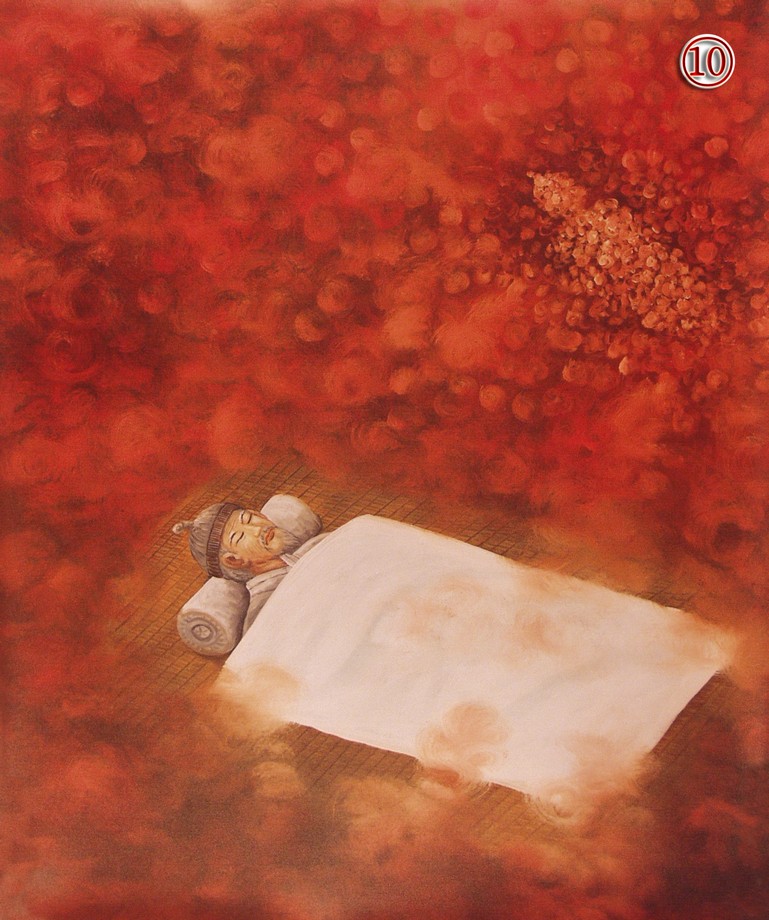
- ⑩ However, as for those who have not properly cultivated themselves, their souls would fade away like smoke and foam.”
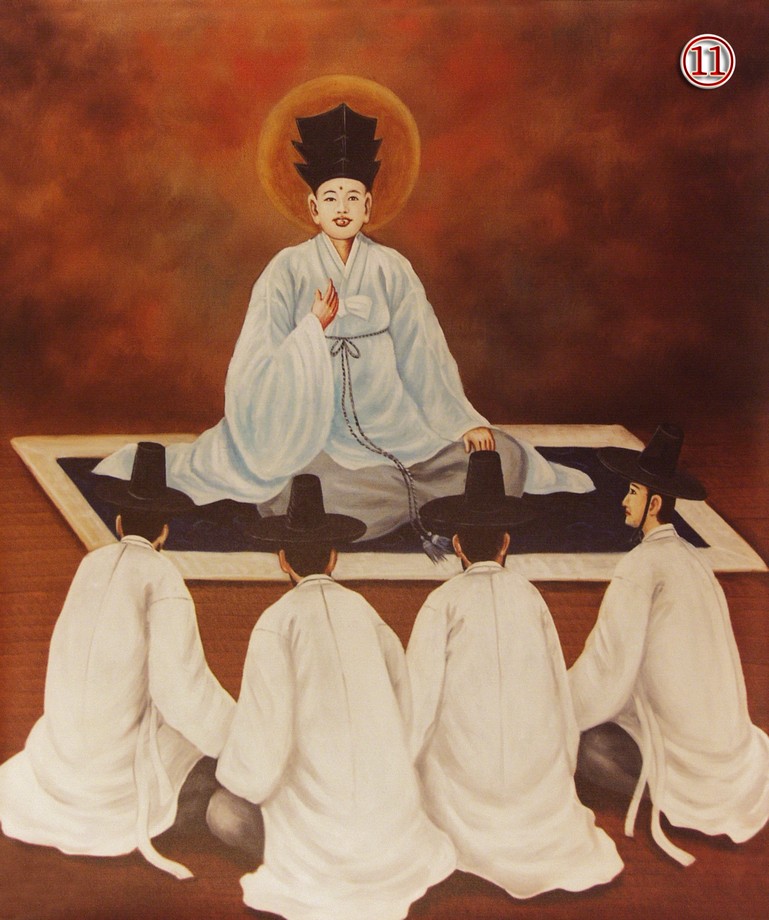
- ⑪ Sanjae said to some of His Dao cohorts, “The icon of Maitreya Buddha in Geumsansa Temple holds the cintamani (wish-fulfilling jewel) in his hands. I, on the other hand, hold it in My mouth.”
One day, Sangje said, “I am Maitreya. The 16-foot high golden icon (yukjang-geumshin 六丈金身) enshrined in the Maitreya Hall of Golden Mountain Temple (Geumsan-sa), held the Cintamani Stone (Wish-fulfilling Stone) with his hand, but I have one in My mouth.″ When Sangje showed His lower lip to His disciples, there was a red spot on its inside, and His countenance appeared to them as that of the golden icon of Maitreya at Golden Mountain Temple. Completing the picture, between His two eyebrows were white twinkling bead-shaped hairs (Baekhoju 白毫珠) and on His left palm was the character 壬 (Im) and on His right the character 戊 (Mu). 【Acts 2-16】
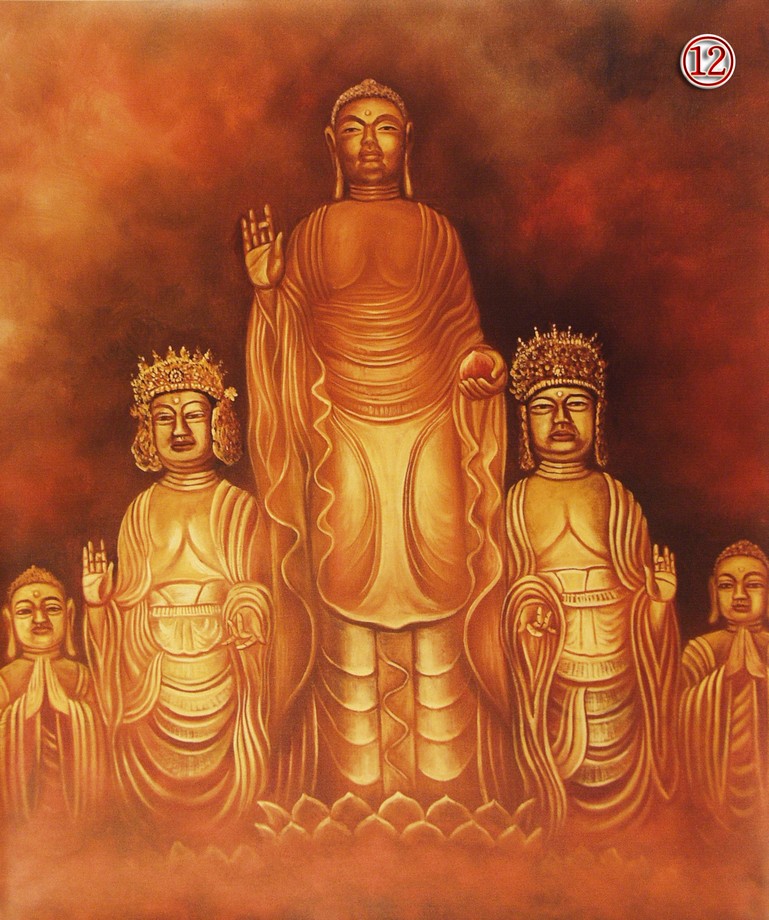
- ⑫ “If you wish to see me, look at the Maitreya Buddha in Geumsansa Temple.”
Sangje said, “I shall enter Golden Mountain Temple (Geumsan-sa). If you would like to see Me, come to the temple.″ 【Acts 5-29】
9. Opening of the Earthly Paradise
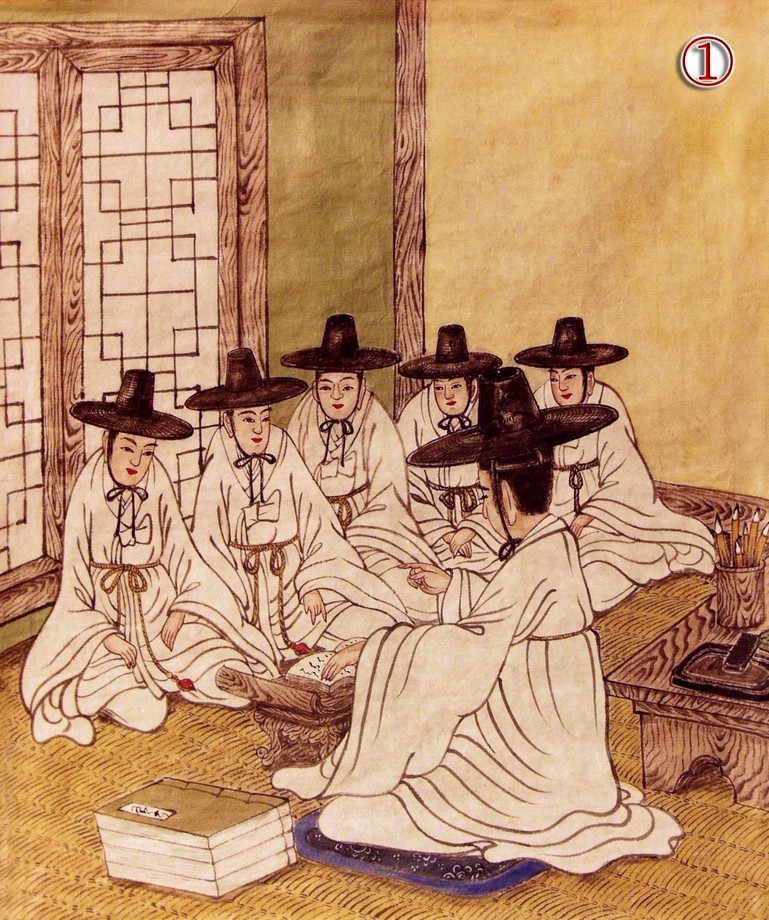
- ① In April of 1902 at Kim Hyeong-ryeol’s house Sangje said this will be the Reordering Work of Three Realms of Heaven, Earth, and Humanity.

- ② He stated, “We should not mimic what others have made, but create new things.”
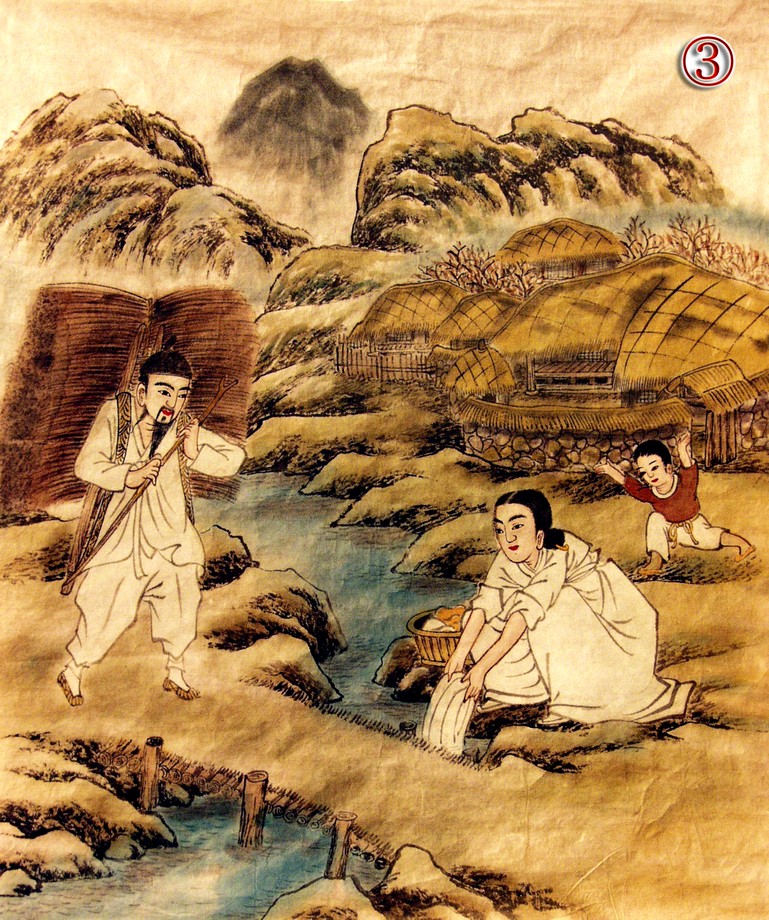
- ③ “For comparison, it is like walking on eggshells every time you use your parents’ assets.
Figuratively speaking, you have to gauge your parents’ mood whenever asking about their wealth even if the wealth is entirely the family’s.
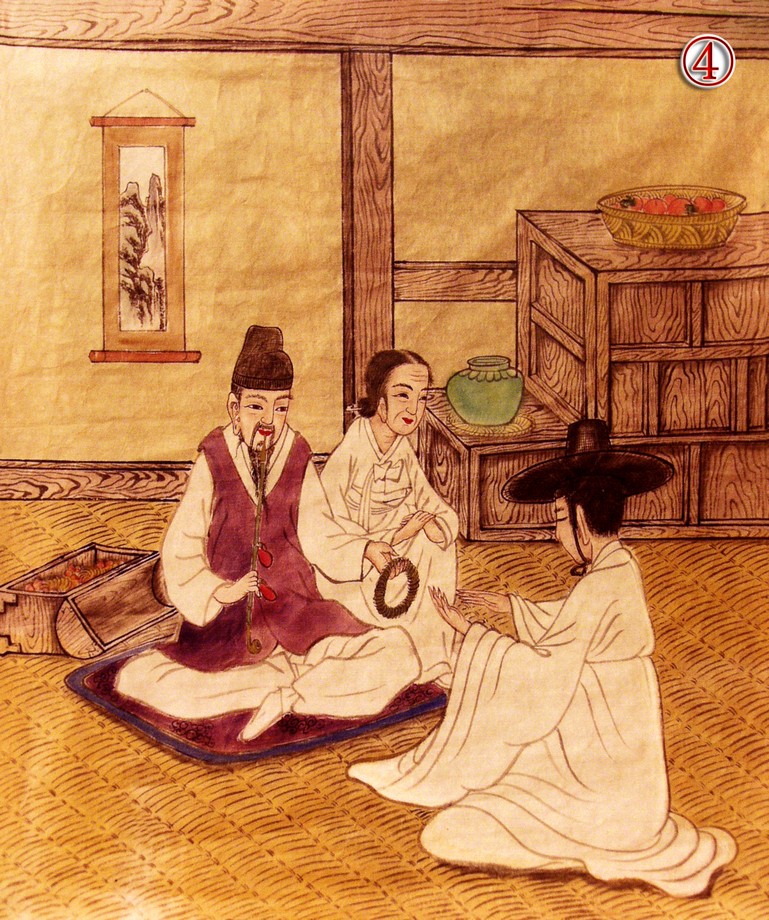
- ④ If you decided to keep living in an old house, you would live in fear that the house could fall down. Therefore, we should perform a great opening.”
In the fourth month of the following year, Sangje conducted a Reordering Work to greatly open the Three Realms of the World at Kim Hyeong-Ryeol's house. At that time, Sangje said to him, “We should not follow what others have done but start anew. Figuratively speaking, you have to gauge your parents' mood whenever asking about their wealth even if the wealth is entirely the family's. If you decided to keep living in an old house, you would live in fear that the house could fall down. Therefore, we should perform a Great Opening. My Reordering Works were unprecedented in the past and still are in the present; they were neither inherited from others nor do they belong to destiny; they are works that I make on My own. Presiding over the Three Realms with great power, I will recalibrate the Degree Number of the Former World and open the destined pathway to limitless divine immortality in the Later World to establish a paradise.″ Sangje added, “You should trust Me and work diligently towards this goal.″ 【Reordering Works 1-2】
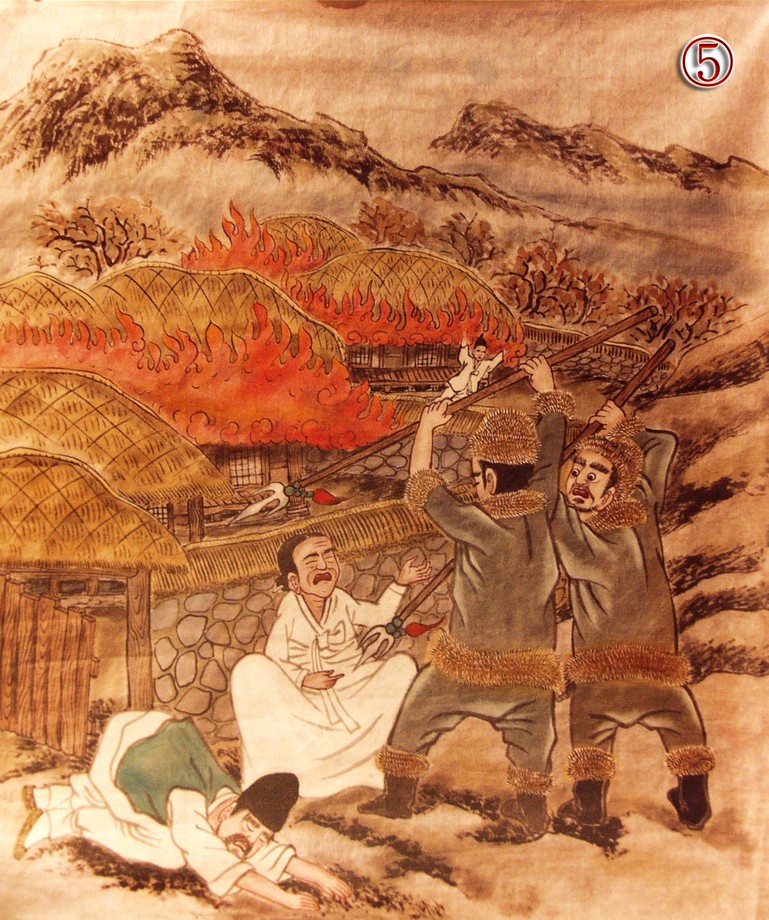
- ⑤ “In the Former World, all humans and matters were ruled by mutual contention and incompatibility. The world lost its morality due to an over-accumulation of resentments.
Sangje said to Kim Hyeong-Ryeol, “In the Former World, as all creations were ruled by the principle of mutual contention (sanggeuk 相克), grievances and grudges have been accumulating, condensing, and filling up the Three Realms. Heaven and Earth, losing the constant Dao, are overwhelmed with all kinds of disasters and calamities, and the world has fallen into wretchedness. To save all the people in the world, I will resolve the grievances and grudges accumulated from time immemorial by recalibrating the Degree Number of Heaven and Earth, harmonizing divine beings, and establishing the Later World's paradisiacal land of immortals which will be based on the principle of mutual beneficence (sangsaeng 相生). The grievances must be resolved by the Dao of gods in every small and large matter. If first I solidify and harmonize Degree Numbers, then human affairs shall naturally unfold in accordance with that action. This is indeed the Reordering Works of the Three Realms.″ Then Sangje undertook part of the Reordering Works of Myeongbu (the spirit world). 【Reordering Works 1-3】
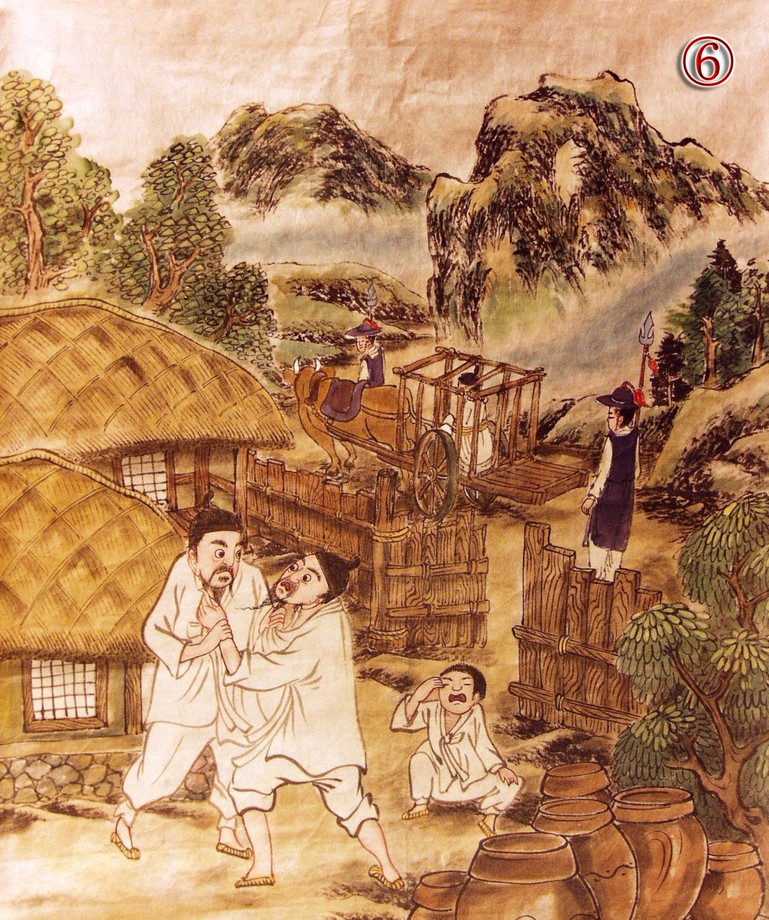
- ⑥ Various catastrophes and misfortunes occurred and the world became gruesome. Therefore, I will resolve all the grudges that have piled up for millions of years by presiding over the deities,
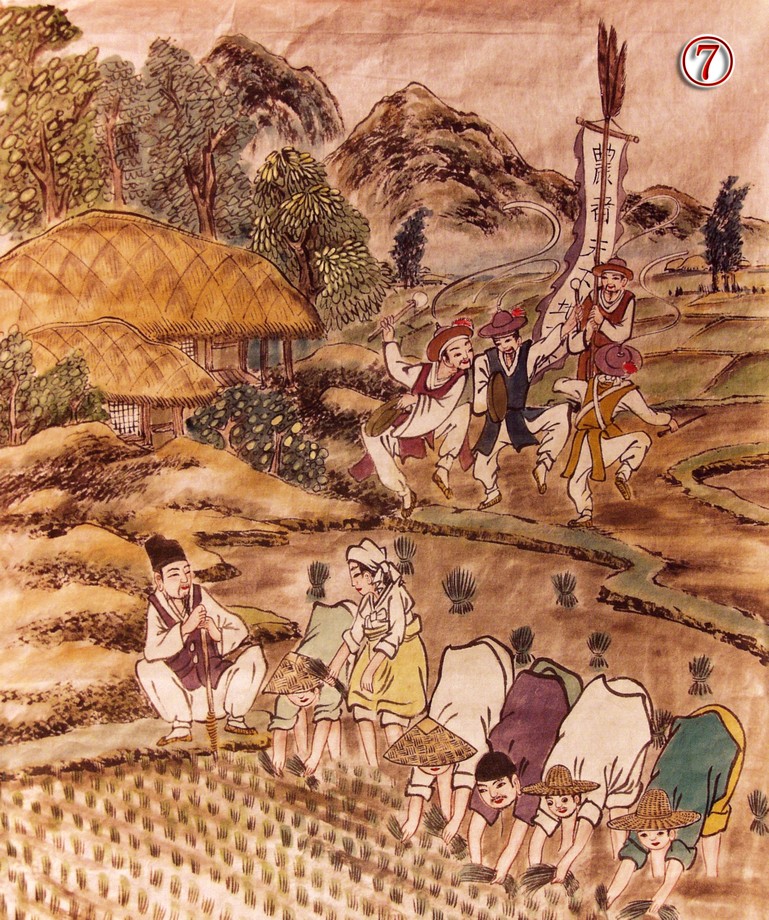
- ⑦ and through the principle of Mutual Beneficence, I will build the Earthly Paradise of the Later World to save humanity and divine beings.”
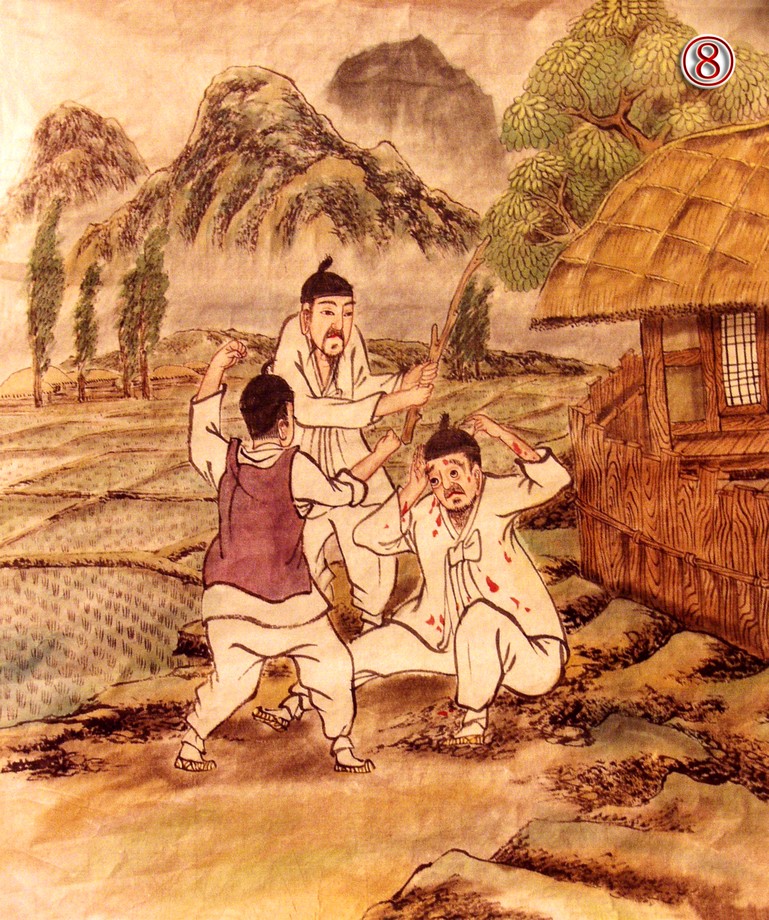
- ⑧ “To reorder the universe I am willing to renovate Heaven and Earth, and then renew human beings by rectifying their constitutions and personalities. Therefore, do not provoke Cheok (emotional grudges) from others but promote their betterment instead.”
As I have thoroughly woven the Degree Number by renovating both Heaven and Earth, a new foundation shall open to set the world on the right track. And I will have divine beings come into and out of people's hearts in order to change people's constitutions and characters and make use of them. This is because even a stake can be made useful when it is given energy. Feel at ease with the foolish, poor, humble, and weak and watch out for all the transgressions that might be committed by your mind, mouth, and will, and never provoke others into holding grudges against you. The rich, the noble, the wise, and the strong, who are all entangled in grudges, shall be plucked out by their roots. It is because a place filled with the old energy can hardly support a great destiny. A wealthy man's floors, rooms, and storerooms brim over with an aura of death and the threat of disaster. 【Dharma 3-4】
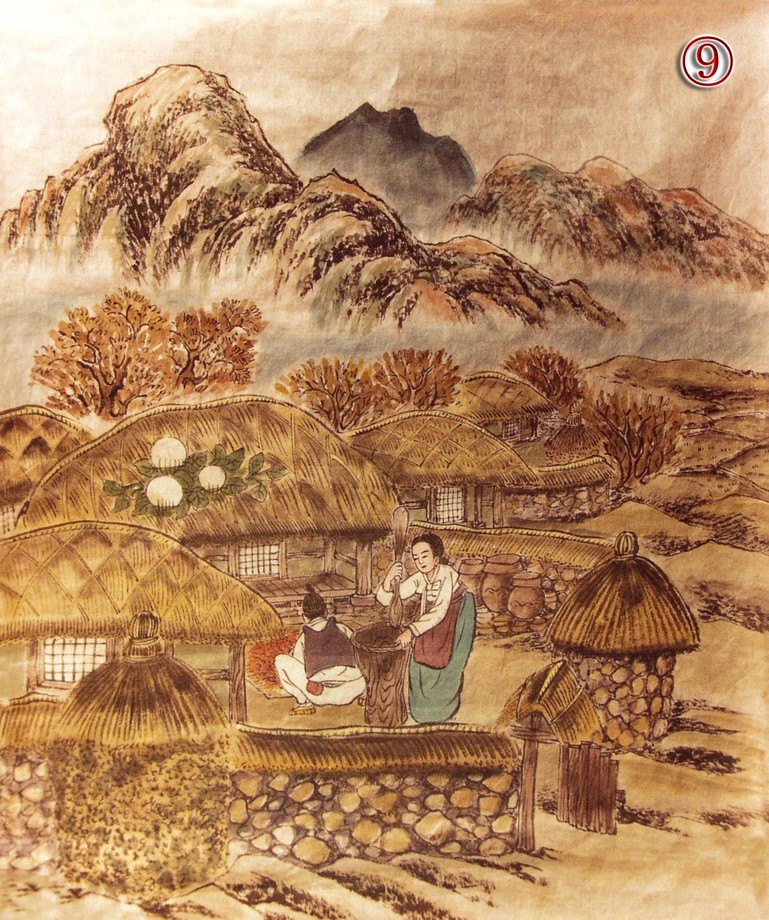
- ⑨ “In the Later World, all people will become one family. Authoritative, forceful, and punitive measures will not be used.
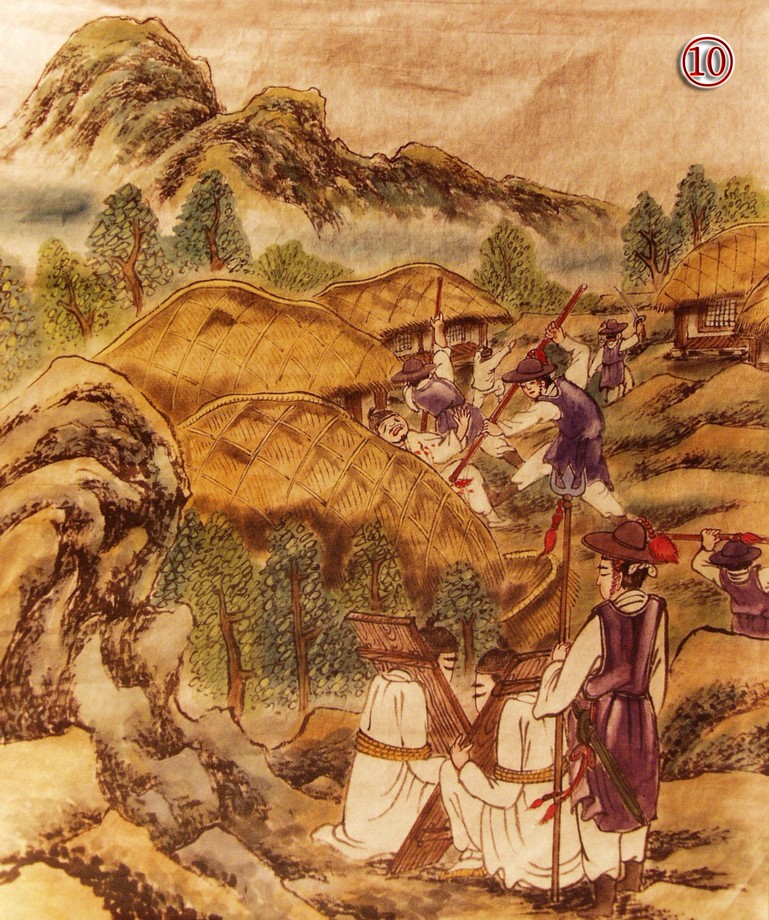
- ⑩ The public will not be anguished by enmity, resentment, avarice, or obscenities. There will be no gap between the rich and poor.
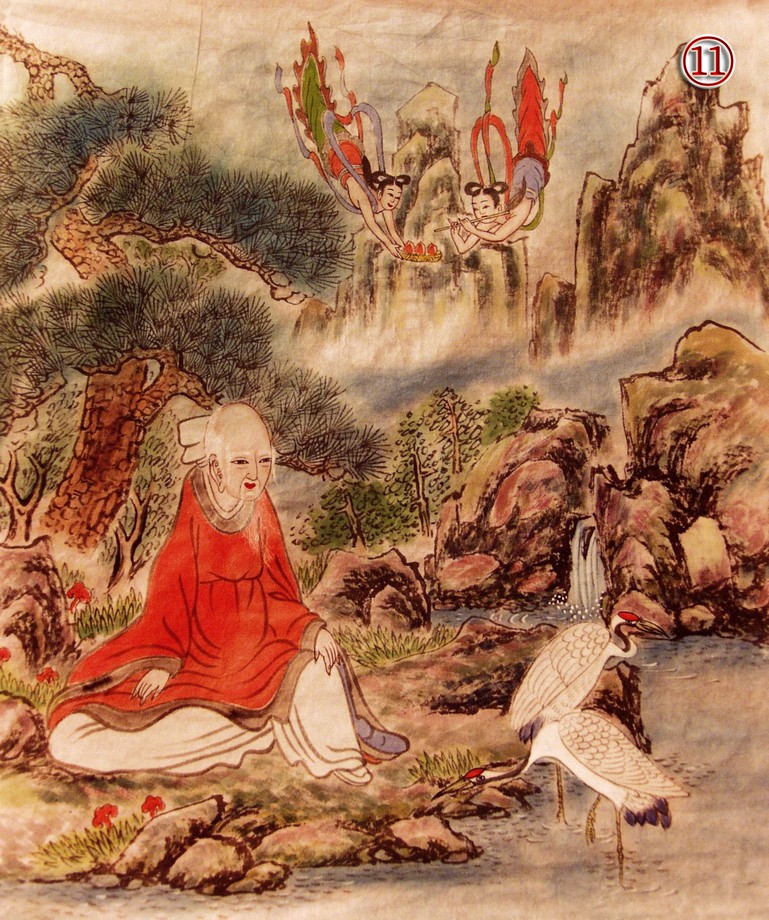
- ⑪ People would gain enlightenment and see into the past, present, future, and all other worlds.
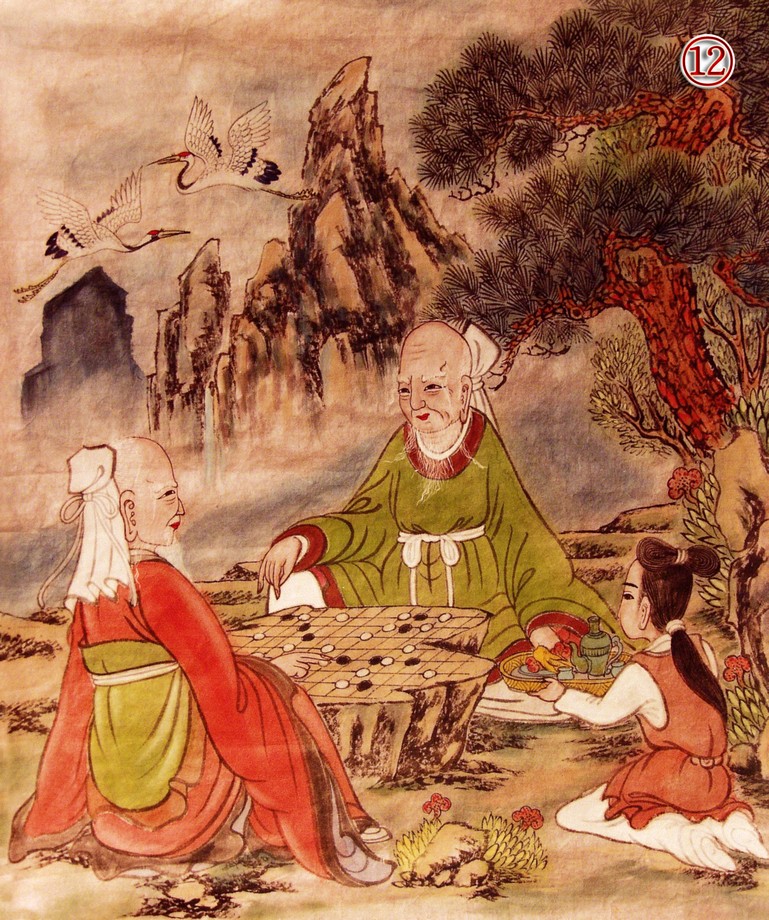
- ⑫ Calamities caused by water, fire, and wind will cease and the world will be transformed into an auspicious and prosperous Earthly Paradise.”
And Sangje said, “In the Later World, all people shall become one family. Through the art of creation, they shall be governed without force or punishment and according to laws and reason. Officials, naturally becoming more moderate and rational, shall not enjoy more authority than they deserve. People shall not be agonized by worldly desires or resentment. Also, free from disease, aching, death, and burial, they shall be given eternal youth and immortality. In addition, distinctions shall no longer exist between rich and poor. And people shall be able to travel anywhere freely and, moreover, ascend to and descend from Heaven due to its lowering. Their wisdom will be so thoroughly illuminated that they can completely know the past, present, and future and the worlds throughout the ten directions. The three disasters which resulted from water, fire, and wind shall disappear from the world. The Later World shall become an earthly paradisiacal land of immortals filled with auspiciousness.″ 【Prophetic Elucidations 81】
10. Founding of the Religious Body

- ① The holy founder, Doju, was born on the 4th of December (lunar calendar) in Hoemun-ri, Chilseo-myeon, Haman-gun, Gyungnam in the Jo family who had anti-Japanese sentiments. His honorific name is 'Jeong-san.'
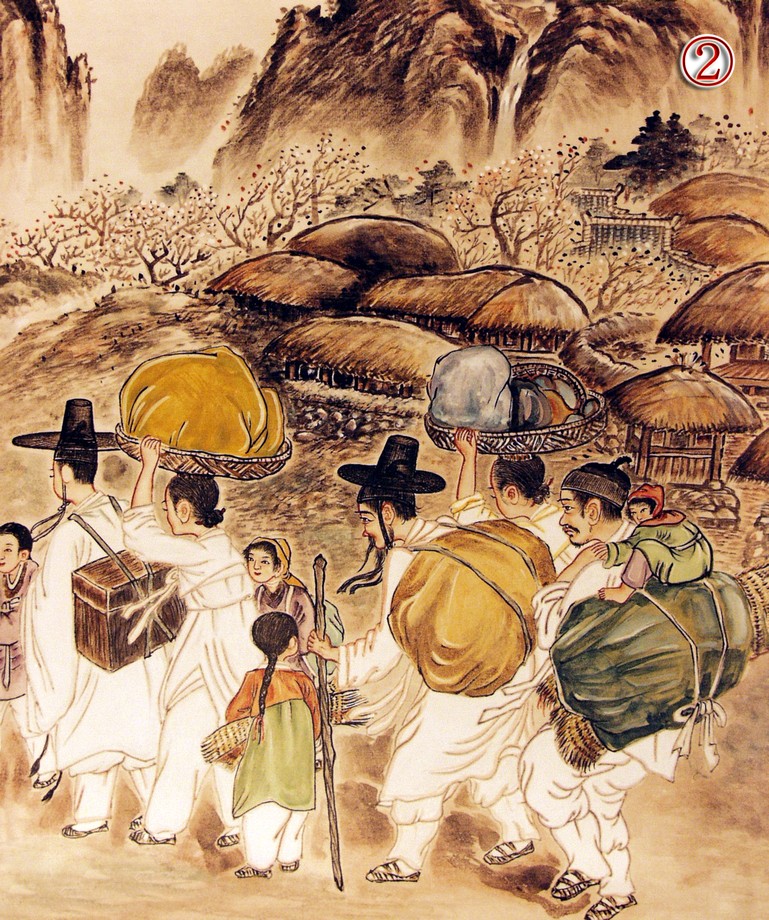
- ② When Jeong-san was fifteen, his family, whilst taking an active role in anti-Japanese campaigns, felt threatened during the time of the Korean-Japanese annexation. Therefore, on 28th of April 1909, the family sought asylum in Bongcheon, Manchuria.
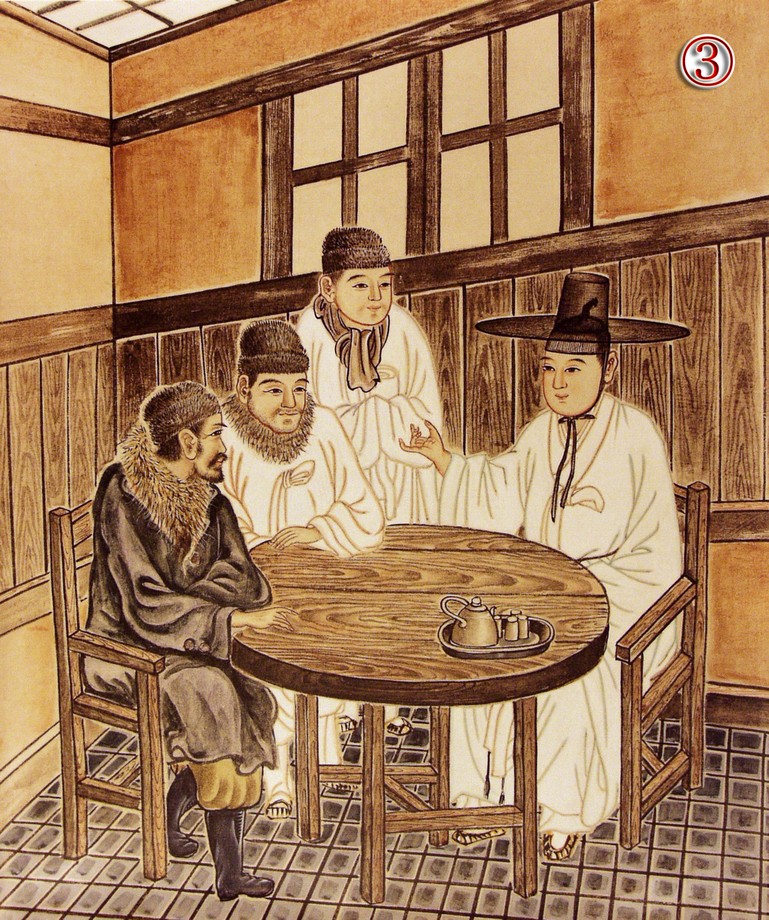
- ③ Whilst participating in the save-the-nation campaign with his comrades,
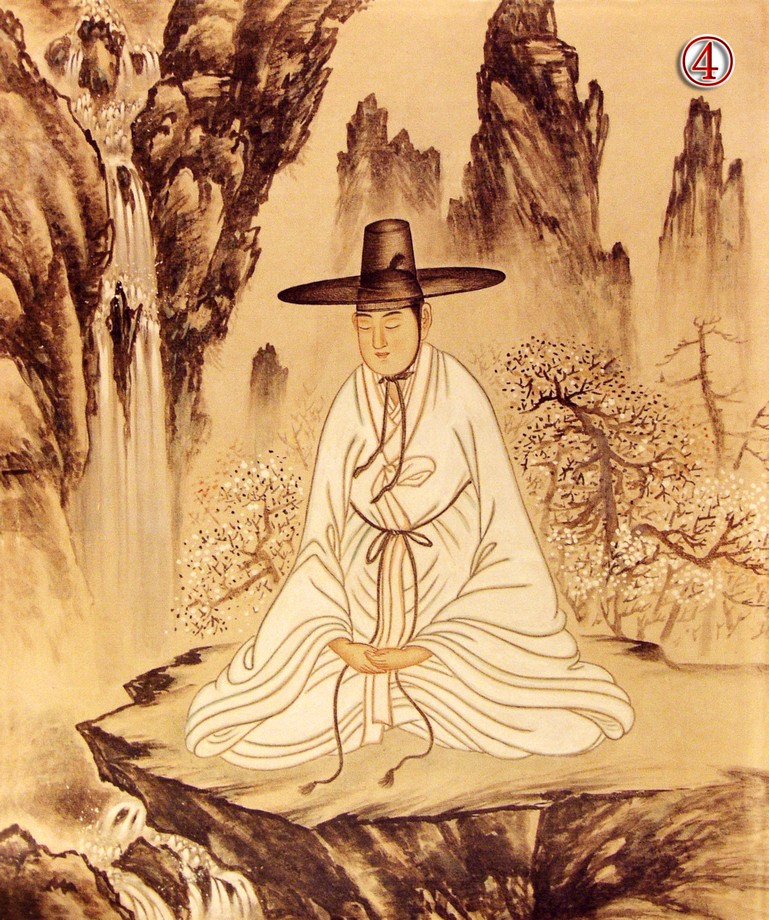
- ④ Doju decided to save the nation through the power of Dao. During his cultivation of Dao in the mountains, on the 10th of February 1917 at age of 23, he achieved spiritual enlightenment into Daesoonjinri (the Great Truth unfolded by Sangje).

- ⑤ Following the divine revelation given by Sangje Kang, he returned to his homeland through sea route after nine years of asylum.
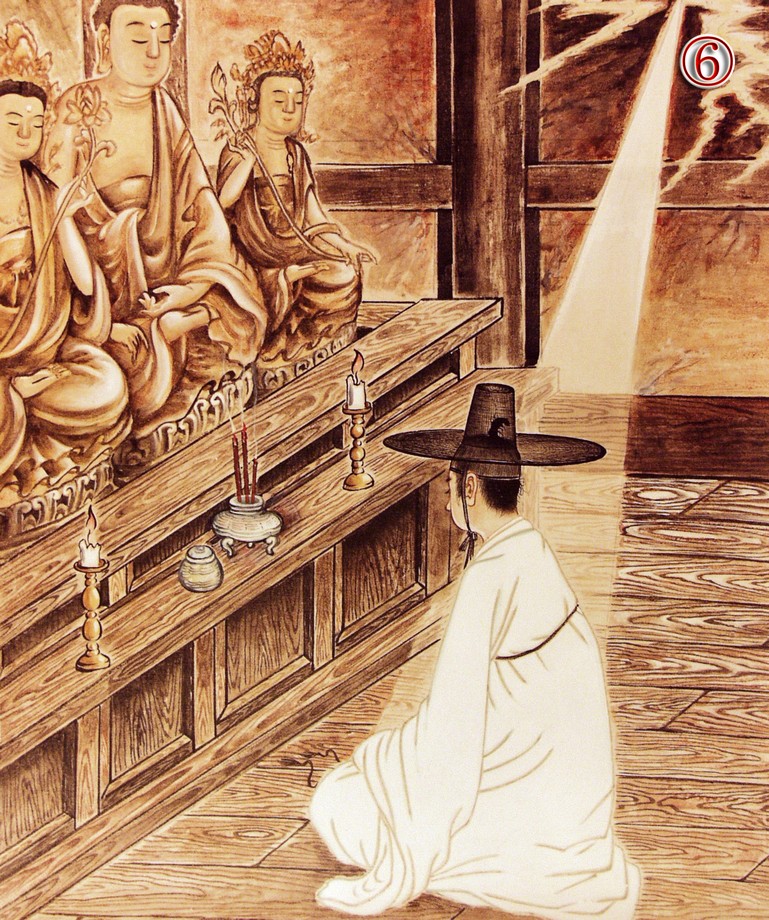
- ⑥ Doju travelled the splendid mountains and rivers cultivating himself in Dao.
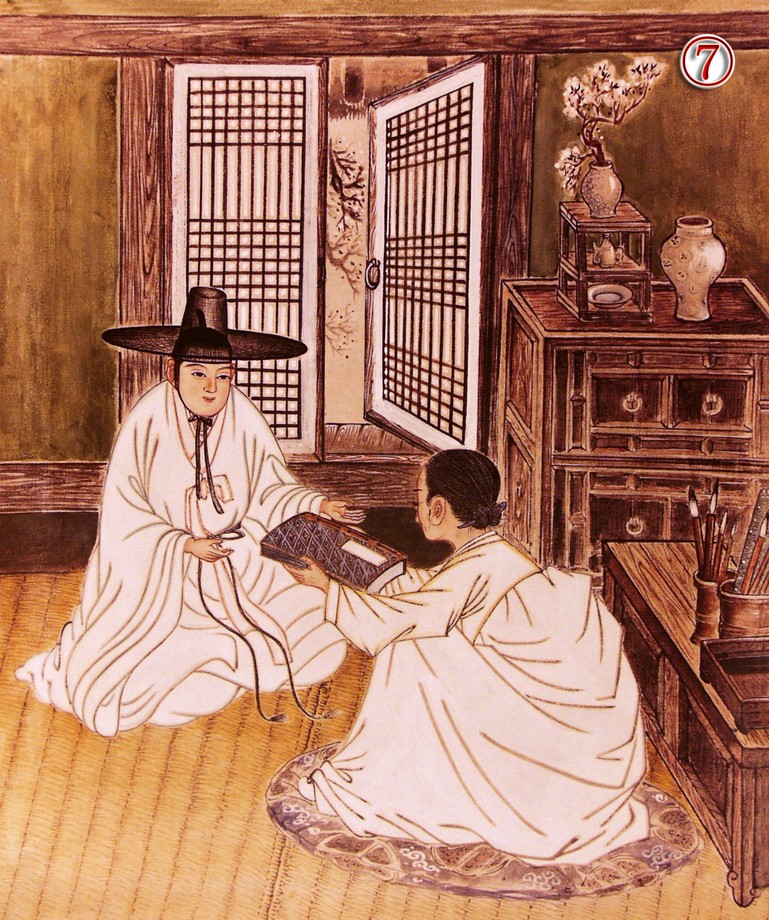
- ⑦ Then he went to the house of Kim Gi-bu in Ma-dong, Jeong-eup, Jeolla province and received a sealed letter from Madam Seondol, the younger sister of Sangje.
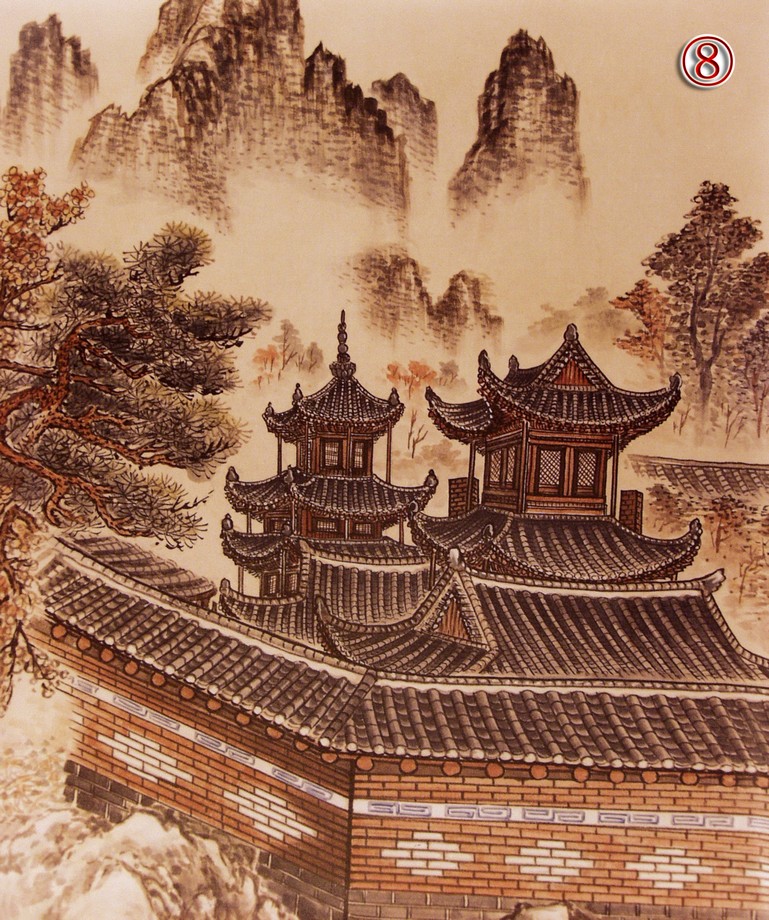
- ⑧ He established a temple complex in Dochang-hyeon, Gutae-in, Jeonbuk and started religious activities there. Although it had gained considerable popularity around the end of the Greater East Asia War, he ceased religious activities due to the Japanese dissolution act that affected religious groups.
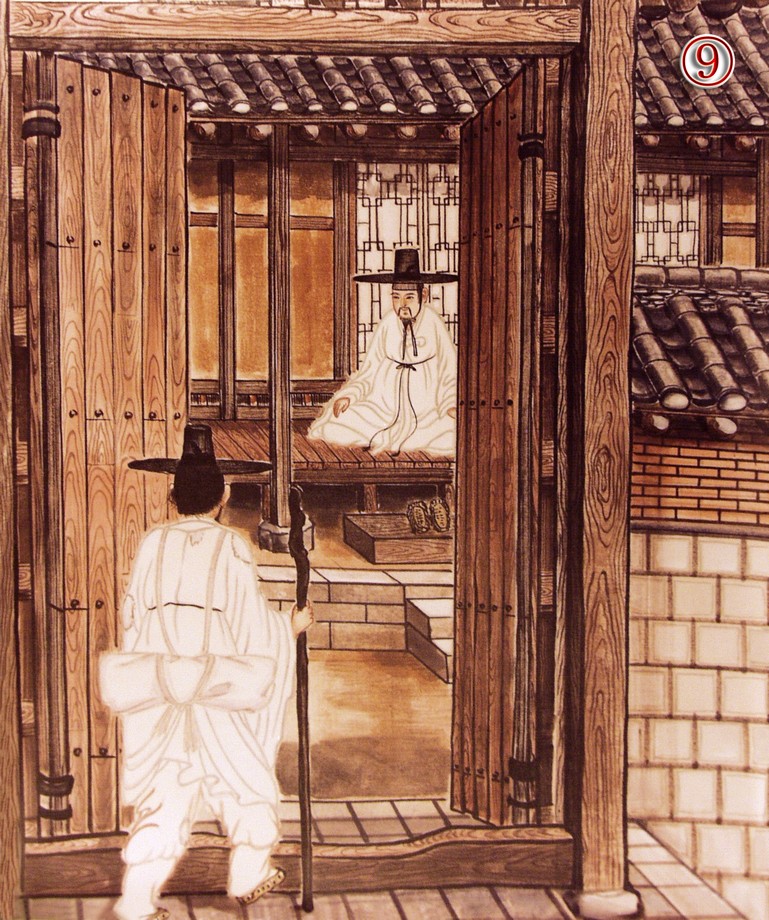
- ⑨ Doju established Hoeryongjae (a house built for memorial rites for ancestors) in his hometown, Hoemun-ri. And he made one of the executives keep in touch with other Dao cohorts to maintain communication.
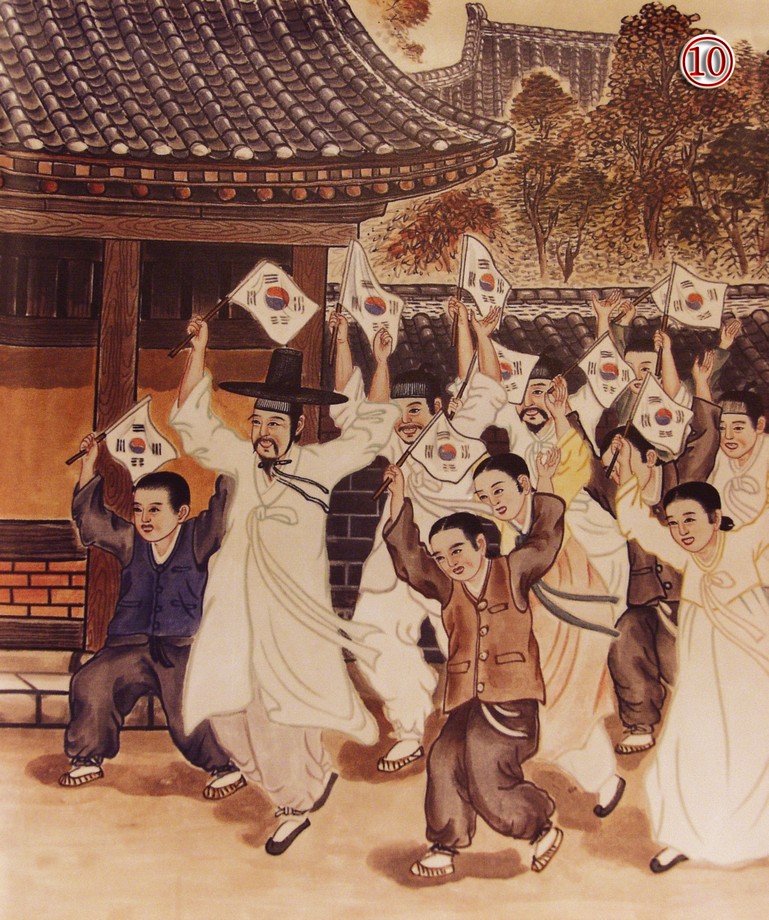
- ⑩ After the nation’s independence in 1945,

- ⑪ Doju established the headquarters temple complex in Busan, Gyungnam and resumed religious activities there.
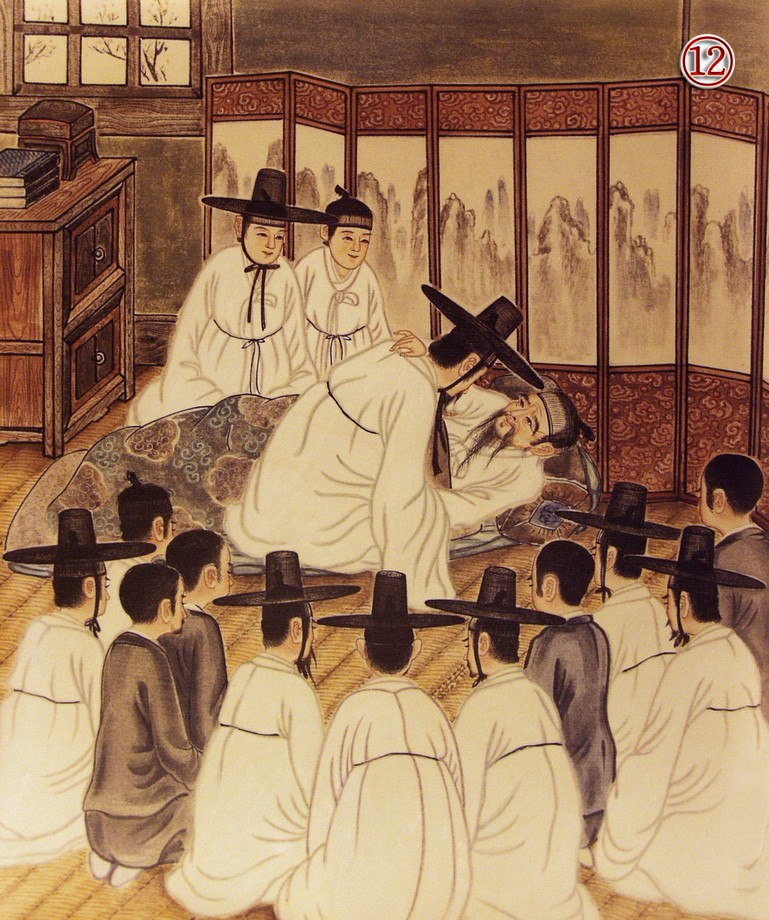
- ⑫ In April of 1958 at the age of sixty four, before many executives, he made a deathbed edict entrusting the management of the religious body to the present leader, Dojeon Park, and then he passed away.
The Road to Peace and Harmony
‘The Road to Peace and Harmony’ is a movie about the story of Sangje’s Reordering Works of Heaven and Earth, Doju Jo Jeongsan’s founding of a new religious body, and other such historical events. The story was developed by the film’s director, Kang Daejin, in 1982 and filming started in March of 1983 after organizing the Film's Production Committee. The committee included Professor Jang Byeong-gil of the Department of Religious Studies at Seoul National University and some executive members of Daesoon Jinrihoe. It starred Jeon Un as Sangje and Lee Sunjae as Doju; both of whom were top Korean movie stars. The movie was released in November of 1984 at Asia Theater in Seoul.
Address : 882, Gangcheon-ro, Gangcheon-myeon, Yeoju-si, Gyeonggi-do, Korea. Tel : 82-31-887-9301, Fax : 82-31-887-9345, Email : edaesoon@naver.com
COPYRIGHT(C) DAESOONJINRIHOE. ALL RIGHT RESERVED.
Related Sites :
-
 Museum of Daesoon Jinrihoe
Museum of Daesoon Jinrihoe
-
 DAEJIN UNIVERSITY
DAEJIN UNIVERSITY
-
 BUNDANG JESAENG HOSPITAL
BUNDANG JESAENG HOSPITAL
-
 DAESOONJINRIHOE WELFARE FOUNDATION
DAESOONJINRIHOE WELFARE FOUNDATION
-
 DAEJIN INTERNATIONAL VOLUNTEERS ASSOCIATION
DAEJIN INTERNATIONAL VOLUNTEERS ASSOCIATION
-
 THE DAESOON ACADEMY OF SCIENCES
THE DAESOON ACADEMY OF SCIENCES
-
 Daesoon Institute of Religion and Culture
Daesoon Institute of Religion and Culture
-
 DAEJIN HIGH SCHOOL
DAEJIN HIGH SCHOOL
-
 DAEJIN GIRL'S HIGH SCHOOL
DAEJIN GIRL'S HIGH SCHOOL
-
 DAEJIN DESIGN HIGH SCHOOL
DAEJIN DESIGN HIGH SCHOOL
-
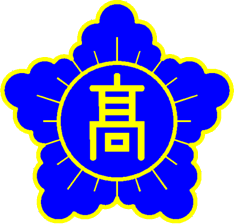 BUSAN DAEJIN HIGH SCHOOL
BUSAN DAEJIN HIGH SCHOOL
-
 ILSAN DAEJIN HIGH SCHOOL
ILSAN DAEJIN HIGH SCHOOL
-
 BUNDANG DAEJIN HIGH SCHOOL
BUNDANG DAEJIN HIGH SCHOOL
-
 THE DAESOON YOUTUBE
THE DAESOON YOUTUBE
![]() Museum of Daesoon Jinrihoe
Museum of Daesoon Jinrihoe